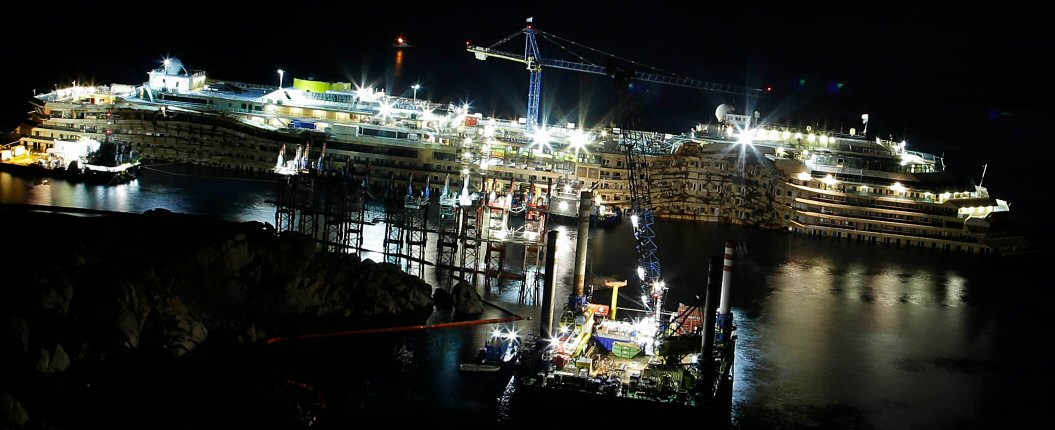
Why so
many passengers and crew died
Mini - mysteries
Discussion
How
did the passengers get off?
Ship
ended up extremely close to land
Swimmers
video interview
Nature
of the gash
Ship's
path
What
the hell happened?
Lying
to the passengers
Captain
(and other officers) --- Incompetent, cowardly, lying sonofabitch
(or is the captain taking a fall for Costa)?
Passenger stories
Timeline
Coast
Guard orders fleeing captain back to ship
Did
captain of sister ship, Serena, give abandon ship order?
Sailing close
to the island
Photos
Ship
pictures
Lifeboat
photos
Escape
via rope ladder -- infrared images
Ship
corridors
Map
of ship's path
Bow
stabilizer and gash
Ship's
final location
Lifeboat design
Titanic lifeboats
(an aside)
If
trapped inside, what are your options?
Carnival Corp cruise
lines
Fincantieri
shipbuilders
Costa Concordia
YouTube videos
Latest news
Idiot
company and CEO
Appendix
Carnival
cruise ship Triumph disabled by engine fire (214/13)
Sinking
of Korean ferry Sewol (4/17/14)
Captain Schettino sailing with the best technology available in the world, in good weather conditions, with perfect visibility and no traffic, in local waters on a route traveled regularly, on Jan 13, 2012 has put his ship against a rock that all sailors have known since Etruscan times. (Forum poster)
No doubt some (or many) of the deaths were due to passengers being lied to by the Costa (Carnival Corp) Cruise Line (for close to an hour!), told that it was only "electrical problem", "it's been resolved", no need to muster "go back to your cabin" (all well documented by passenger videos), when the bridge knew within minutes that the ship was taking on large amounts of water and everyone could feel the ship beginning to list.-------------------------------The Costa Concordia "grounding", as Carnival Corp calls it in its SEC filing, might very well be the largest financial loss in maritime history, and the fact that only about 1% of the people on board died was because the the ship, once it was stopped and turned, rolled over almost literally onto the island of Giglio, very close to its town harbor. All in all a pretty convincing demonstration that some of Micky Arison's Carnival Corp captains are totally incompetent."I am still furious about this. None of the lives should have been lost. If the passengers were told to go to your cabins and grab your life vest and go to the deck 4, which is where the boats are, then no life would have been lost. The ship’s improper communication and direction is why some of the passengers drowned in their cabin with their life vests on." (mayor of Salzburg Austria, Dr. Heinz Schaden, who was a passenger on the Costa Concordia)
Here's some
of the idiot things the captain and his lawyer said in his final plea to
the court before sentencing:
-- "I died along with the 32 others," captain said. (but thank goodness
I fell into that lifeboat so I didn't really die.)
-- "All the responsibility has been loaded on to me with no respect for the truth or for the memory of the victims," captain said. (To me this is the most outrageous of his his weaselly arguments. Basically he has killed all these people, but he wants the court to go easy on him out of respect for the 'memory of those who died'. How is this different from the old joke about the kid who kills his parents and then throws himself on the mercy of the court because he is an orphan?)
-- He said helmsman Jacob Rusli Bin allegedly did not understand English -- a language he was required to speak -- when Schettino gave the orders to turn the ship away from the island. Therefore, the attorney argued, Rusli Bin caused the accident -- not Schettino. (What? Is his lawyer saying the captain did not know how to communicate with the helmsman steering the ship? Or is this just the pathetic excuse that it appears to be? Apparently the court though so.)
-- Addressing the manslaughter charges, Pepe tried to bolster his argument that because no one died on impact when the ship slammed into the rocks, Schettino cannot be held liable. (This defence claim is downright bizarre. It's pretty clear that the captain lying to the passengers about the severity of the accident and telling them to go back to their cabins even though there was a huge gash in the ship that quickly flooded the engine room, caused many, if not most, of the deaths. And yet somehow the captain is not responsible for the lies the passengers were told that led directly to their deaths?)
-- "Stop for a minute to consider what would have happened if he had abandoned ship 1 kilometer from shore," Pepe said. "There could be 4,500 dead, not 32." (Ignoring the fact that there were only 4,229 passengers and crew on the ship (according to CNN), (Oh, yes quality lawyering!) this is another totally idiotic defence claim. First of all the debatable point is whether an earlier general evacuation of the pasengers and crew would have saved lives (as the prosecutors allege), not when and where the captain himself leaves the ship, so the defence argument is framed in a bizarre way.
Anybody who has looked at the pictures and video of the passengers and crew leaving the ship knows that most (90+%) left the ship in the ship's covered lifeboats. It likely have made little difference to them if the lifeboats had to go 3000 ft vs 300 ft. The 150 people or so that the captain abandoned on the rolled over ship were later mostly picked up by rescue boats from shore (after a harrowing climb down the side of the ship). The distance from shore would have affected directly only the relative handful of people who chose to jump in and swim to shore. As it was even with the ship this close to land some of those who attempted to swim to shore drowned. And, critically, an earlier evacuation before the ship had tilted so much might have allowed more of the high side lifeboats to launch. In fact a timeline (below) has the ship list at 20 degrees 45 minutes after the crash. This is critical because it means cross ship travel was possible for up to 45 minutes, passengers could get from lifeboats on one side to lifeboats on the other side, so an evacuation during this time would likely have been much more complete. As it was the captain waited 20 more minutes before calling an evacuation and by that time cross ship travel was totally impossible with the ship listing at 60 degrees. (Well 60 degrees was reported at the time, but photos show the list was much less than this when starboard lifeboats were launching!) Without all the facts in hand it does seem that the evacuation of the ship might have been delayed too long. By the time it was ordered, if you were inside the ship, there was a good chance you were going to die, because the list was rapidly increasing and the ship was sinking too. Look at photos showing how high the lifeboat deck normally is above the water, yet when the starboard lifeboats were launching the water was right up to the lifeboat deck. Eventually the list of the ship went up to 60 degeees then 90 degeees. Once list of a ship exceeds 30 degrees or so you can't climb up and if you go down you are likely to get trapped in water filled corridors and drown.
It might be that the 150 or so who could not get into lifeboats and were trapped on the ship for hours survived because the ship beached and didn't sink. But if most of the passengers had departed in lifeboats a km from shore what difference would it have made to those trapped on board? No difference if the captain and crew had remained on board had done what they did and steered the ship to shore. But sure if the captain had quickly fled without making an effort to bring the ship into shallow water many of those trapped on the ship might have died if the ship had quickly sunk or fully rolled over. So this defence argument amount to what, the captain could have made a bad situation even worse? Big deal, but I will grant that bringing the ship near shore does look like it might have saved lives of those trapped on the high side. Even here luck was involved, because the ship's recovery operation showed ship breaching was percarious that it could easily have slipped off the ledge it came to rest on and slid into deeper water.)
-- His lawyers had argued that it was a collective failure of the ship's crew and others should share the blame for the disaster. (Wait a minute, five others, most of them officiers on the ship, at this point had already pled guilty and been sentenced to a year or two in jail, so that doesn't count? And the cruise line paid a million euro fine too. But I suspect the captain's claim that the company bought their way out and are making him a scapegoat may have some merit.)
He was sentenced
by the court to 10 years for multiple manslaughter (killing over 30 passengers!)
by lying to passengers that the problem was only an electrical outage,
the ship was safe and to go back to their cabins. This outrageous lie killed
most of the passengers who got trapped in their cabins and drowned as the
ship listed more and more. The ship ran aground in 15 min after hitting
the rocks, but Schettino did not order an evacuation of the ship for more
than one hour. Lawyers for the state said every passenger and crew member
on board could have survived if Schettino had immediately ordered an evacuation.
Five more years of the sentence were for causing the wreck and one more
year for abandoning the passengers on the ship.
------------------------------------------------------------------------------------------------------------------------------------------------------------
Update 2/27/14
Costa Concordia
was briefly in the news today as its captain, apparently as part of his
trial proceeding, came back to the ship and was photographed on the righted
ship. It now 5 months since the ship was righted, and it's still right
where it was, sitting off the coast of Giglio. The headlines of the current
news stories are about whether the captain abandoned the ship. His lawyer
today is saying Costa Concordia line is (unfairly) blaming him.
What I want to hear him asked is why he concealed the serious damage to the ship, and far worse, he allowed, perhaps instructed, the crew to lie about what was wrong and its seriousness to the passengers. This undoubtedly contributed to many deaths as passengers were told it was not serious and to return to their cabins (clearly caught on tape), where many soon became trapped inside by the list of the ship with many later found dead in their cabins. Ask him about that!!
Five guilty so far
Five others made
plea deals and were convicted of manslaughter in summer 2013 with light
prison sentences. Four on the ship and the fifth is (apparently) a company
man. I don't know if this was the guy the captain was talking to on the
radio during the one hour or so the ship limped on, or whether he is some
guy who covered up later. Lawyers for the victims were dismayed by the
short sentences. The BBC omitted this little tidbit: "None are likely to
go to jail though as the sentences of less than two years are suspended,
and the longer sentences may be appealed or replaced with community service,
judicial sources said. (from Sky News)"
The cruise company Costa Crociere was given an administration fine of one million euros, which likely paled behind the payoffs to the passengers which are reported to be 14,000 euro each, which should total to 40-50 million euros. It would be interesting to know what the payoff was, if any, to the crew.
Here is the BBC describing the five convicted: "Two officers, the helmsman, the head of cabin service and the head of the crisis team were given up to two years and 10 months in jail for multiple manslaughter, negligence and shipwreck. The five defendants were Roberto Ferrarini, director of the Italian cruise company's crisis unit, cabin service director Manrico Giampedroni, first officer Ciro Ambrosio, Indonesian helmsman Jacob Rusli Bin and third officer Silvia Coronica. The heaviest sentence was given to Roberto Ferranini who was ashore as the disaster unfolded and in charge of co-ordinating the cruise ship company's response to the crisis. "It has also been revealed Schettino made a frantic telephone call to a senior company executive just after the incident. Sources said he told Roberto Ferrarini, Costa Cruises’ operations manager: ‘I’ve messed up. We have touched the bottom. We sailed past Giglio and we took a hit.’ (UK DailyMail).
"Grilled by a Senate committee in Rome today (26 gennaio 2012), Costa Crociere chief Pier Luigi Foschi said the company was misled by the luxury liner's captain about the scale of the disaster after it crashed into rocks off the island of Giglio. Foschi admitted however that the company - which is part of US industry leader Carnival Corp - did sometimes encourage its captains to sail close to the coast, saying the practice was "in demand" and "helps enrich the product". (Oh, yea)
"Foschi said Schettino first called Ferrarini about 10 minutes after the 17-deck Costa Concordia hit a rocky outcrop, tearing a massive gash in the hull. "Schettino said that he had a big problem on board. He told Ferrarini that he had hit a rock and there had been a blackout. The captain said that only one of the sealed chambers was flooded," Foschi told senators. In another call, Schettino told Ferrarini that a second sealed chamber was flooded "but said the stability of the ship was not in danger". Schettino "was very calm and said the situation was under control", he said. But 27 minutes later, Schettino said "the listing of the ship was increasing" and two minutes later he told Ferrarini that the ship would be abandoned. "Ferrarini says he was completely surprised by the abandonment of the ship. He says that judging from the previous telephone conversations he could not have understood that the situation was so extreme," Foschi said." (This begs the question of whether on a highly automated modern ship like this there isn't data from the ship automatically relayed to the company in real time.)

Update 9/16/13
The Costa
Concordia is back in the news today. It's 20 months since the accident
and the ship still lays off the coast of Giglio Island where it crashed,
but today, finally, after 14 months of preparatory work, the effort to
try and move the ship has begun. It's being broadcast live in Italy and
online, so far it has been pulled off the rocks and rotated 25 degrees
toward the vertical. (After 19 hours the ship was righted. Is now sitting
low in water on a platform, the starboard side showing huge damage.) The
plan after it is righted and the starboard side stabilized is to attach
steel caissons to both sides (all this will take months) and tow it away
to be cut up. "The salvage cost has increased to $799 million and could
rise further, according to Costa Cruises." (I'm glad the smucks who run
Carnival Cruises are taking a financial hit on this.)
"The ship’s captain, Francesco Schettino, is scheduled to go on trial this fall on charges of multiple manslaughter, causing a shipwreck and abandoning the vessel before everyone was safe." "A company official and four crew members have already pleaded guilty to reduced charges." (have seen no details on the guilty pleas) Two of the bodies were never recovered, they may still be in the ship.
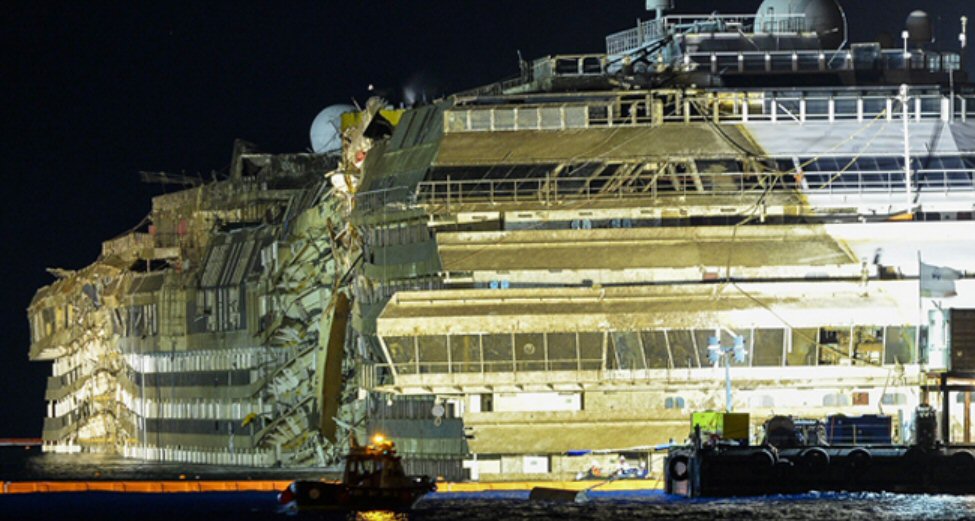
Costa Concordia salvage continues off Giglio Island
huge damage visible on starboard side where the ship
has been lying on reef

Ship just righted, sitting low in water on platform
(Sept 17, 2013)
Cosa Concordia specs
Length x width
957 ft (290 m) x 119 ft (36 m)
Decks
17
Draft
26 ft (8 m)
Weight
114,000 metric tons
Engines
Wartsila 12-cylinder, 12,000 Kw (main engine)
Wartsila, 8,000 Kw (aux diesel generators)
Constructed
Fincantieri Sestri Ponente, Italy (2006)
Passengers
3,800
Crew
1,100
Lifeboats (side)
26 (photo count)
Lifeboat length
41 ft (est from photo)
Lifeboat capacity (min)
185 (21 x 9) = 4,800/26 calculated
Costa Concordia is Vista class, Panamax cruise ship (meaning it fits (barely) into the Panama canal) built by Fincantieri in Italy. It is one of many nearly identical ships built by the same builder for many different cruise lines. These boats are very high, yet have a very shallow draft (26 ft). They look topheavy, but knowledgable people say they are quite stable as the upper decks are airy and the heavy engines are down deep.
Why
so many passengers and crew died
I think the
answer is the rapid tilt of the ship trapped dozens of people inside. I
have not seen a timeline of the ship's tilt, but from nighttime video it
is known that well over a hundred people remained on the ship when it was
nearly rolled on its side at an angle of about 80 degrees.
Most of the bodies have now been found and repeatedly they are found inside the ship with lifejackets on. I think there can be little doubt that the reason they died was that, as instructed by Micky Arison's minions, they went to their cabin, perhaps to get a life jacket, and then got trapped by the tilt of the ship. In this ship, as most cruise ships, it is nearly impossible to get from inside the ship to the high side lifeboat desk once the tilt of the ship reaches 30 degrees or more. Even walking in a fore/aft corridor (partly on walls) would be difficult since open doors would be a huge problem, but upon reaching one of the few ship side-to-side corridors, now titled up/down 30+ degrees, what do you do? Without continuous handrails, which this ship and most cruise ships do not have, trying to walk or pull yourself up a 30+ degree angled corridor is nearly impossible. Of course, you could slide down, but that's taking you toward the water as that side of the ship is either already in the water or soon will be, and you will likely drown.
(update July 22, 2012)
8 Bodies found underwater at starboard lifeboat deck
A miniature
submarine sent down to the starboard lifeboat deck, now underwater, discovered
8 bodies down there. A long article on the Costa Concordia in July 2012
Newsweek issue speculates that these passengers were waiting for a lifeboat
to come back to pick them up. Maybe that's right, and I would add that
when the list of the ship got so bad that they were about to go underwater,
they discovered no doubt that they were now trapped. The corridors (with
their partial handrails) running across the ship were at that point probably
too steep to climb. I submitted a letter to the editor (below) to Newsweek
suggesting my idea for a tilting plate 'safety corridor' to tie the two
lifeboat desks together.
If the Costa Concordia had included a 'safety corridor' across the ship, many of those who died on the ship might have been saved. The idea is simple. Tie together the two lifeboat decks with a dedicated corridor that has floor made up of plates about 1 foot wide that rotate to stay level with earth (perhaps driven by weights). As a ship begins to list, the flat floor turns into a stairway, a gentle rise at first, steepening as the ship's list increases. Even if the ship rolls to 90 degrees, it can still be transversed because it becomes a ladder. A typical cruise ship corridor angled upward at 20 to 30 degrees can't be climbed, you can only go down toward the water. Ship builders could easily build a 'safety corridor' into new cruise ships if cruise owners like Micky Arison would agree to pay a little more for safety. (submitted as a letter to Newsweek, letters@newsweek.com 7/22/12)Mini - mysteries
Ans --- From pictures below it can be seen that 23 of 26 lifeboats were eventually launched as they are in the Giglio harbor. 3 lifeboats are still on the ship on the high port side. Because the ship was 500 passengers below its design capacity, 23 lifeboats at capacity were sufficient. The pictures also show the starboard lifeboats were not launched until the ship had listed substantially to starboard.Can the crazy and/or cowardly antics of the captain post-crash ('I fell into a lifeboat', orders desert for his girlfriend) be part of a deal he made with Costa while on the phone with them for an hour? In other words is Costa Cruise Line paying him off to shift all the blame away from them? His career was kaput anyway. This is being speculated about in cruise forums.However, infrared video (below) shows with the ship fully rolled over on its side 50 - 150 people were still on board and had made it to the port side, and they were not leaving ship via launched lifeboats, but by climbing down a rope ladder to the water line. This explains how some people got to the water line where either they got picked up by a rescue craft (one is visible in video) or to swim.
Ans --- A fairly strong circumstantial case can be made that the apparently crazy actions and claims of the caption after the crash my be intended to limit blame being placed on the Costa Line, and this may be the result of Costa (in effect) paying off the captain to take all the blame.Did nearly the entire officer corp leave the ship with hundreds of passengers still on board a (potentially) sinking ship?
Ans --- Sure looks like it. The assistant mayor of Giglio went out to the ship and boarded it fairly soon after the ship came to rest and stayed to 5:00 am. He reports passengers on the ship and no one on the bridge. In his hours on the ship the only officers he came across were one very junior officer and the ship's doctor. The 2nd and 3rd officer are known to have left in the same lifeboat with the captain. There is no evidence the caption returned to the ship even though he was ordered to do so by the Coast Guard, even though he (eventually) told them he would return.How did passengers get into the water? How many? Did they jump 50 feet or wait until the ship listed way over so they could just walk in? To where did they swim, how many of these died? A rocky outcrop was only 100 to 200 feet from the ship, but was this a death trap with waves likely to slam you up against the rocks or could you climb onto these rocks from the sea?
Ans --- Some passengers got into the water via a rope ladder. The Coast Guard caption told the captain of the Costa Concordia to use a rope ladder he could see passengers using to leave the ship to reboard the ship. No one seems to ever have asked a swimmer where they swam to. Pictures show very little white water near the rocks, and in some places the rocks do slope gently into the water.How does the side of a flat ship get torn open? Why didn't the stabilizer fin sticking way out near the front of the ship hit the rocks? Was the ship actually turning into the island at the time the port side hit the rocks? Were the charts on board at the point of impact accurate or not? Captain says no, Costa says yes. No one has made the evidence available. Did the ship have sonar or underwater cmeras?From interviews some passengers swam from the starboard side when the ship had listed so far that the starboard lifeboat deck began to go into the water. A man who swam from the starboard was interviewed (in English), and he said when the water began to come up around their ankles he said "we're out of here", and he and his wife jumped into the water kicking hard because he was afraid the ship would come down on them. He estimates he swam 80 meters, and said clearly he climbed up onto the rocks he reached. (This sounds like a direct swim to the land projection (at least in some spots) was OK, that you could get out.)
Three bodies were found in the waters near the ship in the first hours after the accident' since then the rest of the victims have all been found inside the Concordia,
One Italian coast guard officer said they pulled 100 people out of the water. A passenger couple said when they got up on deck all the lifeboats were gone and they estimated 600 passengers were still on board (but I don't know how they could know this). One 60's couple went into the water together. The wife who couldn't swim was terrified, but held afloat by her life jacket managed to get ashore. Her husband who encouraged her to go into the water and who could swim is missing, so here very likely is a swim death. We can also read into this that no lifeboats were available. (Don't know which side of the ship this was from. It may have been early from the starboard side, whereas later with the ship now fully rolled over rescue craft can be seen near the port side rope ladder.)
Infrared video of the whole ship taken by Italian Coast Guard shows maybe 50-150 people on the port side of the nearly rolled over ship. There is only rope ladder visible down to the water line. One rescue boat is briefly visible near the ladder, and they throw a liferaft into the sea toward the ladder. This could explain the statement that the coast guard pulled 100 people from the water. At the end of the ladder people may have had to jump into the water and swim 20 feet to a rescue boat or raft. Anyone who swam from this ladder had a much longer swim than from the starboard side, since this side of the ship faces seaward, they would have to swim around the ship.
Ans --- The bow stabilizer is right in line with the mid-ship gash, yet the bow stabilizer was not damaged. The only way I can see this to be possible is that the ship had to have been was turning left to get closer to the island and town harbor just as it was passing the rocky outcrop.Why are passengers repeatedly lied to and lied to for a full 45 min after water started pouring in! There is video of those at a muster station 45 minutes after the crash (at 10:30 pm) being told the problem has been resolved and to go back to their cabins.Reading about the propulsion system of this ship I see another way. This ship was driven by 360 degree rotating propeller pods (see picture below). As the ship was heading in to hug the island shore, it might have had its pods at an angle, then the ship would not only have had forward motion, but also motion sideways toward port.
Ans --- Costa (Carnival) Cruise lines are a bunch of bastards. Everyone heard and felt the crash, the water is pouring in. Transcripts have captain tells Costa management 10-15 minutes after crash that two sections are flooding, the ship is listing and video exists of passengers being told (in the name of the captain) as late as 45 minutes later that the problem is solved, feel free to go the lounge or back to your cabins (to go to bed). This could have been (and very likely was in some cases) a death sentence by a totally irresponsible company.
What will the ship's black box show?
Ans --- I find this on a travel site
-- On board also are Simplified-VDR: modular fully equipped Simplified Voyage Data Recorder that is type approved with fixed capsules as well as float free alternatives. Well, the black box or VDR of Costa Concordia is broken. And it seems it was broken since weeks. (1/24/12)Yikes, allowing for the translation issues, this report appears to be saying that not only was the ship's black box not working, but that it had not been working for some time! If this is true, then Costa Cuise Lines (? by extension their owner Carnival Cruise Lines) is some company. Searching Google news I find this is indeed what is being reported in the Italian press, and get this, it comes from Captain Schettino. He said in his testimony it had been broken for 15 days (that's two weekly trips ladies and gentlemen). Reuters titled their article on this, "How the cruise ship industry sails under the radar". This is a very convenient failure for the Costa line. Did they possibly do something to insure it would be found 'broken').
How did
the passengers get off?
After reading
news accounts and looking at a lot of pictures, I am unclear how nearly
all the passengers got off the ship. I read that lifeboats along each side
need to have the capacity for half the passengers and crew and that rafts
to hold 25% additional also be available. The ship had on board 4,200 people
vs its design capacity of 4,800.
What I don't understand is this. The line owner says the lifeboat on one side could not be used, and consistent with that there is a picture of the ship listing moderately toward starboard with a lot of passengers still on board. The picture shows at that time none of the lifeboats on that side of the ship have been launched. Pictures taken with ship totally rolled to its side show only 10 of the 13 port lifeboats were launched, you can see 3 are still there. So if only 10 of 26 lifeboats got used, how did everybody get off? I have no one address this issue. The starboard lifeboats, if they are still there, cannot be seen now because they are underwater.
One passenger on video said 600 were still left on the ship after all the lifeboats were gone. In the infrared photo below dozens of people can be seen queing up to go down a rope ladder with the ship rolled all the way over to starboard. This photo confirms many passengers were unable to get off the ship via launched lifeboats. Only 30 or so were reported pulled off the ship by helicopter.
-- In the wake of the Titanic disaster, maritime regulations make it mandatory for all ships to have a minimum of 125 percent lifeboat and life raft capacity, comprising 50 percent on each side of the ship plus an additional 25 percent available.From the above comment maybe all the starboard boats did launch (can't tell from photos because starboard side is underwater), and the problem Costa refers to is that 3 of 13 'high side' port boats didn't get away?-- "The whole point of the Titanic regulations was to avoid what happened with her, and it has now happened again with Costa - that is, the difficulty, if not impossibility, of launching lifeboats from the 'high side,'" Dalby said, referring to the side of the boat tipped into the air.
Ship
ended up extremely close to land
I have seen
no one really point out how incredible close to land the ship ended up.
The ship is about 1,000 ft long, so from the photos it can been seen it
is about 100 ft (!) from a rocky outcrop. Now this is after the ship rolled
on its side, the ship is 120 ft wide so it may have been 150-200 feet from
land while listing.
I went into Google Earth and it shows the rocky outcrop is part of the mainland and in fact from the outcrop it is 1/4th mile to the town and there is a house within 800 ft. But, so what. First, was the ship at this time lit could people see how close there were? The answer from the photo is yes they probably could because the listing ship is shown lit up, so the shore was probably visible. It's reported that people did jump in the water and swim, but I have seen no estimate as to how many attempted to swim.
A key point, which I have seen nobody address, is whether it was possible to get up onto the rocks from the sea. I am familiar with the coastline of ME where for miles rocks jut into the sea. Being close to this ME rocks would not save you. Not only in most places could you not get up onto the rocks, the action of the waves (here sea was reported calm) would likely throw you into the rocks and kill you. And remember this is night, the shore is probably only faintly lit from the ship. So where did people swim toward? The town which is about 1/4 mile away. Incredibly nobody seems to have asked this of the passenger who swam.
A report from the Italian Coast Guard is that they picked 100 people out of the water. This would indicate that a lot of people did attempt the swim and were probably swimming a considerable distance. Swimming here would have been a bitch. While it's the Metterian, it is Jan. The air temperature was reported to be 45F and the sea temperature upper 50, very cold. Tables show this water temperature will incapacate you in an hour. So did people strip down in 45 weather and jump in.
Another key point no one ever asks the swimmers about is how did they get into the water. Until the ship was nearly fully rolled over jumping from the deck to the sea would be a huge, high jump, (into cold water) that could easily kill you. Maybe this is where a lot of the missing passengers are. I read that soon after the crash three of the dead were pulled from the sea. I also read that some passengers had water around their feet. So did they wait until the ship had rolled nearly all the way over so they could easily get into the sea. This has it own terrible risk, that the ship after you go in would continue to roll and end up on top of you. Also the passengers have no way of knowing if the ship is going to go down, so waiting until it rolls over must have been terrifying and incredibly risky.
Swimmers video
interview (update 2/6/12)
I found the
video below where a British newspaper talks with four british (or american)
passengers who swam, and this answers some of my swim questions. These
four tell of six more people who swam near them, and one woman says she
thinks 100 people started swimming. Here are some relevant points:
* All these
swimmer left from starboard side, apparently as lifeboat deck was beginning
to go underwater and there were either no starboard lifeboats remaining
(or no starboard lifeboats that weren't being mobbed).
* One man
said that when the water got up to his ankles (he was probably near the
stern) he figured he had to get out of there.
* Three said
they couldn't get into a filled lifeboat, but it promised to return for
them, but the ship was continuing to list, so they decided to swim. They
estimated they swam about 100 meters and climbed out onto the rocks.
* In the water
two people said they kicked hard because they could see the ship moving,
tilting more and more, and were afraid it could fall on them or trap them.
Nature of the gash
Staring at
the pictures of the gash bring up a lot of questions. The gash occurs in
the middle of the ship. How did this happen since the side of the ship
is totally flat? Was the ship pulled toward land by currents, or was the
ship actually heading toward land at the time of impact? Look at the relationship
between the huge rock in the gash and the front stabilizer. The stabilizer
is toward the front of the ship and nearly in line (as best as you can
see) with the big rock. What? How did the stabilizer clear the rock, which
it did it is undamaged, and the side of the ship get torn open by the rocks?
The 360 degree rotating propeller pods that drive the ship allow the ship to be driven sideways, so my guess is that the ship was moving both forward and sideways. In fact there is a statement from the captain that appears to say this, but the translation is rough.
Ship's path
Google Earth
shows the channel between the island and mainland is bout 9 miles, so the
ship could have passed through with 4 1/2 miles to spare on each side.
One report says the normal path of the ship was to go up the channel at
all, but to pass the island on its left side.
I put the ruler on Google Earth to show the path of the boat after it hit the rocks. It is sailing north and hits the rocky outcrop at the bottom of the image tearing open its port side. It continues north for about a mile and then pivots around (one report is the anchor was dropped) close to land, or deliberately beached, heading south. For some reason it lists and rolls not toward the side where the water is coming in (port) but to the other side (starboard)! I heard (on the radio) sailors discussing a possible mechanism for this, which I don't understand, but their experience from cargo ships where the water is free to slosh around in a big hole and here where the ship is a warren of small cabins, may not apply. I have seen no good explanation of why it rolled to the starboard side. The captain may have pivoted the ship around when he sensed that it was listing toward starboard, so land would be closer.
What the hell
happened?
Doesn't the
ship have sonar or underwater cameras? Reportedly the ship was sailing
close to shore so someone could wave, or the captain was showboating, but
it was dark (9:30 pm)! Does this make any sense? The lit up ship
would have been clearly visible from shore, but the press hasn't seem to
be able to find anyone on shore who was looking. Also what's so special
this time? The boat makes the same trip every week, probably for years,
so it has probably passed by this island hundreds of times.
Couple of weeks after the crash the story generally being told in press about the reason for the showboating is this: It was not for the passengers. It was dark and at 9:45 pm many were eating in the dining rooms. It was done (supposedly) as a favor to the matre'd (of one of the restaurants I guess) to 'solute' a retired captain who lives on Giglio. (Some 'explanation' this is, and another indication of what a 'well run' company Carnival Corp is.)Not too long before the crash observers reported the captain having dinner in the best dinning room (with wine). Was he tipsy? The crew knows there are skimming the shore isn't there a lookout, or someone watching the instruments closely. The captain says the day after the crash the rocks weren't on the charts. The Costa people say yes they were on the charts and this outcropping is well known to the locals and has a name. How many people were on the bridge when the cash occurred? I saw a report that the captain was on the bridge at the time. A dancer friend of the captain reported that post crash she saw 20 officers and men on the bridge.-- "On a number of previous occasions (at least four according to records and a statement from the captain) the COSTA CONCORDIA was brought close to shore, showing off the brightly lit ship for retired Captain Mario Palombo, a native of Giglio and a legend among Italian sea captains. Captain Schettino was on the telephone with Captain Palombo at the time of the accident. In addition, reports say the family of the ship’s Maitre d’ also reside on Giglio. "
Lying to the
passengers
Something
that really is outrageous is that the passengers with their lives in danger
were repeated lied to. The initial reports from many passengers is that
the crash was obvious, a loud grinding sound followed by the ship rocking
(dishes crashed). Soon (5 min?) the lights go out. For for up to 45 min
after the crash the passengers (via public address) were told only that
it was an electrical problem. (Content free announcement since everyone
not in bed can see the lights are out!) I heard video of the 'electrical
fault' announcement. Two passengers already in bed were reassured by the
announcement and went back to sleep!
Experts say you cannot abandon ship until the boat comes to a halt, but clearly the passengers should have been warned to stay alert that the ship may have run into trouble and further information would be forthcoming. With a gash that large (assuming it's open and not just pushed in) it's hard to believe that water was not rushing it, and it must have been as the ship soon listed. So it is almost impossible to believe that the bridge did not know with seconds to a few minutes from calls and monitors that the ship was taking on huge amounts of water. Hence I can only conclude that this Carnival Line company lied repeatedly to its passengers when their lives were at stake and the ships officers knew it.
Not only the ship's officers, but Costa headquarters admit there were in constant contact with the ship soon after the crash. (They now of course claim they didn't know how serious the situation was, because the captain didn't tell them.) In my mind there is little doubt that they approved the planned action of grounding (with its huge financial loses) the ship and ordering of the passengers into the lifeboats before it happened.
There is video, thought to be from 10:30 pm (45 minutes after the crash) of passengers at muster stations being told the problem is solved go back to your cabins.
Captain
(? other officers) --- Incompetent, coward, lying sonofabitch or is he
taking a fall for Costa?
Carnival Cruse
Lines hired a captain for the 26th largest ship in the world who appears
to incompetent (caused the crash), coward, abandons ship with many passengers
still on board, when Italian Coast Guard caption tells him to get back
on board to coordinate the rescue (Coast Guard is or will be using helicopters
to take people off), he says "it's dark". From the press reports it's not
100% clear if he got back on the ship or not. Most reports seem to indicate
that he said he would get back on board, but didn't. He is reported to
have said he ended up in a lifeboat because he "fell into it". Well he
fell into it with other ships officers. Other reports from people who know
him have him ordering dinner and eating post crash.
-- 3,206 passengers and roughly 1,000 crew members were onboard when the accident occurred.
-- "Our own judgment is that the crew performed very well," said Costa Cruises Chief Executive Officer Foschi during a Monday press conference. "We were able to evacuate, in two hours time, 4,200 people under very severe circumstances, with the ship listing to a degree that did not enable us to use both sides." (Really! Or is this a translation problem. 22 (or 23) of the ship's 26 lifeboats can be counted in an aerial photo of Giglio harbor.)
-- Foschi said the charts clearly showed the rock formation that eventually led to the ship's demise.
-- " Giglio's news outlet says a similar maneuver in August 2011 earned Schettino a letter of thanks from the island's mayor. Costa's Foschi said that the August sail-by, which was timed in conjunction with Giglio's patron saint day, was pre-authorized by Costa and local maritime authorities. The ship stayed at least 500 meters (1,625 feet) from the coast for the entirety of the sail-by, added Foschi. Foschi also suggested that, this time around, the captain may have been showboating. But, citing Automatic Identification System tracking data, which cruise ships with gross tonnage of 300 or more are required to divulge, shipping publication Lloyd's List reported that the August sail-by "took the vessel far closer to Giglio than the 500 meters claimed by [Foschi]" -- and within 200 meters (650 feet) of the "point of collision" on Friday.
Passenger stories
-- Cruse Critic
asked for reports from people they knew were on board.
#1 We were very lucky we were in one of the first lifeboats but because no one gave the order to drop the lifeboat and all the staff were waiting for him to give the order people sat and we stood in the lifeboat for ages, people were screaming and after the boat was full they shut the doors, but people were trapped on board as the other boats didn't work so they broke the doors to get onto the lifeboat I think by the time we left there would have been 200 in a lifeboat made for 115, when they waiters and one engineer decided to give up and just go the ship had already listed significantly, as we tried to drop the boat kept getting stuck on the side of the boat with desperate staff and passengers trying to lever it off the boat lurched forward and back twisting as we got to the boat every time people fell on top of each other, if I had my phone I could send you a picture of my heel print in my leg, my partner had a small hernia in his belly button this has now expanded by people falling on him.
(my comment) "Made for 115 (people)" can't be right. I haven't found the official capacity of the lifeboats, but it's clear from photos the ship's full complement of semi-covered lifeboats is 26 for a maximum ship capacity for 4,800, so if they are to hold all the passengers and crew, which I read is a requirement and has been since Titanic, they must be rated for [4800/26 = 185 (min)] or in round numbers about 200 people. Unfortunately the passenger above does not say from which side of the ship he departed.
#2 After the ship Hit it listed people rang and panicked we were told to go to our rooms, glad ours was the 6th deck and not below. The announcements were that we had electrical problems everything was under control, the english was announced by our international host. We were told this twice. and then by the staff numerous times, I think they believed it as well. We could not go into our cabin as our welcome spumante and glasses was shattered all over the floor and there were no lights, we could see the island was close from the balcony window so did not panic thinking everything would be okay. Cabin staff told us not to get our life jackets it was not necessary we sat on stools and the floor joking with them, this went on for what seemed like an hour, the boat struck just after 9 pm I think. Then a message came over the speakers all of the staff left immediately.
We were left alone as the abandon ship sirens screamed, we grabbed a coat and shoes in place of high heels our life vests, put them on and headed for the lifeboats. We stood on the deck for ages before the cabin staff told us to enter the lifeboats. We got into the boats we had a waiter in the drivers seat and some boys in white overalls, the lifeboat filled to capacity and they shut the door, people screamed the door was pushed open and people continued to enter the boat overflowing it the waiter in the drivers seat trying repeatedly to get an answer form the bridge to drop the lifeboat. I don't believe that message ever came eventually an Indian engineer came who said he should be the driver the gate was sealed and they started to drop the boat, it was horrifying the boat was too heavy it lurched all of as standing were thrown to the floor the boat stuck on the side of the ship with men desperately trying to lever it off the side of the boat.
#3 American Patrick Capito swam to shore after several attempts to board lifeboats (via MSNBC): "We went to the first lifeboat. It hit the side railing and we got out of there. The second lifeboat, the same thing. When we got into a raft, the water was up to our necks. So we got into the water and swam to shore. I didn't really feel the water until I got out. Then it was freezing."
# 4 Mario Pellegrini, the deputy mayor of Giglio, actually went onto the sinking ship and shares his experience of assisting with the rescue effort, as he could not find any senior officers onboard (via the BBC): "There were a lot of people who wanted to help but there was no-one guiding them; there was nobody directing anything.... At the beginning there wasn't much panic, just a lot of confusion. People didn't know what to do but there was no real fear. Then I went on the right-hand side of the ship and it started tilting towards the sea. Big parts of the ship were going underwater - then panic erupted, people really were scared." (For the full story, go to the BBC Web site.)
# 5 James Thomas, 19, a British dancer who worked on Concordia, used his body as a "human ladder" to help get passengers off the ship (via the Daily Mail): "We couldn't get the lifeboats off and the liferafts the staff use were stuck to the side of the ship. I grabbed a lifeboat with one arm and the upper deck rail with the other and let people climb on my shoulders and down my body. The last people I helped were a Frenchman and his disabled wife. He grabbed me by the cuff and pulled me into one of the boats. It was frightening.'
# 6 American Nancy Lofaro successfully made it to shore via lifeboat. But it wasn't easy (via CNN): "At one point we were being lowered, and we were sliding off to one side. Everyone fell into one side of the boat and were slamming into the ship. This happened a few times over 30 seconds. And finally we were lowered into the water level. It took 30 minutes to get to shore ... the lifeboats were slamming into each other. It was chaos."
# 7 Amanda Warrick and her brothers watched from the incapacitated ship as all of the lifeboats departed without them. They waited another one and a half hours to be rescued; she said she wondered several times if they would die (via CNN): "I just remember standing on the decks. There were barely any people left. Waiting was definitely the worst, because we didn't know who was going to be coming, how much longer we would have to wait."
#8 Nicole Servel, 61, the widow of Frenchman Francis Servel (via Agence France-Presse): "I owe my life to my husband. He said to me 'jump, jump'. And as I don't know how to swim, he gave me his life jacket. I was hesitant about jumping. So he went first. Then I jumped. I floated on my back. I called to him, he shouted back: 'Don't worry! I'll be all right.' The water was barely eight degrees. And then, I never saw him again."
(my comment) Here's someone who drowned.
#9 Christine Hammer, 65 from Bonn, Germany, describing dinner on her first cruise ever (via Associated Press): "We heard a crash. Glasses and plates fell down and we went out of the dining room and we were told it wasn't anything dangerous."
# 10 Italian hairdresser Roberto Bombardieri, onboard as part of hair-stylist training course called “Lookmaker 2012” (via Italian news Web site Vincenza Today): “We were at dinner, and around at 9:40 we heard a loud noise. The plates and cutlery fell on the floor, and the lights went out and triggered panic. At first the staff told us to stay quiet, not to worry, but in the meantime we noticed that the ship was tilting more and more dangerously to one side.”
(my comment) Reinforces notion that the crash was clearly noticed.
#11 Alan and Laurie Willits from Wingham, Ontario, were celebrating their 30th wedding anniversary and watching a magic show when the ship lurched and started to list (via Associated Press): "And then the magician disappeared."
#12 Fabio Costa, a shop worker on the ship (via BBC News): "Everything happened really fast. Everybody tried to get a lifeboat and people started to panic. A lot of people were falling down the stairs and some were hurt because things fell on them. Everybody was trying to get on the boats at the same time. When people had to get on the lifeboats they were pushing each other. It was a bit chaotic. We were trying to keep passengers calm, but it was just impossible. Nobody knew what was going on. We were on the same level as the water so some people started to swim because they weren't able to get on the lifeboats."
(my comment) Here's one way people got into the water.
# 13 Monica, a German passenger, who was in Concordia's theater when it began to suffer problems (via BBC News): "It was difficult to walk. First it moved once, then to the left and then more on the right. The boat was tipping one side. You could see the ship was sinking more and more. In half an hour it sank halfway into the water."
(my comment) Listing was fast.
-- On some ships, including Royal Caribbean's Oasis of the Seas and Allure of the Seas, life jackets are kept at the muster stations rather than in individual cabins; ship safety officials made the switch for a couple reasons. One was that in a real emergency, forcing thousands of passengers back to their cabins to grab their life vests would work against an evacuation. Another had to do with dangerous dangling belts. "'Slips, trips and falls' during the drills was one of the most cited reasons cruise lines gave us for the change," said Brad Schoenwald, Senior Marine Inspector for the U.S. Coast Guard's Cruise Ship National Center of Expertise. "Passengers would slip on a belt strap on the way down the stairs, and you'd potentially have an injury."
(my comment) From comments of Costa Concordia passengers it appears they had to go back to their cabins to get their life jackets.
-- Schettino (captain) called at least three times, maybe four, Ferrarini, which speaks for a long time." Roberto Ferrarini is the "Marine operation director," the head of the crisis and control of the Costa fleet. "It is true, Schettino ? Ferrarini contacted for the first time at 22.05 (10:05) and after the communication has been activated emergency procedures." All right. Ferrarini, perhaps the commander orders to evacuate the ship? Or to alert the Coast Guard? If it does, because it ignores the disposition Schettino (the evacuation will be ordered only after further insistence at 22:58 (10:58) of the Coast Guard)? And if Schettino actually does his own thing, because, on the morning of 14, the shipping company defends the correctness of the behavior of their commander? (on the phone with Costa from depositions, Google translation)
(my comment) Evacuation ordered 10:58 is consistent with report I saw that first lifeboats arrived in Giglio harbor (1/4th mile away) at 11:30 pm.
-- Anyway, I don't know how the communication with head offices and captains really work. But I simply can't believe that he would have kept the damage to the ship secret to them. They knew right along. What did Costa do? Call the coast guard? Order him to give the abandon ship order? Get in touch with his second right away and put him in command? Or maybe tell him to do the most stupid things he could think of so they would have a nice scapegoat? Like getting off the ship, and then later claim he fell into a lifeboat?
I think it's clear that Costa's main objective, in fact, the industry's main objective in all of this is to keep the narrative going that this was the action of one stupid risk taking captain, but that, of course, cruising itself is safe. Who knows what they offered him in return? In contrast to the millions and billions at stake for Costa/the entire industry in this incident it seems very plausible that he would be employed just a bit longer to do a crazy scapegoat routine for them now. (speculation on a technical cruising forum)
(my comment) This is an interesting speculation. The captain made a deal with the cruise line (or they bought him off) to say and do stupid things so they had a fall guy. It makes some sense.
-- The lifeboat had difficulties launching and was way under capacity, at which point they sailed around looking for survivors in the water, rescuing some and finally came to the island dock around 12:30 or 1:00 am.
Boston passenger story
I heard a long interview
in Boston (PBS, Ch2) with a young passenger from Boston who was on the
ship. He says at dinner (crash) there was a small bump, followed a little
bit later by a big shock and tilt of the ship that knocked dishes to the
floor, and then the lights were out. He says after the crash the ship never
fully righted, so he knew something was wrong.
The order to evaluate the ship was seven short blasts of the ship's horn followed by a long blast (I read this too). But he says at the time he didn't know what this mean and incredibly there was no announcement over the PA to explain what the ship's horn blast meant. He and his sister roamed from lifeboat to lifeboat looking for one to get on. (So much for mustering for a preassigned lifeboat.) He says a lot of people were panicking trying to get into a lifeboat and some went so far as to jump on the roof of the boat as it launched (a guy on the top of a boat can be seen in one of the photos below). He says when they were boarding the lifeboats the water below the ship was full of small rescue boats, and the sea was lit up.
Misc passenger stories (after arriving home)
-- (4th lifeboat
to leave) There was no place to sit, it was so crowded. We eventually found
a place on the floor of the lifeboat. It took less than 15 minutes to get
to the pier. When they got on shore of the island, they were asked to give
up their life vests. They were told there were still 500 people on boat
who didn’t have them, perhaps because they were dining and didn’t have
time to go to their rooms.
Dr. Heinz Schaden, mayor of Salzburg, Austria (long
interview 3 weeks after crash)
-- It was
9:30 pm and I was in my cabin, packing my stuff because it was going to
dock in Italy the next morning and all of a sudden everything flew because
the ship hit the coast. It was quiet for a few seconds. Then it was like
a gigantic earthquake. The ship was shaking and everything flew away. After
a few moments, when it got quiet again the lights went out. It was pitch
dark which was not reassuring for the passengers.
I opened my cabin doors and found my cabin neighbors in the hall. They were family with young children. As you can imagine, they were very shaken and didn’t know what was going on. After a while we got a message on the intercom which said that there was a generator problem. At that point I noticed that the ship was tilting to the side and that we were taking in water and still the information came over the intercom that said, “Don’t worry. Stay where you are. It’s just a minor technical problem that we have and lights will be on very soon.”
"I am still furious about this. None of the lives should have been lost. If the passengers were told to go to your cabins and grab your life vest and go to the deck 4, which is where the boats are, then no life would have been lost. The ship’s improper communication and direction is why some of the passengers drowned in their cabin with their life vests on."After a while, passengers realized that something in seriously wrong and made up their mind to go to the deck where the boats are. There was no officer there to give instructions or tell the people what was really happening. But people could see something serious was happening, because the ship was sinking slowly and steadily. It was already so late that some of the boats could not be lowered to the water anymore. Only then evacuation began which was about an hour and a half after the collision. (this would make it about 11:15 when lifeboats start to leave.)
Mr. Mayor, how did you get off the ship? HS: I was one of the last passengers to get on a lifeboat on the side of the ship, which was now in the water. And when I entered the boat, I only had to take one step into the boat because the ship was deep into the water. (This agrees with pictures for lifeboats near the stern on the starboard side.)
It was maybe 40 minutes (after the crash) when I realized that the ship was sinking and there were no commands coming from the crew, who kept repeating that they were having a small generator problem. Most of the passengers made up their own minds to go on the deck. (In other words a lot of the passengers figured out the bastards on the bridge were lying to them.) One of the lessons I’ve learned as a captain myself is that if are not in your cabin the last thing you want to do is to go back to your cabin. You need to go up to the highest deck and get a life preserver up there.
"I’m assuming that when they do the post mortem on this that most of the people who died had gone back to their cabin to get their life preserver or because they were in their cabin and remained there."HS: They found corpses in the cabin with their life jackets on. Also, a lot of lives got lost in the restaurant. I spoke to survivors who were in the bar and didn’t even get a chance to get a life vest and some that sat on the top of the ship until 4 am.
Timeline
from http://boards.cruisecritic.com/showthread.php?t=1553127
9:42 pm Fri Jan 13, 2012 Concordia strikes a rock,
while cruising at 15.5 knots.
Passengers sitting down to dinner describe a loud bang. Lights go out for five minutes on board, the first of several blackouts. Passengers are told the ship is suffering no more than an electrical failure.9:45 A passenger (possibly the crew member now) calls his parents just 3 minutes after they struck something?
More lying to passengers and this is 45 min after water started pouring in!
10:30 Schettino, after repeated calls
from Coast Guard, orders a Mayday, Concordia is listing 20 degrees
10:30 Concordia is still moving to
starboard, apparently under thruster control
10:40 Ship settle on rocks. Cook reports
Schettino orders desert for his girl friend and waits with her
10:50 Schettino orders abandoned ship
under pressure from Coast Guard. Until the call to abandon ship,
the message his girlfriend says she was repeatedly asked to deliver to
passengers (in Russian) this message: “Passengers should return to their
cabins because it is just a power failure.”
11:40 - 12:00 midnight (other reports say
11:30 - 11:40)Witness say Captain Schettino (and other officers) leave
the ship. Reports have the captain saying the ship list when he left the
ship ("catapulted" into a lifeboat) the list was 60 degrees, for all practical
so vertical that no cross ship travel was possible. (Of course he also
said when he left there were no passengers left on board, so his word is
not worth much. I have yet to see a timeline for the list.)
Nearing 12:00 midnight
The list had increased to such a degree that the port lifeboats could no
longer be lowered (3 remained)
12:40 am What is
known is that at 12:40 am, Captain Schettino told the Coast Guard “I’m
coordinating the rescue” when he was in fact in a lifeboat. The Coast Guard
official tells him “You’re in a lifeboat? Get back on your ship immediately.
1:30 am to 3:00 am
Most of the passengers and remaining crew were off the ship by 1:30am,
with the last that could evacuate, leaving before 3:00am (from port side).
Sat ? Sun Several passengers
are found heard yelling for help inside ship and rescued alive, including
honeymooning couple from Korea and crew member with broken leg.
**11:40 Schettino reportedly seen in a lifeboat, 2nd and
3rd officers present.
**12:40AM Coast Guard speaks to Schettino, ordered back
on board Concordia, apparently he was on land now.
--------------------------------------------------------------------
(update 2/9/12)
Another detailed
timeline comes from the log of the harbor master. Wikipedia Costa Concordia
Distaster has a link to it (translation by UK newspaper Telegraph)
(9:42 pm Costa Concordia hits rocks)
10:14 pm Harbor master contacts ship to ask if it is
having problems (passengers have earlier made calls
to family about crash, who have called police, who have called harbor master).
Arison's
boys (a-holes) tell harbor master it is only a blackout.
10:17 pm Harbor master reports to his superiors that he thinks
the problem is more serious than the
captain is letting on. Translation: Harbor master thinks the captain is
lying to him.)
10:26 pm Harbor master again contacts ship. This time captain
tells him ship is taking on water and listing
but no dead or injured.
10:34 pm Ship has now sent a distress signal
10:39 pm Coast guard patrol boat reports ship listing heavily
10:44 pm Coast Guard reports ship is grounded, but a minute later
captain says ship is still floating
10:48 pm Harbor master asks Costa Concordia to consider abandoning
ship. 'We are considering it' is the reply
10:58 pm Captain tells harbor master he has ordered abandon
ship. (Ordered at 10:50 pm in other timelines)
--------------
11:37 pm Captain say 300 people on board. (If true (!), this
indicates that nearly all the lifeboats with
93% of the people on board got launched in about 45 minutes. However port
side lifeboats
may have continued to be launched, because it is not until about half hour
later (12:12 am)
that further launches from the port side are deemed impossible.)
(11:30 pm - 12:00 am Various witness report captain leaving the ship. Unclear
which side captain leaves from)
12:12 am Coast guard patrol ship tells harbor master
remaining three port lifeboats can't be launched.
12:34 am Captain tells harbor master he is a lifeboat
and can see three people in water
12:36 am Coast guard patrol ship says they can see 70-80
people still on board. (These would be the people shown
in the infrared video that I estimate to be 50-150.)
12:38 am Helicopter reports many people still on board
and some in water
12:42 am Captain and all the officers are in lifeboat.
Captain de Falco, in charge of Harbor Master office,
orders them to get back on board to coordinate evacuation.
1:04 am Helicopter lowers a Coast Guard officer
on board and he reports about 100 people still on ship
------------
1:45 am Coast Guard officer on board confirms rope
ladder across hull (port side, stern) is safe to use
1:46 am Harbor master orders captain to use rope
ladder to get back on board
2:53 am Lifeboat with captain is seen heading toward
port
3:17 am Carabinieri identify captain Schettino on dock
(quay) without detaining him
3:44 am Air Force officer on board reports 40-50 people
still left on board
4:22 am 30 people still on board
4:46 am evacuation is complete
From the Harbor Master log timeline it appears that the captain was in a lifeboat (presumably sailing around the ship) for about three hours (midnight to three am). There is no reports of him or the other officers actually doing much of anything during this time. There is one report from him to the harbor master that he saw three passengers in the water. At least two military officers were dropped on board the ship by helicopter, the first at 1:04 am, and he verifies at 1:45 am the rope ladder is safe. There is no info on where the rope ladder came from or who deployed it.
The log shows the captain was first ordered to get back on the ship at 12:42 am, but I suspect there was no way for him to get up on the heavily listing boat at this time. It's almost an hour later (1;45 am) when the rope ladder is deployed and checked out, and it is then (1:46 am) that the harbor master order for the captain to return to the ship and get on board is given again.This time he is instructed to use the rope ladder to reboard and that was doable, because log has someone from a Coast Guard patrol boat climbing up the ladder onto the ship at 2:53 am.
Overview of the evacuation
The log indicates
that 3,600 to 3,800 probably got off the ship in 23 lifeboats over an interval
of about 45-75 minutes (ending about midnight), which is a boat leaving
with about 165 people every two to three minutes on average. Maybe 100
to 200 people from the starboard side who were unable to get into lifeboats
jumped into the water as it began to slosh over their feet on the lifeboat
deck and swam the few hundred feet to shore. That left something like 150
- 300 people remaining mostly (at least those who survived) on the port
side lifeboat deck. It took close to two hours (1:45 am) for a single rope
ladder to be deployed. It then took about three hours (evaluation ended
4:46 am) for those 150-300 people to climb one by one down the rope ladder
to the water and get over to a small rescue boat or raft, maybe by jumping
first into the water as it was dangerous for rescue boats to get too close
to the ship's hull.
-------------------------------------
-- What was
Schettino planning? In the 70 minutes prior to this order (which appears
to be reluctant) to abandoned ship, he turns the ship about, moves it closer
to land essentially grounding it, orders crew to put on life jackets and
in retrospect describes all of those actions as life saving decisions yet
never gives the impression to anyone of authority (at least outside of
the cruiseline that we know of) that there is any real threat to the ship?
What did he think would happen? The ship would just rest there, sitting
upright and eventually he would offload the passengers and crew?
11:00 pm Concordia finally stops moving
toward land, apparently is grounded
Sometime After 11:00 pm Deputy
Mayor (of Giglio) boards Concordia during this time, no other officers
anywhere with the exception of Chief Purser, not even on the bridge.
-- For those who haven't read it, it is the fascinating story of Mario Pelligrini, the Deputy Mayor of Giglio. The Deputy Mayor took the first tender boat back to the ship and went onboard to coordinate the town's rescue efforts. He says he searched the ship for officers to coordinate with, but couldn't find any except for one very young, junior officer on the bridge and the ship's doctor. He also received help from the purser. The Deputy Mayor stayed onboard until 5:30 am helping get passengers off the ship. But during that whole time he saw no senior officers! That is just shocking and appalling to me. We know from the now infamous telephone conversation between DeFalco and Schettino that the second-in-command was in the same lifeboat as the Captain (I guess they "fell" into it together).
Yes, the account of the Deputy Mayor of Giglio is moving and well worth reading. It is interesting to note that he states the ship was not listing at the time he boarded around 11:00 p.m. and that he was easily able to get up to the bridge which he found empty except for this one very junior officer. That suggests that all the senior officers had abandoned ship very early on even prior to any major listing of the ship and certainly prior to it keeling over to starboard side. The Deputy Mayor reported that the only senior personnel on until the end were this junior officer left alone on the bridge, the ship's doctor, and the purser.
--- As the Costa Concordia was sinking, the deputy mayor of the Tuscan island of Giglio, Mario Pellegrini, went on board to join the rescue effort. He told Outlook on the BBC World Service how he reacted when he realised the ship was in trouble. "I met the mayor and immediately we devised a plan to co-ordinate the evacuation of the people, so I decided to go on a tender and to go on board. My first duty was to look for an officer on the boat in order to co-ordinate the evacuation. I took the first tender that arrived at the port with the first evacuated passengers. I took this tender all by myself and went on board. I went up and I started looking for an officer. After 20 minutes I couldn't find anybody. I even went on the higher bridges of the ship and even then I couldn't see anybody. (BBC news)-- I also read that a French military officer who was a passenger on the ship was in the same lifeboat with the captain at about 11:00 pm (earlier than other reports). He reported that the captain was wrapped in a blanket and that the first and second officer were also in the lifeboat.Then I (assistant mayor) went on the right-hand side of the ship and it started tilting towards the sea. Big parts of the ship were going underwater - then panic erupted, people really were scared. When the boat started listing, all the corridors filled with water. They were like wells and there was a lot of people stuck in these wells. Using a rope, I started to pull people up. They were crying and were really scared. It was a purser of the ship who was helping me and we rescued about nine people. Some of them were quite old; some of them were children. A lot of the old people attached themselves to anything they could find and they didn't want to let go so we had to go down and detach them finger by finger. I was afraid that the ship might go under while I was working on it.
Coast
Guard orders fleeing captain back to ship
From what
I read on the cruise forums the moment a caption gives an abandon ship
order he is not longer the master of the ship, no longer in command. Command
shifts to the Coast Guard, so in the exchange below, which the coast guard
recorded, the Coast Guard captain is in charge and in position to give
orders to the captain Schettino. The Coast Guard contacts the caption several
times, the first right after midnight. The abandon ship order was given
over an hour earlier and by 11:30 pm the lifeboats had started arriving
at Giglio. (below is many calls over an extended period of time)
Port authority: "How many people are on board?"
Schettino: "Two-three hundred"Italian Coast Guard Capt. Gregorio De Falco: "Captain. This is De Falco from Livorno."
Schettino: "Commandant, I’ve also alerted the company… I’m being told that there are still passengers on board, apparently they are about one hundred… but I repeat…"De Falco: "...and with one hundred people on board you abandon the ship? (expletive)"
De Falco: "Listen Schettino, there are people trapped on board. Now, you have to go with your lifeboat and go under the boat stem on the straight side, there is a ladder there."
De Falco: "Get on board on the ship and tell me, you tell me how many people there are."
Port authority: "You must return on board. Climb the ladder (rope ladder), return to the fore (stem) and coordinate the work."
De Falco: "I understand. Listen. There are people who are coming down the stem ladder. You must take that ladder in the opposite direction. Get on board the ship and you tell me how many people are on board, and what do they have. Clear? You tell me if there are children, women, people with special needs. And you tell me how many there are of each category..."This comment by the Coast Guard caption explains one way people got into the sea. They came down a rope ladder.
Port authority: "You go on board. It is an order. You cannot make any other evaluations. You have declared abandoning ship. Now I’m in charge. You get on board. Is it clear?"It's pretty clear from this conversation that the captain is a total ass. There is no evidence he went back on board, after saying he would, so we see the captain is also a lying sonofabitch.Schettino: "Are you aware that it is dark here and we cannot see anything?"
Port authority: "So? Do you want to go home Schettino? It is dark and you want to go home? Climb the ladder and get on the stem."Schettino: "Commandant, we are with the second in command…"
Port authority: "Then both of you climb up. What is his name?"
Schettino: "Dimitris Christidis."
Port authority: "You are your guard. Go on board, now!"
Schettino: "Commandant… I want to go on board, it is just that the other lifeboat here…there are other rescue operators... it has stopped and it is stuck there... now I’ve called other rescue operators..."
Port authority: "It is one hour that you are telling me this. You go on board. On b.o.a.r.d (says the word slowly almost spelling it out). And you immediately tell me how many people there are"
Schettino: "OK."
-- The taxi driver who picked him (captain) up in the harbor claimed he asked him where he could buy some new socks! This is reported on the Telegraph website. You could not make this up.
Sailing close
to the island
The claim
by Costa that sailing close to Giglio was not approved is not as black
and white as it sounds says BBC. In fact the same ship, apparently with
Costa approval, had sailed almost the same route in Aug, and at that time
came very close to the same rocks (within 230 meters of land BBC says)
as shown by tracking GPS data. The Captain says this too, saying he had
done this (sail close to the island as a 'salute' to another captain) 3
or 4 times before.
This apparent (partial liability) by Costa for the accident gives a motive for them to strike a deal with the caption to take all the blame.
“It’s true that the 'salute' (sailing close to the island) was for Commodore Mario Palombo, with whom I was on the telephone. The route was decided as we left Civitavecchia but I made a mistake on the approach. I was navigating by sight because I knew the depths well and I had done this manoeuvre three or four times. But this time I ordered the turn too late and I ended up in water that was too shallow. “I don’t know why it happened, I was a victim of my instincts.” (captain from his 3 hr interigation)-- The salute at Giglio on 13 January was planned and wanted by Costa before the departure from Civitavecchia," Schettino told a judge investigating the collision, according to transcripts leaked to Italian newspaper La Repubblica. Schettino said he had given up-close salutes to the island of Capri and the Sorrento coast near Naples on previous occasions, as well as at Giglio, following the example of another Costa captain.
Did
captain of sister ship, Serena, give abandon ship order?
Italian newspaper
says a Costa caption of a sister ship (Serena) was onboard (he was not
working, just hopping a ride home) had daming words about the actions of
the Captain in an interview. It is this off duty captain who in the article
headline is credited with have given the abandon ship order! I looked up
the Serena and it is identical to the Costa Concordia, same 114,000 tons.
It was built two years after the Costa Concordia, so this other captain
would have known the ship well.
-- An off-duty captain who gave the order to abandon the stricken Costa Concordia cruise ship as it capsized says the actions of Captain Francesco Schettino were “disgraceful”. Captain Bosio, 45, who was seen helping dozens of women and children into lifeboats, said: “Only a disgraceful man would have left all those passengers on board."
Ship pictures
Low and high
resolution pictures of the Costa Concordia. Promo pictures like this are
greatly foreshortened to get the whole ship in. Compare the look of the
bow here with the pictures taken after the crash from the side.

Costa Concordia --- 957 feet long, 26th largest ship
in world, built 2006 in Italy
13 semi-covered lifeboats (per side) can be counted.
(Ship is stongly foreshortened in this photo.)
Costa Serena is a sister ship to Costa Concordia, same
114,000 tons, two years newer.
(Off duty captain of Costa Serena was on board Costa
Concordia at time of crash,
and in interviews he called the actions of the captain
"disgraceful".)
Later I located a much higher resolution (2784 ? 1848) photo of the Costa Cordia (below). Here you can see three (on each side) of the semi-covered lifeboats were quite a bit higher than the others. The upper decks of the ship are covered with hundreds of balconies, which all seem to be exactly the same width.

Final resting place

Wow, close to land
Ship is about 1,000 feet long, so land looks to be
about 100 feet from stern.
200 to 300 feet from the tip of land looks like a
better place to climb out.
(One swimmer said he swam 100 meters from the starboard
side and climbed out onto the rocks.)

Lights back on, ship listing, no starboard side lifeboats
yet launched.
Ship appears to be in final position.
Notice near stern the bottom row of windows is at
sea level (compare to image above)
You can see in this photo that even before the ship
rolls over (and before evacuation starts) it is very close to land (left).

Passengers can be seen mustering on two decks near
bow, rescue boats have arrived
Ship listing to starboard, no starboard side lifeboats
yet launched

Rear starboard view (no liftboats launched)
Ship riding very low in the water.

Stong list of ship clearly visible and 5 starboard
side lifeboats have yet to launch
Mustering passengers visible on two lower decks near
bow.
It appears from this photo that the ship's list during
the starboard lifeboat launch is about 20-25 degrees,
so cross ship travel was probably still possible at
this time.
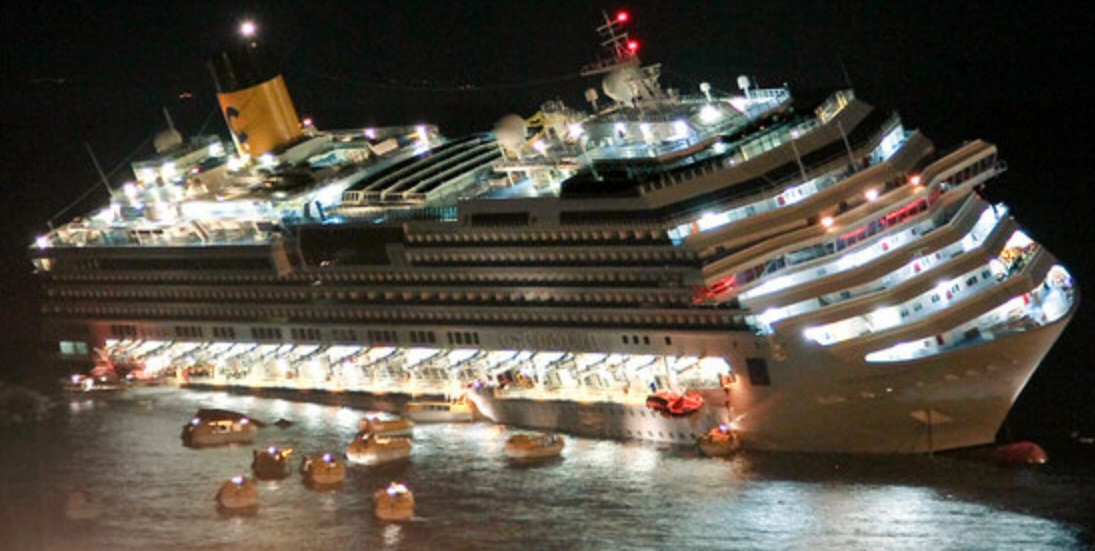
All starboard lifeboats recently launched.
9 (or 10) lifeboats of 13 starboard lifeboats can
be counted in water near ship. Red at right probably liferafts.
List and sinking is so bad the water near the stern
is up to the lifeboat deck
(Note contrary to a passenger's account almost no
rescue craft are near the ship at this time)
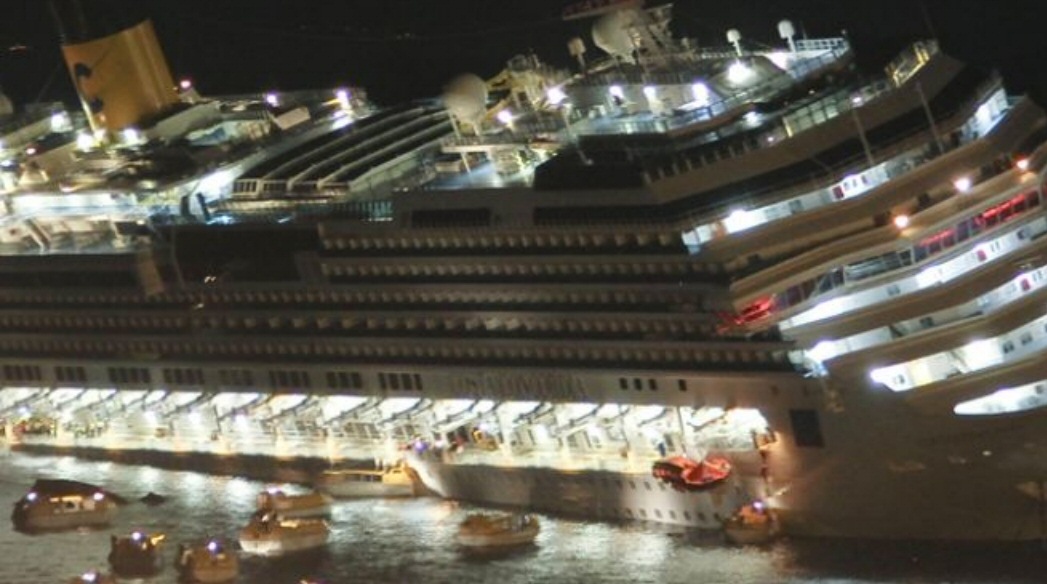
Close up view of image above
Center: looks like this lifeboat has just launched
as it is still touching ship
Rear: looks like some passengers still on deck, very
close to water line
Also looks like one person near the front and maybe
a few center near lifeboat against ship
Critical question: Was the ship's list so bad at this
point that the passengers who didn't make it into the starboard lifeboats
have been able to climb the 30 degrees or so across
ship to the port side lifeboats?
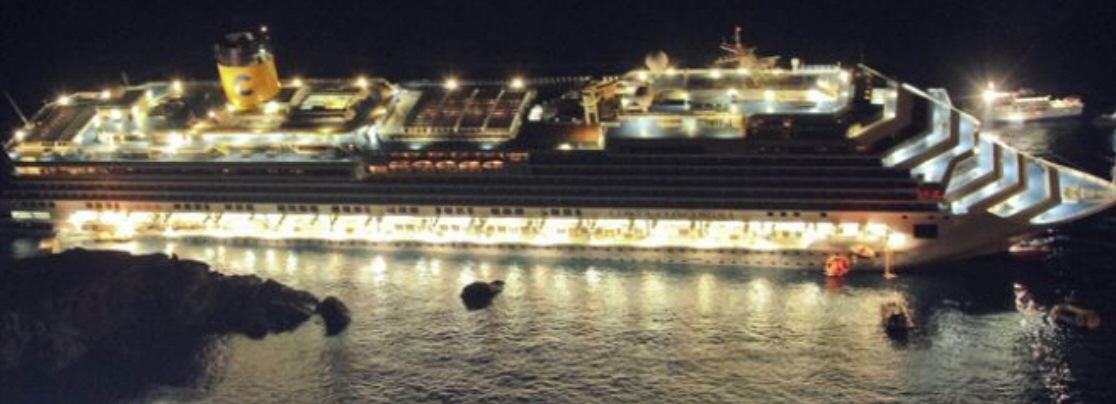
All starboard lifeboats launched
Passengers earlier seen mustering near bow earlier
are now missing
right: one or two lifeboats visible in water heading
toward Giglio harbor
(no rescue craft visible)
According to one rescuer, "a few hundred" -- plunged into the water to swim to the shore.

All 13 starboard side lifeboats have been launched,
ship less well lit.
(boat right is right size to be one of the lifeboats)
Another dancer, Rosie Metcalf, 22, from Dorset, had
to cling to a fire hose
before being winched to safety by a helicopter crew.
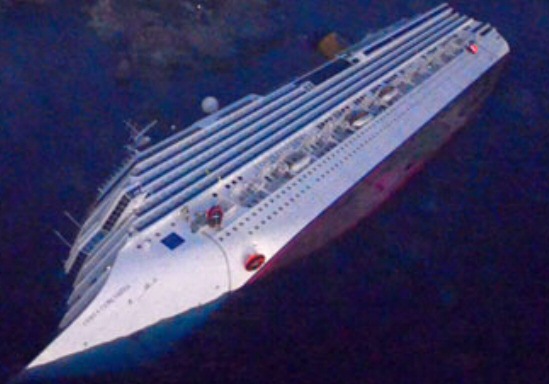
3 port side lifeboats never get launched
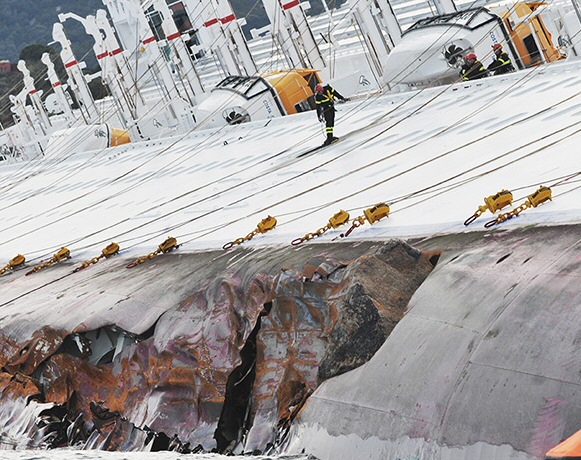
3 lifeboats never launched from the (high) port side
can be seen in this picture.
Foreground tackles near the waterline had held the
launched lifeboats
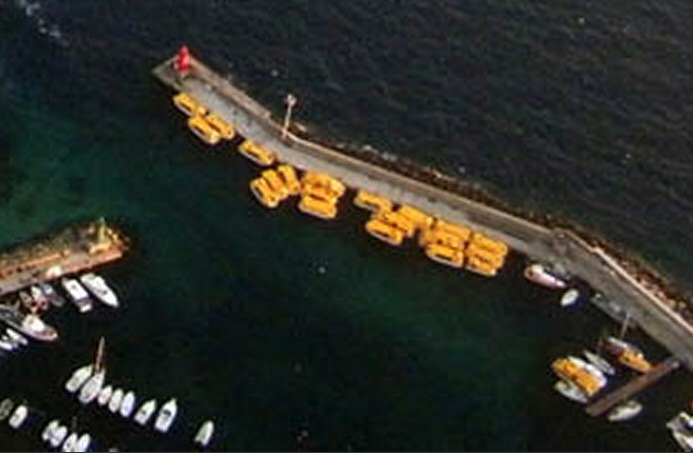
22 (or 23) of Costa Concordia's 26 lifeboats can be
counted in this aerial image of Giglio harbor

Costa Concordia (semi-covered) lifeboats in Giglio
harbor.
These boats are about 40 foot long. If 9 rows of 21
(guess), it would fit 189 people
(passengers speak of standing in the lifeboats)
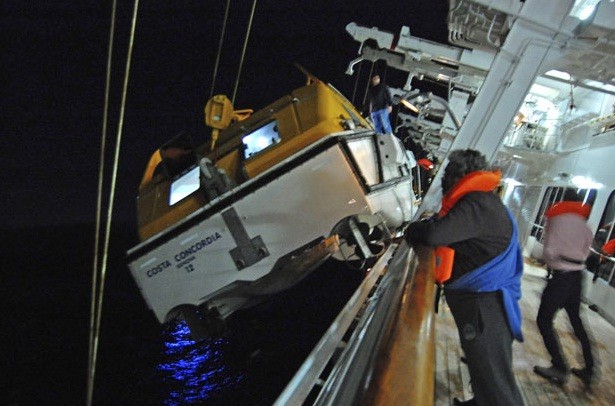
Yikes, a 45 degree tilt of lifeboat at launch!
Deck is clear, presumably about 180 people are inside.
One man standing on top. Why is this boat hung up?
The angle of the man right shows the ship is tilted
up 25-30 degrees, so clearly this is a port side launch.
(Standing passengers were thrown down as lifeboats
repeatedly crashed into the side of the boat while launching.)
"There was panic immediately" said Francesca Sinatra,
a passenger from Rome.
"People were shouting and climbing on each other,
adding the lifeboat that she was in
collided a number of times with the listing hull as
it was lowered because of the angle."

Walking the port side lifeboat deck with the ship
listing 25 degrees or so
(The absence of passengers must mean all the lifeboats
in this area are away.)

passenger image from inside a lifeboat
(Most people here seem to be sitting, and it doesn't
look packed. Ceiling is surprisingly high.
Hires photo of Costa Concordia shows 6 of 26 lifeboats
were taller than others.
-- passanger story --- we were on 4th lifeboat to leave.
There was no place to sit, it was so crowded. We eventually
found a place on the floor of the lifeboat.
Launching a lifeboat
Following are my screen
captures from a passenger video (link below) showing the launching of Costa
Concordia lifeboat #27 taken from the deck next to the boat. The video
shows the drop of the lifeboat to the water. It takes all of three seconds
because the water is now close to the starboard side lifeboat deck.

Officer in white looks up at the pully just as the
lifeboat #27 on starboard side is lowered (held by projecting white arm)
(my screen capture from passenger video)

Few seconds later lifeboat #27 is in the water (object
to right of officer arm is free pully
(my screen capture from passenger video)
Views from lifeboat
Following three
pictures are my screen captures from a passenger video (link below) taken
from a launching life boat. These pictures say good things about the crew
of the boat. From several pictures of mustering passengers it looks like
the passengers all had red life vests and the crew yellow. Notice those
remaining on deck here, after this life boat has left, all have yellow
life vests, and the two men in front are dressed in white, so they are
probably officers.

taken by passenger from lowering lifeboat (line holding
lifeboat is left)
those remaining on deck look to be crew (yellow life
vests)
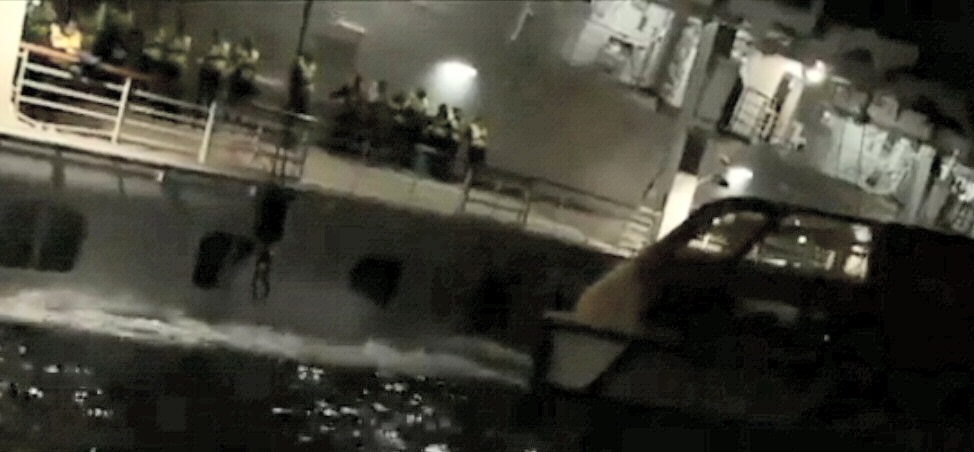
(same video as above) now lifeboat is in water
shows another lifeboat (right) powering up and leaving
the (starboard) side of ship
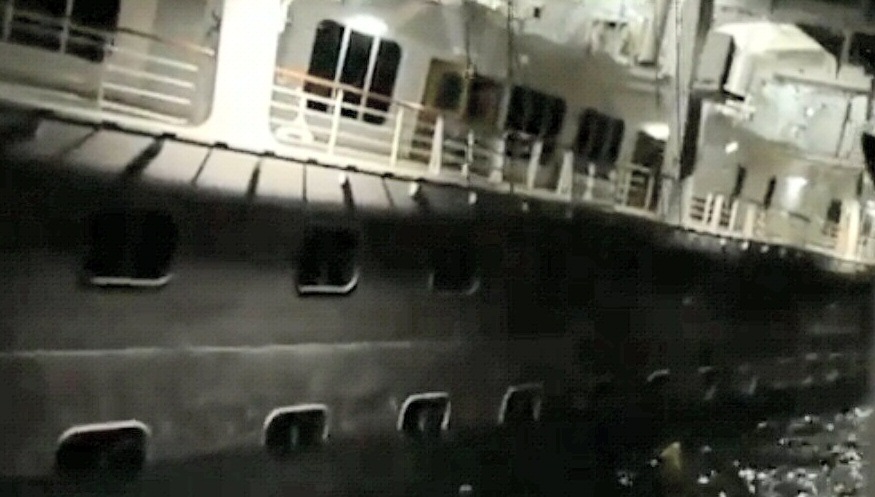
(from same video) as life boat sails along ship toward
harbor
no remaining people or lifeboats visible sailing on
starboard side toward the bow
(note ship is higher out of water than above)
Escape via rope
ladder
These infrared
images are very interesting. They are screen captures from an infrared
video taken by an Italian coastguard helicopter showing a lot of people
(50 - 150) still on the ship after it has fully rolled over on its
side. These people did not get off the ship in launched lifeboats.
Three groups of passengers are visible in this view of the port side of the rolled over ship (details in images below). Near the stern (top) passengers are going down a rope ladder to awaiting boats. Amidship and near the bow are more groups of passengers who have no obvious way off the ship except to walk to the stern to reach the rope ladder.
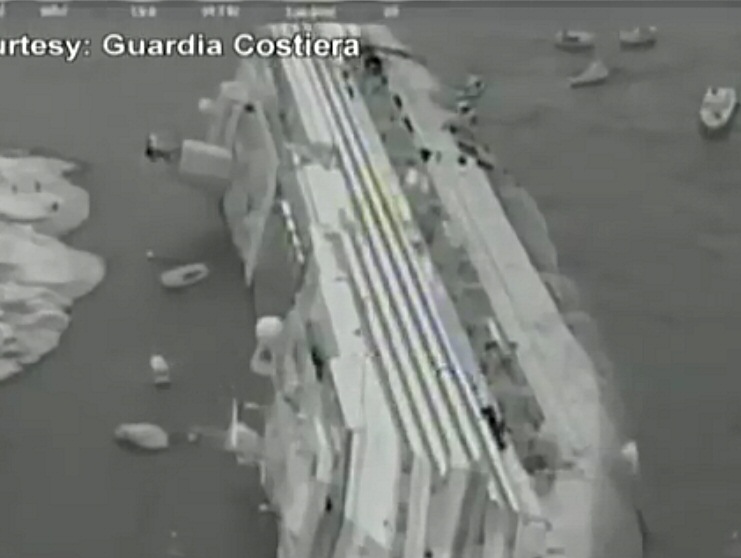
black dots visible are people,
three groups appear to be visible: forward (bot),
amid-ship, near stern (top) where rope ladder is located
many are actually standing or sitting on the (port)
side of the ship
(video source -- http://www.cntraveler.com/daily-traveler/2012/01/costa-concordia-disaster-sinking-ship-update)
Close up views of the rope ladder on port side near the stern with 50+ milling passengers. The video shows a rescue boat just pulling up to the rope ladder. People are clearly standing on the side of the ship, which has rolled almost 90 degrees.
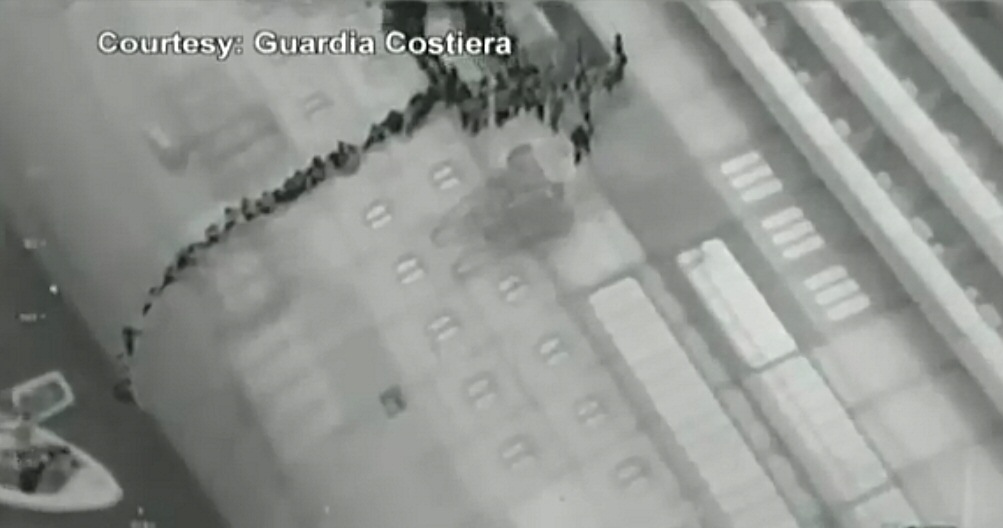
White diagonal bars (upper right) are passenger balconies
a small rescue boat has just arrived and is throwing
out a raft
Kirsty Cook, one of eight British dancers working on
the ship, said she was "lucky to be alive"
after using a rope ladder to climb down to a rescue
boat.

dozens of passengers queing for the stern rope ladder
(don't know what that large black thing (upper center)
is)
(large white blob below the black thing is a hung
up (red) life raft, see below)
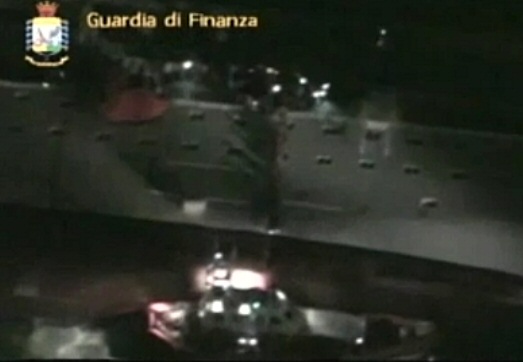
rope ladder exit, another view (lights from rescue
ships)
Other views from this video show the ship completely
dark at this time (except for external rescue lights)

rescue rope ladder?
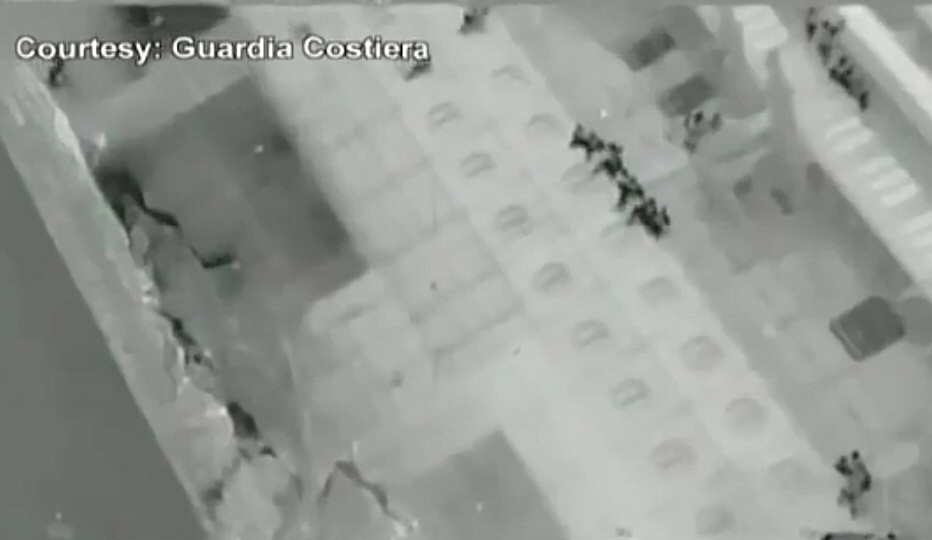
passengers strung out amidship (above gash)
many seem to be sitting on side of the ship
(just abovet a row of portholes below the lifeboat
deck)
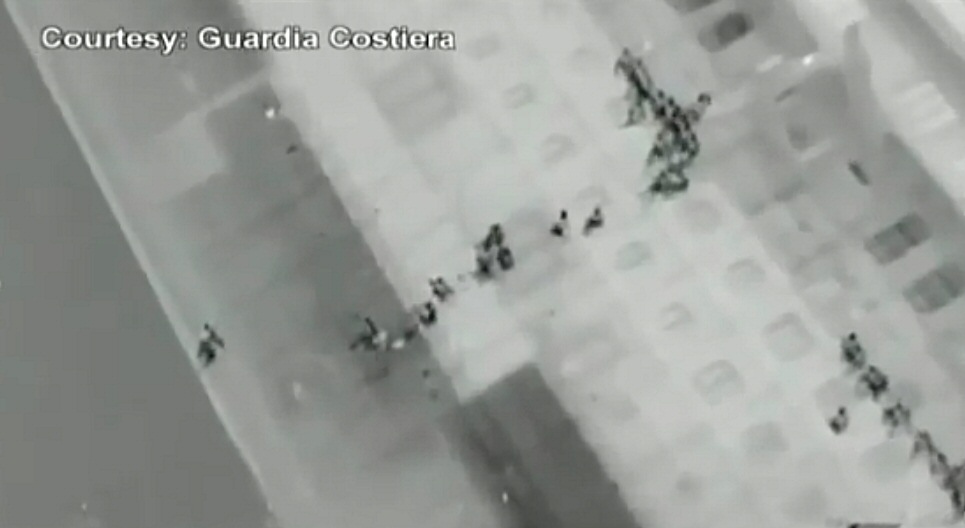
group of passengers near the bow (many appear to be
sitting)
(can't figure out how the person left is hanging on,
he appears to at the bottom of the ship)
 .
. 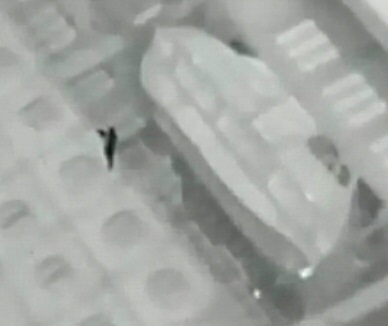
isolated passengers
(left) passenger trapped on balcony three decks above
lifeboat deck. No way he can walk to the stern rope ladder.
(right) passenger standing (waving) in front of unlaunched
port side lifeboat

lifeboats unload at Giglio dock --- 4,200 people is
a lot of people

passengers video shows frightened little girl after
crash (still on ship)
Thanks for the terror Micky Arison
Ship corridors and listing
The infrared
photos show a huge number of people still on the ship with it rolled nearly
over on its side, probably a 75-80 degree list. It set me thinking about
about how did the passengers get to the port side of the ship.
I suspect the high list of Costa Concordia that crashed in Italy in early 2012 was probably a killer. Infrared video shows 50-150 people still trapped on the ship while it had fully gone over (75-80 degrees). These people had made it to the high (port) side where there was one rope ladder down to the water and can be seen standing and sitting on the outside of the nearly rolled over ship, but another 30 or so people got trapped inside and died.
How high a list?
On a cruise ship
at what point does the list of the ship become so large that you can't
cross the ship? Seems to me it comes down to the question of handrails
in corridors.
If there were handrails in corridors, I'm thinking that while it would be very difficult, a fit adult might be able to pull himself up a long corridor inclined at a really, really steep angle of 30 to 45 degrees. Turns out there are dozens of cruise ship corridor pictures in Google, they all basically look like below. They all have handrails, but in no case did I see handrails mounted on doors. If you were hauling yourself up a 45 degree incline and the handrail stops for a door (sometimes two doors!) you're screwed. If you get to a narrow stairway, it seems to me you could climb it at any list (even 90 degrees by walking on the wall and bracing on stairs), but it only takes you up, not across the ship.
20-30 degree list
My guess is
that a 20-30 degree is about the limit where a anyone could actually 'walk'
around the ship, where you get from one side of the ship to the other.
45 degree list
When the ship's
list had increased to say 45 degrees, I was wondering if you were at the
starboard side or inside the ship, could you get to the port side?
In other words does a 45 degree trap you, is it fatal? Seems to me this
comes down to a key question. Are their handrails in corridors that would
allow you to pull yourself up a 45 degree incline? A 45 degree incline
is really steep (even 30 degrees is very steep, likely unclimbably
by the elderly). Think trying to climb up a kid's slide, which is probably
a 30 to 45 degree angle. Of course, it depends on your age and physical
strength too. What a fit adult might manage, could easily be fatal to a
senior.
And there is a further problem, which is finding a cross ship corridor. I don't know how many there are, but cross section views of big cruise ships show lots of high airy structures inside the ship, 1,000+ seat theaters, multi-deck open atriums, etc that would block cross ship access. One of the features of the ship was "Grand Atrium Europa, an open space 9 decks high! The two large restaurants (fore and aft) were 2 decks high.
In the photos one passenger appears to be trapped in his port side balcony. Even getting across a cabin listing at 45 degrees to reach the balcony might be impossible and could depend on whether the bed and furniture are bolted down.
Climbing a stairway at any list75-80 degree list
I suspect a closed stairway would be climbable any list of the ship (but probably not a big open stairway you might find in an atrium). At say 30 degree list you walk on the stairs bracing against the walls with your hands. At 45 degrees you can do this too, maybe alternately stepping on wall and stairs. At 80 degree list you walk on walls and brace on the stairs. At any list a narrow stairway gives you traction and something to lean on. The problem is it does not lead you to the port side. It leads you higher and eventually to the top of the ship (if the doors weren't locked!, which they might have been since photos appear to show the top of the ship closed up for a Jan cruise). Because the ship did not go fully over most (or all) of the top deck remained out of the water. I believe a few people were pulled from the top of the ship by helicopter.
Handrails with door breaks
Turns out
there are dozens of ship corridor pictures available on Google. Below is
a representative sample. (These photos are not specifically from the Costa
Concordia or its class.) Notice the problem, and it's a big problem.
While nearly all ship corridors have handrails, in every case the
handrails have breaks for doorways. I don't see how even a fit adult could
pull himself up such a corridor at a 45 degree using handrails like these.
There would be no way (or very difficult) to reach across a door to the
next rail. The shipbuilder, of course, could solve this problem by mounting
handrails on doors too, but in the dozens of photos I looked I never
saw
this. Clearly these handrails are only useful to steady yourself in a rocking
ship and not to pull yourself upward when a ship is listing heavily like
the Costa Condordia.
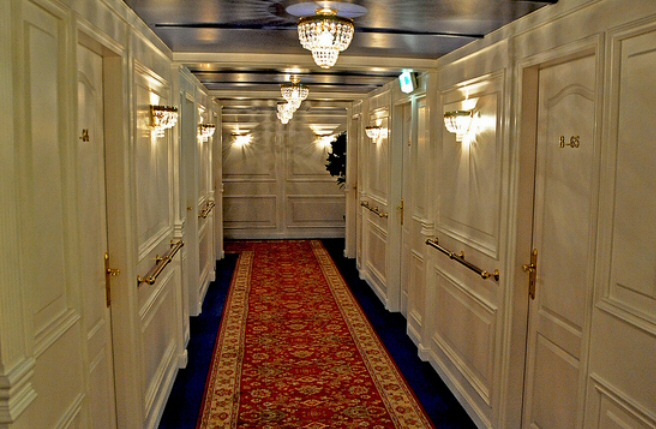 .
. 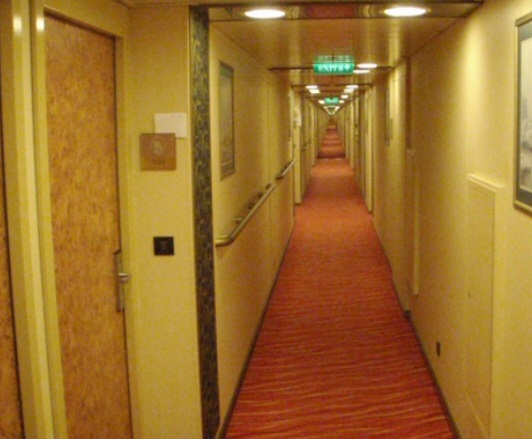
(left) more door than handrail
the more luxurious the corridor, the smaller the handrail!
(right) death trap, handrail has double door break
 .
. 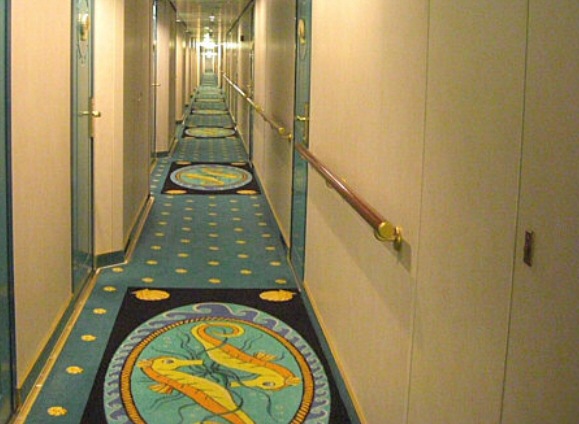
(left) handrail break not only from cabin doors, but
from corridor doors too
(right) big gap in handrail (foreground)
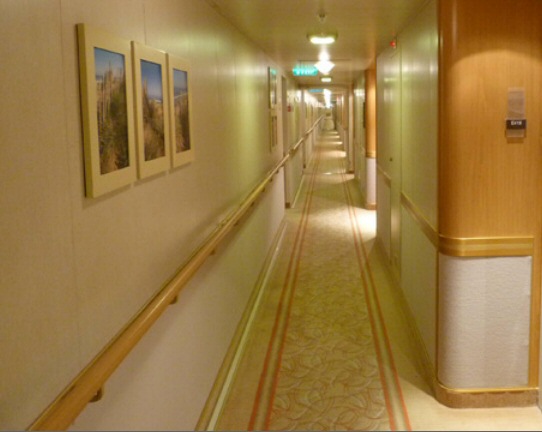
better, but still door breaks in handrail
Captain may have had a (small) point
The captain
said that after he left the ship he was coordinating the rescue from a
lifeboat. Whether he was actually doing much no one seems to know, but
he may have had a small point. From the harbor master timeline he was apparently
in a lifeboat for three hours or so. Once the list of the ship got above
30 degrees (or certainly above 45 degrees) essentially everyone was essentially
frozen in place, or to a vertical path fore and aft. Remaining on the bridge
could have meant being trapped there. And with a high list (say 45 degrees)
did the bridge have any information about what is going on in the ship?
Any cameras working? Anyone below to telephone in? Seems unlikely.
With a high list the only reasonable place for the captain and officers with with the lifeboats, port or starboard. The high list traps you on one lifeboat deck, so it is all you see with your eyes. And only when most of the boats had departed and the jam of passengers eased would it be possible (with some difficulty) to walk along its 13 lifeboat stations. No way to get to the other side with its 13 lifeboats (unless there is some sort of special tunnel) built into the ship. All communication then had to be by cell phone (have seen no info on how well this worked). However from a lifeboat, you can sail around and look up at the ship from both sides and (if not too dark) at least see how many passengers and lifeboats remain.
On the the other hand there is no doubt that officers were needed on board. One reason was to deploy a rope ladder, which is how the remaining trapped 50-150 port side passengers and crew got off the board. Anther was to coordinate helicopter rescues. At least two officer were lowered to the ship to perform these duties by the Coast Guard.
Cross ship passageways with tilting floor plates** Simpler cross ship passageway (update 5/15/14)
It occurred to me that a shipbuilder could quite easily build into a large ship for the use of the officers (or passengers too) one or two passageways (one fore, one aft) running directly across the ship. They could be designed so they would function at any list of the ship, and this would have the huge advantage of allowing people to move between the port and starboard lifeboat decks. Without something like this, what will happen is what happened on the Costa Concordia, once the list of a ship gets steep, say 30 to 45 degrees people are trapped on the side of the ship they mustered to. This left 50-150 (maybe 300) people trapped on the port side when it became impossible to launch the last three lifeboats.It also serves as an escape route if the ship is beginning to roll over on its side. Only because the Costa Concordia was only a few hundred feet from land in calm seas and people could swim to land did a lot of people on the starboard side not drown. It was not long after the starboard lifeboats all left that the entire starboard side of the ship went underwater. If the Costa Concordia had had a tilting plate cross ship passageways (like described below) passengers could have climbed a ladder (or steep stairway) that would have taken from the starboard side up to the high and dry port side.
Tilting plates
After one false start, the design is obvious. The passage way has a 'floor' of metal plates about a foot wide hinged (fore-aft) so they can swing up to +/- 90 degrees and can be locked in place at any intermediate angle. A control system keeps the plates level with the earth. In normal operation the plates form a flat continuous floor to walk on. If the ship lists say 20 degrees, the plates tilt 20 degrees to stay level with earth. In a 20 degree listing ship the passageway becomes a gentle stairway that could be quickly negotiated. At a 45 degree list it looks like a standard staircase, and like any staircase it could be climbed up or down. It the ship rolled over on its side (90 degree list), the plates shift 90 degrees. Entering the passageway it would look like a long ship's ladder and could be climbed either up or down. (see next)
All that is needed for a robust, climbable at any angle, cross ship passageway is one of these hoop 'ladders' on the floor to one side of a dedicated passageway straight across the ship. When the ship is level, you walk beside them. When the tilt is 45 degrees you use them like a jungle jim, leaning over and using your hands and feet to climb. At 90 degrees it becomes a hoop type ship ladder that you climb hand over hand with your feet walking up the hoops.

Italian newspaper graphic showing path, timeline and
water depth

I marked path of ship on Google earth image of Giglio
(with Ruler)
North is up, mainland Italy is 9 miles east, so enter
of channel is 4.5 miles to right
Ship hits rock outcrop slightly below water line on
port side while sailing north (at bot red dot)
Continues sailing about a mile and makes 180 turn
coming to rest (at top red dot) within about 100 ft of land.
Giglio harbor and town is in center of image, where
(gray) ferry lands
Costa Concordia is about 1/4 mile from town center
and there is a house relatively near the outcrop near the ship
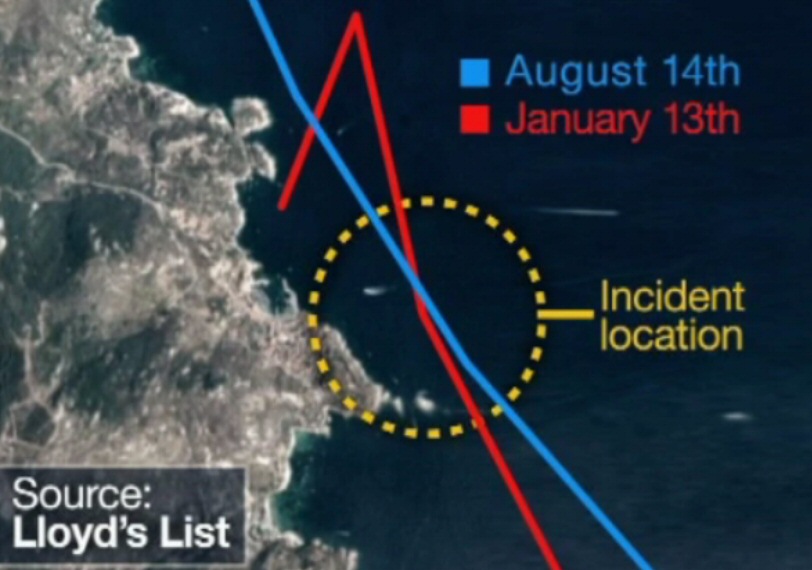
BBC compares present ship's path to the ship's path
in Aug 2012
The latter presumably approved by Costa management.
red --- Jan 2012
blue --- Aug 2012
Clearly the ship was basically taking almost the same
path it took a few months earlier,
which makes the Costa denial of approving the route
less than black and white (says BBC).
Costa management claims the ship in Aug never went
closer to land than 500 m,
but BBC says GPS tracking date from Lloyd's list shows
it went within 230 m of land.
source --- BBC news
Bow stabilizer
? gash
This ship
was driven by 360 degree rotating propeller pods (see picture below). This
might explain how the bow stabilizer wasn't damaged. Maybe as the ship
was heading in to hug the island shore it had its pods at an angle, then
the ship would not only have had forward motion, but also motion sideways
toward port.
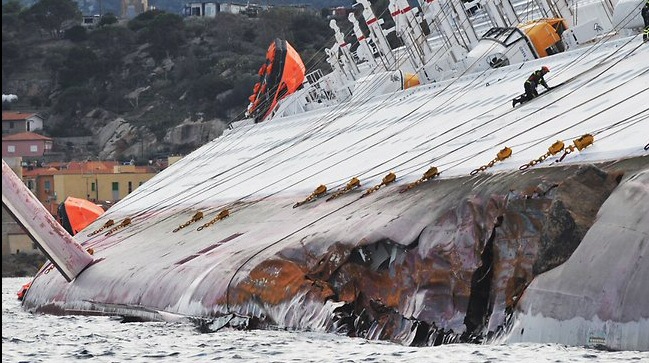
How come bow stabilizer didn't hit rocks?
2 of 3 unlaunched port side lifeboats visible above

Huge gash with huge embedded rock (close up)
No wonder everyone heard and felt the crash.
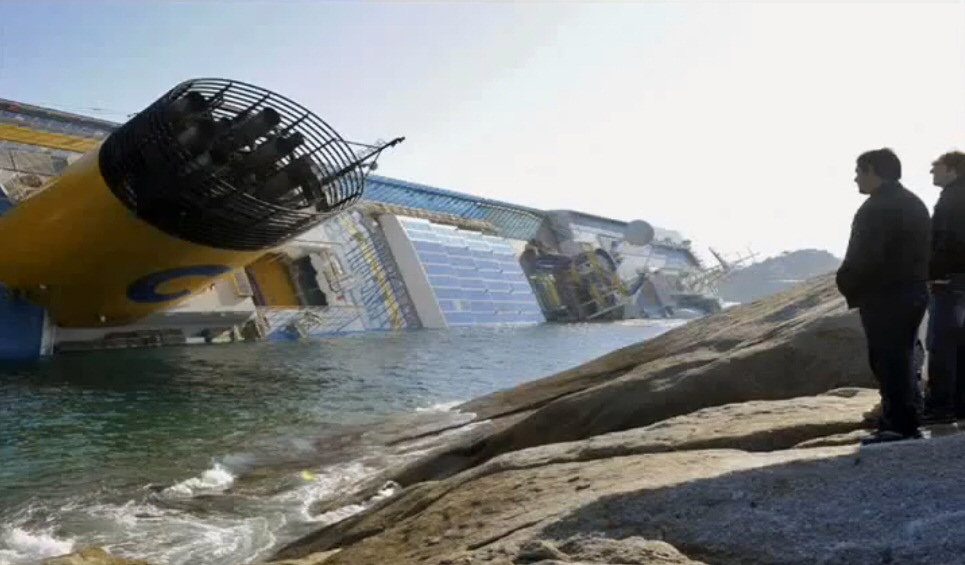
Notice how incredibly close to shore the ship is after
tipping over.
Ship is about 1,000 ft long, so the distance to (rocky)
shore can be estimated at to be 100 to 200 feet.
Google Earth shows the rocky outcrop is part of the
island. In fact there is a house about 800 feet from the shore.
(It does look like you might be able to climb out
of the sea at this point, gentle slope and tiny waves.)
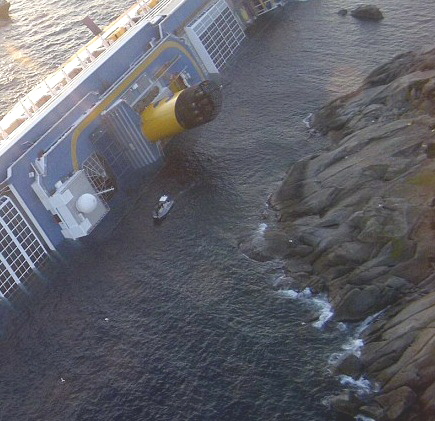
Ship is about 1,000 ft long, so the distance to (rocky)
shore can be estimated at to be 100 to 200 feet.
(Unclear if you could climb up onto these rocks. Maybe
in a few places.
Little wave action in upper half, but some (scary)
white water in lower half.).

Wow, really close. From this angle it looks like the
ship's funnel almost tipped onto land.
(The open top deck of this ship doesn't exactly look
like a vacation playland.
It looks more like it has been closed for the winter.
Was it even accessible for a stroll?)

Image taken by passenger, mustering to board lifeboats
(probably standing). Outside air temp was 45F.

The man himself.
He has been a Costa captain for six years, so he can't
claim inexperience.
Propulsion
Most Vista
class cruise ships, like the Costa Concordia, don't have rudders or engines
mechanically coupled to the propellers. Instead they have 2 or 4 'pods'
as shown below. The propeller is directly mounted on the shaft of a (multi)
Mw size electric motor (speed regulated by thiristor controller), the whole
thing enclosed in a sealed pod that can be rotated 360 degrees. Power for
the motors comes in via slip rings. The engines on board are used as generators
(prime and backup), and I read in a cruise ship about 70% of the capacity
is used for the motors and 30% for the rest of the ship.
The 360 degree rotation of the thrusters makes the ships very maneuverable, allowing them to dock without tugs. It would have allowed Costa Concordia, once its forward motion stopped, to be sideways thrust to beach on the island.
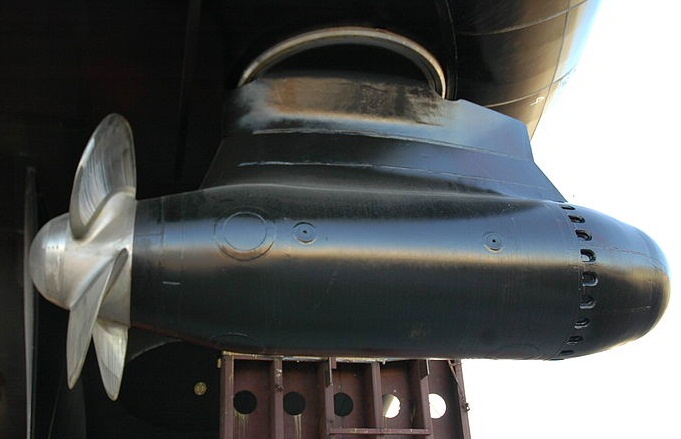
powering the ship
Azipod --- Azimuth thruster (360 degree rotating propeller
mounte on shaft of Mw electric motor
----------------------------------------------
Lifeboat design
It took a
lot of searching to find the specifications of cruise ship lifeboats. I
found nothing on the cruise lines sites. The photo site Flicker has some
passenger pictures of cruise lifeboats. A lot of cruise lifeboats are (partially)
covered, but I found some large ships (Carnival Fantasy and National Geographic
Endeavour) with open boats. At first I thought the open lifeboats were
only for ships cruise in warm waters, but the National Geographic Endeavour
ship was in a photo series labelled 'Antarticia'. Yup, medium size ship
National Geographic Endeavour that cruises the Antartic has open lifeboats
(4 lifeboats)!

open lifeboats cruising in the Antarctic
(National Geographic Endeavour)

open lifeboats (Discovery)
Open, partially closed, closed
Lifeboat builders
build three basic types of lifeboats: open, partially closed, and close.
I first though the Costa Concordia lifeboats were the closed type, but
lifeboat builders call this type of lifeboat a partially closed type. You
can see in the harbor picture (above) men standing in four large open areas
in the center of the boat. A true closed type looks like below and is dropped
into the sea (going down a slide).
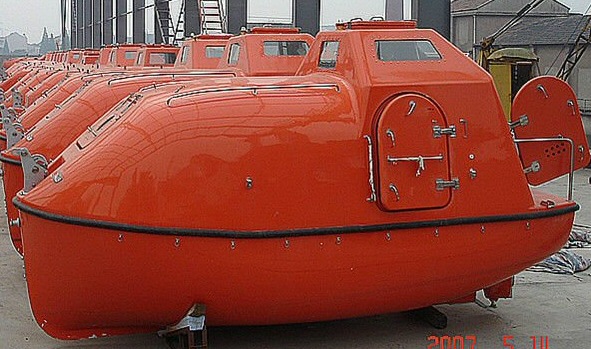
closed lifeboat (note water tight hatches)
(Closed lifeboats are often used on oil rigs and dropped
into the sea using a slide.)
Midship vs top deck
Another variable
is how high the lifeboats are. In some crusie ships, including the Consta
Concordia they are about half way up the superstructure (usually recessed
in), but in some ships they are way up on the top deck, far above the water
line. Also see quite a few different launch mechanisms. Some lifeboats
are ride out from the ship on parallel tracks arms (like an overhead crane),
but others lifeboats are held on steel arms that look like they might pivot.
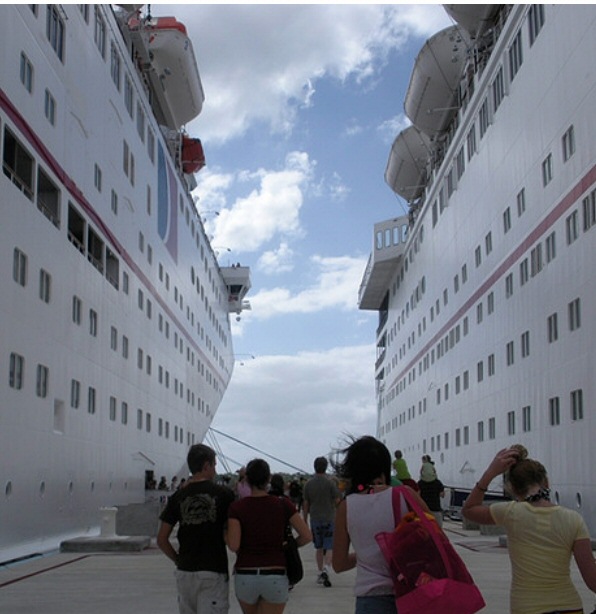
those lifeboat are way up there
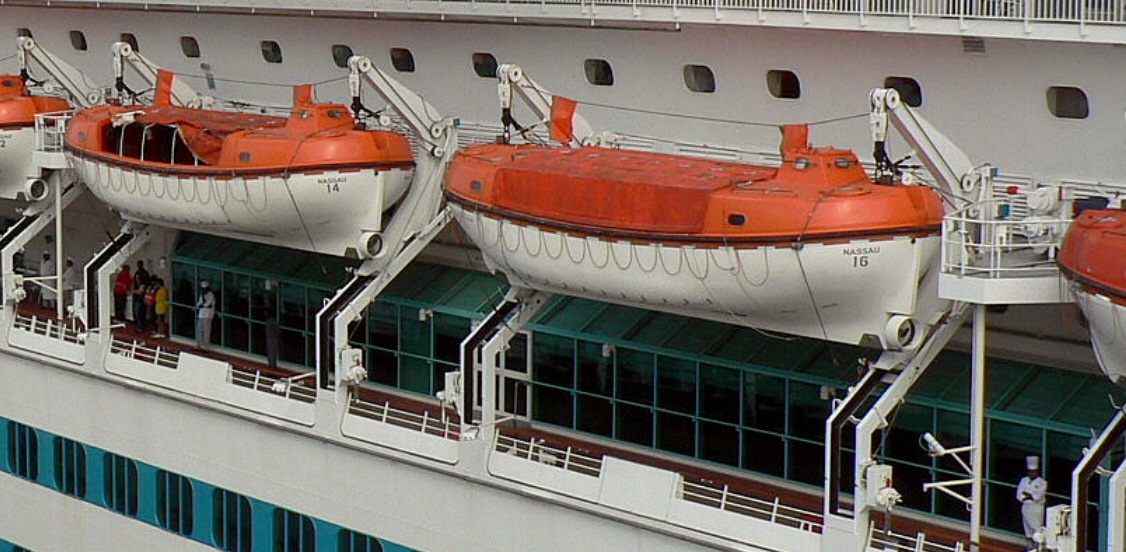
These mounts must pivot to get the boat over the water
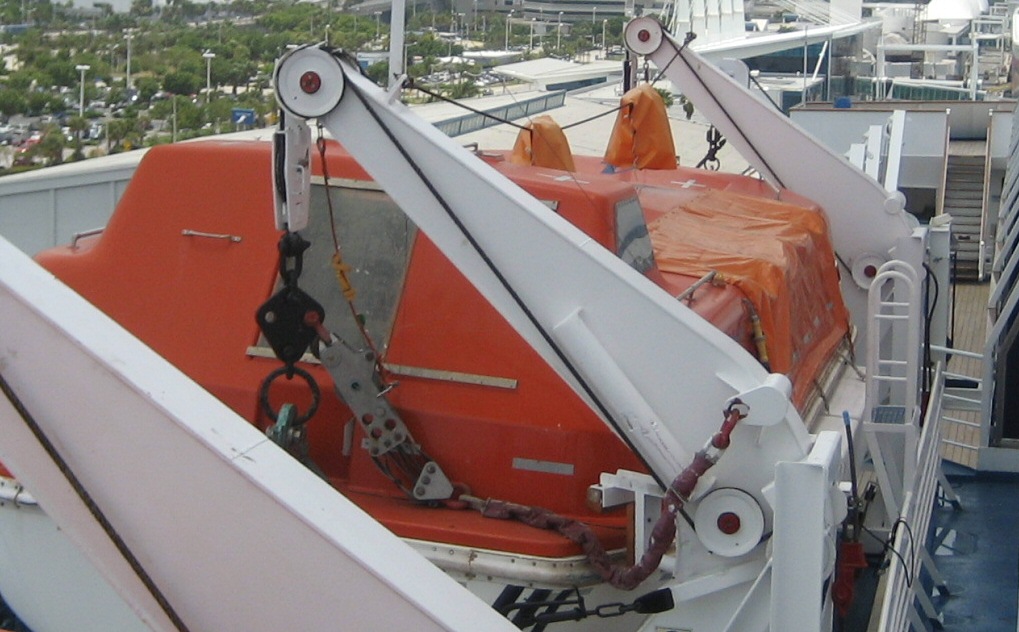
showing details of the pivot and boat attachment
What provides the power to launch boat?
The Diamond Princess (below) is almost exactly the same length and weight as the Costa Concordia. It carries 22 lifeboats (vs 26 on the Costa Concordia), so the capacity of its boats must be a little higher. One thing interesting here is that there are little balconies between boats so it looks like they would be boardable not only (presumably) from the side, but from the ends too. The labeling on the lifeboats has the same look as the Costa Concordia, so from that clue alone by guess is the two ships were built by the same builder.
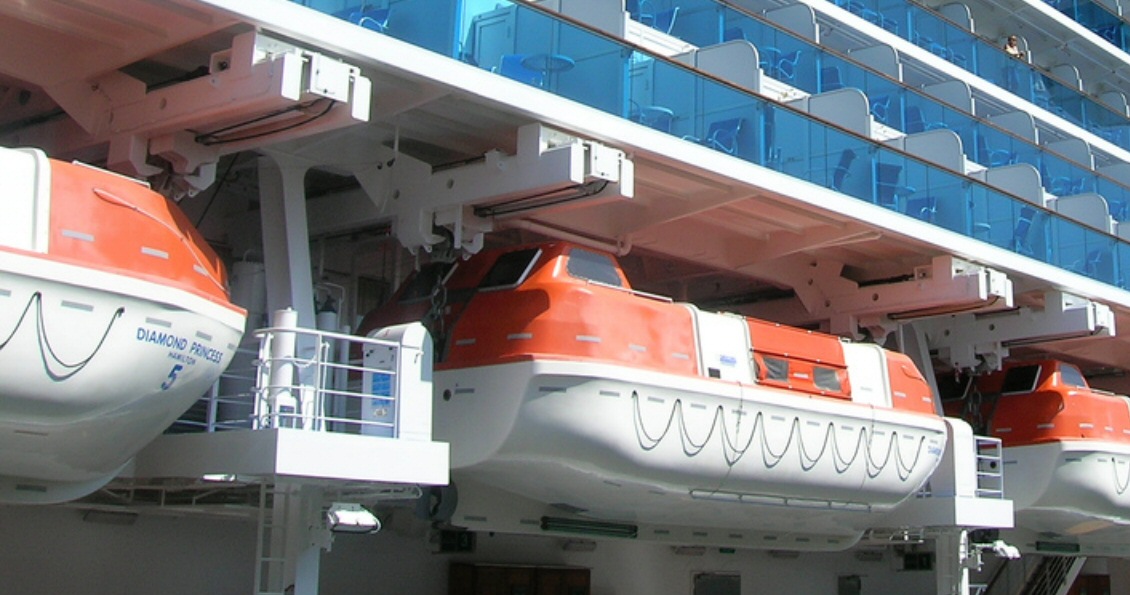
Diamond Princess lifeboats (22 total)
launching mechanism is clearly visible
might also be boardable at the ends via little balconies
between each boat
Looped rope on side (common feature) is probably for
people in the water to grab
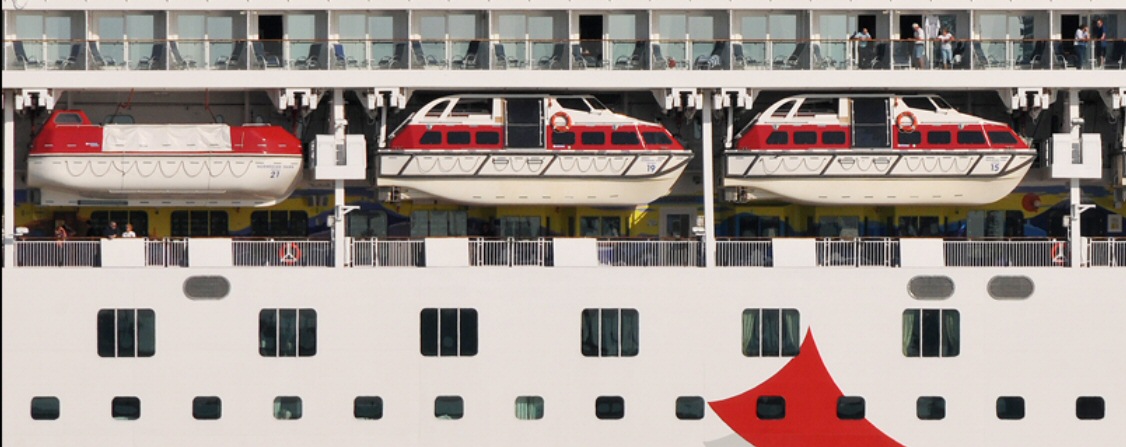
This ship carries two types of lifeboats
(Passenger balconies (to get away from the crowds)
are shown above)
Lifeboat capacity
Here are the
specs of lifeboat capacity (from a Chinese manuf). It shows a boat 34 ft
long and 11 ft wide is rated to carry 130 people (a boat 28 ft x 10 ft
can carry 85). The weight is given as 14,800 kg (32,000 lb or 16 ton) of
which about 70% would be the weight of the passengers (180 lb av).
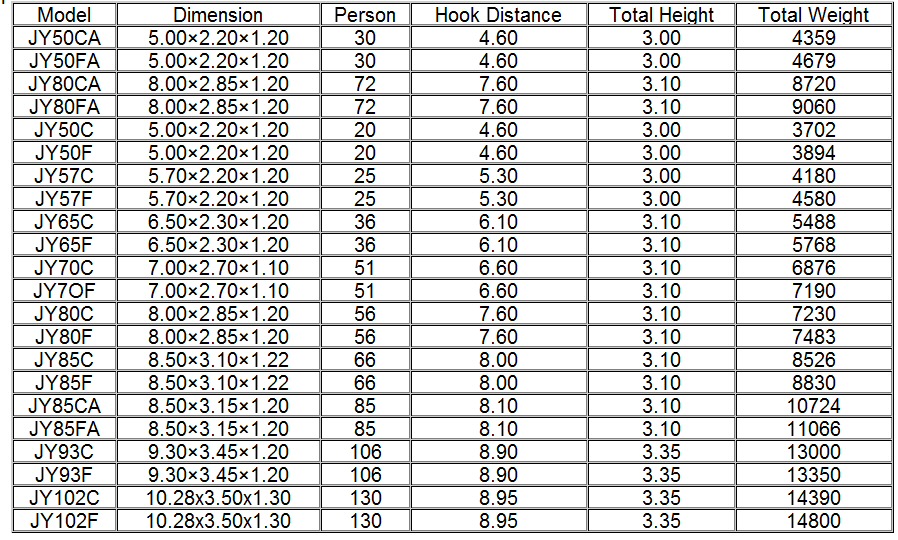
Lifeboats as ferriers to rescue ships
One key point is that lifeboat
were thought of (primarily) as a way to ferry passengers from a sinking
ship to rescue boats. For this purpose enough lifeboats for a third to
half the passengers is enough as they can go back and forth. Slightly over
1/3rd (700 of 2,200) of Titanic passengers and crew survived. The key issue
here is how long does it takes a ship to sink! The article references a
sinking of a big ship years earlier, saying it took 30 hours to sink. The
unplanned event with the Titanic is that it sank really fast, two hours
and 40 minutes, and the first rescue ship from 60 miles away (Carpathia)
didn't arrive for four hours. The North Atlantic was really cold (every
reference says the water temperature was a few degrees below 32F), so no
one in the water survived.
Except for bad luck the number of lifeboats on the Titanic might have been enough. There was a ship (Californian) close to the Titanic, but they had no wireless operator at night. And even though they saw the rockets the Titanic fired, they never came to help. Since they were only about 10 miles from the Titanic (vs 60 for the Carpathia), they would likely have arrived well before the Titanic sank.
The Titanic Society says the massive investigations and reports later written barely discussed why the Californian did not respond. It goes on to say that firing rockets was written into maritime standards as a distress call, but Titanic did not follow procedure. The rockets are to be fired at "short intervals", which it says usually mean a minute apart, but Titanic fired them at about five minute intervals and only fired 8 of its 36 missiles. However, the serious complication and a (weak) defense of the Californian is that in the days when few ships had wireless, rockets were routinely used in the open ocean for signaling, say when one ship passed another. The Californian was owned by another shipping line (Leyland), but so was the Carpathia (Cunard).
However, I read an article that makes a strong case, a case I find convincing, that the captain of the Californian was totally irresponsible. The Californian was not a passing ship, it had stopped for the night (like the Titanic), so it remained close to the Titanic the whole time after the ice berg was hit. The distance is disputed, 7 to 16 miles, but many in Titanic lifeboats said they could see a ship in the distance, which means the distance must have been about seven miles. Rockets used for signaling were color coded (each line had their own pattern) and the rocket the Titanic sent up were white. The Carpathia upon arriving sent up rockets too. The Californian ignored the rockets from both ships. The Californian had wireless, it's operator had shut it off and gone to bed when the ship stopped for the night (fearing to go forward into the ice field in the dark). The crew reported to the Californian captain they had seen rockets and (likely) a huge passenger ship in the distance, a ship that almost for sure would have wireless. The captain of the Californian does nothing, he does not even wake up his wireless operator to check for distress messages! This is really damning. The meaning of the rockets could have been checked out by simply waking up his wireless operator.
48 Lifeboats recommended
The article
quotes a manager of Harland and Wolff (Belfast, Ireland) the
ship yard that build Titanic, as recommending in 2007, five years before
1912 crash, to the head of White Star line (Bruce Ismay) its customer,
that Titanic carry 48 lifeboats, enough for all the passengers. Ismay says
no, it will cost more and there is more clutter on the top deck. The way
it is left at the planning meeting is that the ship will carry the number
of lifeboats the regulator commission (Board of Trade, a government body)
requires, but that the ship will be designed so that if a full complement
of 48 lifeboats are mandated, the ship can easily accommodate them. (However,
a detailed spec of the ship says it was built with room for 32 lifeboats.)
These were open lifeboats with oars.
"Titanic carried a total of 20 lifeboats, but Alexander Carlisle, one of the managing directors at Harland and Wolff, had suggested (to White Star) using a new type of larger davit, which could handle more boats, giving Titanic the potential of carrying 48 lifeboats, providing more than enough seats for everybody on board." (http://www.titanic-titanic.com/lifeboats.shtml)The Board of Trade requires 16 lifeboats, same as for any ship over 10,000 tons, and Titanic carries 20 with capacity of 1,178 (53.5% of people on board on maiden voyage). However I read the Titanic's capacity was 3,547 passengers and crew, so with 2,200 hundred on board on the maiden voyage it was far below capacity. The 1,178 lifeboat capacity breaks down: 14 lifeboats with capacity of 65, 2 with capacity of 40 (these smaller lifeboat were kept hanging out, ready to quickly launch), and 4 'collapsible' (canvas sides, folded flat) with capacity of 47. The number of lifejacket exceeded the capacity of the ship.
Bruce Ismay is on the Titanic and gets a seat in one of the lifeboats and survives. The man usually described as the 'designer' of the Titanic is Thomas Andrews, who worked for Harland and Wolff. It's not clear to me he was responsible for the bulkhead design (though he might have been). He started at Harland and Wolff at 16 as an apprentice and had worked his way up (his uncle owned Harland and Wolff!) to be manager of draftsmen and construction. But there must have been naval architecture types, whose names I never see mentioned, who did the basic ship design and designed its propulsion system. Andrews was one of nine Harland and Wolff experts sailing on the maiden voyage of Titanic and all died. There is apparently a biography book about him. The Titanic was not a one off, she was the middle ship of a trio of Olympic class sister ships built by Harland and Wolff for White Star: Olympic, Titanic and Britannic. The Olympic had been finished a year before Titanic. The Britannic hit a mine in WWI and also sank.
Design flaw
No one seems
to call it a design flaw, but it seems to me its obvious that's what it
was. A little oversight. The ship was designed with water tight compartments
separated by closable doors. But somehow the assumption seems to have been
that the ship would remain level, so compartments were not sealed at the
top. The long gash in the ship started near the bow, so the ship began
to nose downward with result that water spilled over the top from one compartment
to another. Andrews could see the ship would sink, and his telling the
captain is featured in every film of the Titanic.
Titanic vs cruise ship
The Titanic
was quite narrow. The Costa Concordia class of cruise ship is about 10%
longer and 30% wider than Titanic, but why it is so much heavier is kind
of a mystery (to me). The Titanic had 29 huge boilers and a double hull,
that's a lot of steel.
Titanic:
46,000 tons, 882 ft long, 92 ft wide,
3,547people, 20 lifeboats
Costa
Concordia 114,000 tons 957 ft
long, 119 ft wide, 3,800 people, 26 lifeboats

Titanic's open, 65 passenger lifeboats (in NY)

Titanic lifeboats being launched
(Looks like a painting or from Titantic movie)

ship model of Titanic shows four 65 seat open lifeboats
astern and three forward (on each side) on top deck
(clearly there was room to mount a lot more of the
same type of boat)
Getting out of your cabin
This is either
easy or impossible. Nearly all ship cabins have one door to the corridor.
If you don't have a balcony, you have to get to the corridor. If the room
is oriented across the ship (door toward port or starboard), as most are,
then with the room nearly vertical the door is either literally under your
feet, or it's 20 to 30 feet over your head. If you door is toward port,
it's far above your head and unless possibly you can pile up all the furniture
and climb it up to the door (very doubtful), you can't get out of your
cabin, you are trapped!
If the cabin runs the other way (bow-stern), you might be able to get part way up the wall to reach the door. But then what? The corridor outside is nearly vertical! It looks like an elevator shaft. You can't go there, you are trapped in your cabin.
In the corridor
If the door
is under your feet, you can open it. You then need to drop down to the
other side of the corridor. Quite a drop, and while in good light maybe
doable if you are a fit adult, this won't be so simple if it's dark, and
there's are real risk you might get hurt on the landing. In fact one rescued
crew man did have a broken leg. Once you get there you are now committed
to the corridor, because cabins are above your head and run vertically
upward, or they are below your feet and run vertically downward.
A walkable corridor runs bow-stern, so you can start out in either direction by walking on the corridor wall. First big problem is that this corridor doesn't lead to the lifeboats, it doesn't lead (directly) to the outside of the ship, it doesn't get you higher above the water line. It might however get you to a stairway, which if not locked, might get you to the top of the ship, where you still can't go up or down, but at least you might be visible and reachable by helicopter. At least one person (the next day!) was rescued from the top deck by helicopter.
But what happens if you run into an open cabin door? Looking at the corridor pictures above the doors often doesn't go all the way to the ceiling, so you probably can get across an open door, by stepping on the piece of wall above the door. Ok, open doors can be gotten around, but now you run into an intersecting corridor.
If this is a through intersection, or a T intersection with the intersecting corridor going down, you're screwed, your progress in this direction is blocked! You may see the corridor continuing, but you won't be able to get across the gaping vertical shaft the intersecting corridor has become. It will be far too wide to jump. Only if the intersection is a T with a cross ship corridor going up vertically can you proceed. If the corridor you are on is adjacent to starboard outside cabins, obviously you will not run into downward going corridors. However, the bad news is that you are likely already dead, since except for decks high up, most of the starboard side of the ship is underwater.
CorrectionBottom line, if you get to a bow-stern corridor, you can only move along it between intersecting corridors. If there is no stairway (upward) in this section of corridor, you are trapped there. Even if there is a stairway the access door needs to be below your feet, not above your head, and there is still another nasty drop getting into the stairwell (likely to be badly lit and maybe dark). Finally you have to hope when you climb up to the top deck it is accessible, that the door is not locked. (Pictures show the facilities on the top deck covered for the winter, so who knows if it was accessible or not.)
Not most, but all outside cabins on every deck on the starboard side ended up underwater. Look at the picture below. From this angle you can see that not only is the entire starboard side of the ship underwater, but that the ship is pretty much half filled with water, nearly everything to the right of the midline of the ship is underwater. So even if you got to the top (open) deck of the ship from a stairway on the starboard side of the ship, you couldn't remain there. As the water rose to engulf you, you would be forced to jump in and swim to the shore, but this would probably save you.
The above report was filed post crash and discusses the Costa Concordia 'crash', but it's not generally called a crash. No it's called a "grounding".
This table from the above report shows all the cruise lines of Carnival Corp and how many of its 99 cruise ships each line operates. Carnival Corp operates ships all around the world, but the report says 60% of its cruise business is based in North America with 60 of its 99 ships based there. Ticket revenue in 2011 was 12 billion with another 3 billion from on the ship sales. They spent 2 billion of their 15 billion in revenue on fuel and 1 billion on food. Their 99 ships are valued at 40 billion (Costa Concordia loss is generally given at about 500 million.) They claim they are not subject to US income taxes as they are a "foreign corporation engaged in the business of operating cruise ships in international transportation". CEO Arison is the son of the founder of Carnival. He lives in Miami, where he owns the local NBA basketball tema (Heat).

AIDA line is
based in Germany and Ibero line is based in Spain, but the report says
both are divisions of Costa, based in Italy. Cunard line has only three
ships: Queen Elizabeth, Queen Mary 2 and Queen Victoria.
----------------------------------------------
Fincantieri
shipbuilders
A check of
the Costa Concordia shipbuilder, Fincantieri, shows they are the largest
shipbuilder in the Mediterranean and one of the largest in Europe. They
own half a dozen ship yards in different Italian cities, 10,000 employees,
even own some ship yards in USA and Germany. They have built a huge number
(dozens) of big cruise ships for nearly all the big cruise lines. A check
of their Costa ships shows they have building the same basic ship for Costa
since 2004, almost one a year, about half dozen ships with same weight,
size, and speed of the Costa Concordia. The Costa Concordia thus was a
very typical, modern, big cruise ship (Vista class), so its lifeboats and
lifeboat mounts were probably very typical too.
Wikipedia says they used to own the engine builder too, but spun it off. The just build the new Queen Elizabeth for Cunard (also owned by Carnival Corp). The Vista class of ships is powered by rotating pods that contain an electric motor mounted directly to a propeller. This allows the ship to thrust in any direction (and dock without tugs). There were reports that the Costa Concordia once it got stopped and turned 180 degrees so was listing toward the land, its thrusters moved the ship sideway (toward starboard) driving it into shallow water where it bottomed.
Reuters on ship safety (1/24/12)
-- The very
public dispute between Captain Francesco Schettino and the owners of his
stricken vessel is a symptom of lax regulation and supervision that can
only add to pressure for the cruise line industry to be subjected to closer
scrutiny.
-- Research by Reuters has revealed, however, that patchy safety data and poor accident reporting standards make it difficult to verify how safe the industry really is and impossible for members of the public to easily compare the relative safety standards of different operators. Costa Concordia owner Carnival, for instance, outlines in its 2010 sustainability report details of an accident in which another member of the Costa Cruises fleet - the Costa Europa - collided with a pier while docking in the port of Sharm el-Sheikh, Egypt, causing a hole in the ship, killing three members of the crew and injuring four passengers.
-- Prof Klein's data, which he posts on his website www.cruisejunkie.com, suggest that for cruise ships alone there have been 368 disabling events such as fires, 174 persons overboard, 75 groundings and 27 sunken ships, giving a total of 644 incidents since 2000. That's more than twice what the IMO data shows for cruise ships, ferries and other passenger vessels combined. "No one keeps track of it and it's not really reported anywhere," Klein told Reuters. "I scour the world media every morning and look for what's been reported anywhere. I receive about 3,500 hits on my website every day, a lot of them are passengers and crew members and they send me information."
Costa
Concordia YouTube videos
Includes a
polished Costa promotional video showing soaring inside views of the beautiful
ship (7 min)
http://www.youtube.com/watch?v=6R_lZm6WWBo&feature=related
(local
link) (37.6 Mb)
Includes
(2nd half) video shows a loaded lifeboat (Costa Concordia #27) launching
from starboard side. The ship is listing so much that the drop to the water
can be seen to take only three seconds. (3:31 min)
http://www.youtube.com/watch?v=weBvXtlyW2k&feature=related
(local
link) (12.9 Mb)
Includes views of dinning room being cleared after collision and walking
about, and video taken by someone in a just launched lifeboat looking back
at ship showing passengers still on board and another lifeboat just powering
away (see pictures)
http://www.youtube.com/watch?v=7ozjEcOUxEA&feature=related
Animations of the accident
Animations
can vary a lot in accuracy, but can provide useful details. There are several
of the this accident. The first one shows the route of the ship and says
the 'engines failed' just three min after the crash, but I question this
as clearly the ship had some propulsion power after (possibly battery?)
and was able to be manuvered over next 45 min into position near the shore.
The lies of the captain and Costa management are also nice inserted. (For
more search 'Costa Concordia Animation' in YouTube)
http://www.youtube.com/watch?v=QklERulUpwc (6 min, starts at last Italian port)
Latest news (1/24/12)
-- Silvia
Coronica, the third officer, gave evidence in Grosseto on Monday in the
ongoing investigation. She described a scene of mayhem just minutes before
impact
as the restaurant’s head waiter excitedly pointed to the mainland. Schettino
was allegedly guiding the ship close to Giglio on his behalf to
wave to some friends who had gathered in the city’s main port.
“Schettino was scurrying from one part of the bridge to the other,” Coronica told investigators, according to transcripts of the investigation leaked to the press. “Those who came to the bridge were disturbing the ship’s navigation. The head waiter was chatting, disturbing the captain’s concentration on the steering.”
(my comment) Here we have the 3rd officer saying the captain was 'steering' (whatever this means) and that he was going close to shore as a favor for his head waiter!
-- She (ship's 3rd officer, Silvia Coronika) added that after the accident, the captain “was walking from one end of the bridge to the other in panic.”
( my comment) Here we have the 3rd officer telling us the captain's reaction to the crash on the bridge. This makes it crystal clear that the officers on the ship's bridge knew immediately that the ship had run into trouble, so the reassurances given to the passengers (in the name of the captain) for a full 45 minutes ('its just an electrical fault, its been resolved') were out and out lies. Some company Costa Cruise Lines/Carnival Corp is.
-- Paolo Fanciulli, owner of the Bahamas Hotel in Giglio’s main port, told investigators that the morning after the crash Schettino was at the hotel, being interviewed by Italian journalists. He was wearing a black uniform, not the white one he was photographed in at dinner, implying he had actually gone back to his cabin to change after the crash.
-- The investigation has widened since Schettino’s arrest on Jan. 14, according to a statement sent to The Daily Beast by Schettino’s lawyer Bruno Leporatti. Schettino was actually following orders given by Costa to skim by the island of Giglio, he says. “Costa ordered the deviation even before the Concordia left the port in Civitavecchia,” he said.
(my comment)
This undercuts the 'deal' argument with the captain now claiming the company
management set up the 'solute' at Giglio, but it reinforces the argument
that the Costa Lines is not so innocent here.
----------------------------
-- In
a Senate hearing, Pier Luigi Foschi gave a blow-by-blow account of captain
Francesco Schettino's contacts with Roberto Ferrarini, Costa Crociere's
chief crisis unit officer, on the night of the January 13 disaster. Foschi
read out a statement in which Ferrarini said he received a first call from
Schettino at 9:57 pm (2057 GMT), about 10 minutes after the Costa Concordia
crashed into rocks off the Tuscan coast, tearing a massive gash in its
hull.
"Schettino said that he had a big problem on board. He told Ferrarini that he had hit a rock and there had been a blackout. The captain said that only one of the sealed chambers was flooded." In another call at 10:06 pm, Schettino told Ferrarini that a second sealed chamber was flooded "but said the stability of the ship was not in danger."
But at 10:33 pm Schettino said "the listing of the ship was increasing" and two minutes later he told Ferrarini that the ship would be abandoned. "Ferrarini says he was completely surprised by the abandonment of the ship. He says that judging from the previous telephone conversations he could not have understood that the situation was so extreme," Foschi said.
(my comment) Here we have the captain telling the Costa people 10-20 min after crash that he knows he has hit a rock has a big problem and compartments are flooding. All the while passengers are being kept literally and figuratively in the dark. Not only is vital information being withheld from them, but they are being deliberately lied to ("it's just an electrical problem"), lies which are well documented by passenger videos.
-- Costa Concordia Disaster: Some Passengers (on Costa Concordia) Offered 30% Off Next Cruise!
This company is truly
a bunch of sweathearts....
----------------------
(1/28/12) "Tourist navigation"
Here we have
the head of Costa Line telling an Italian parliamentary committee that
his ships do indeed, as a matter of company policy, sail close to shore
for passengers to have a good look. Of course, the Giglio approach was
at night with a lot of passengers eating in the dining room. Hope they
enjoyed the view.
On Wednesday, the chief executive of Costa Crociere SpA, Pier Luigi Foschi, insisted that Schettino didn't have approval to change the ship's routing and was going far too fast -- 16 knots -- to be so close to shore. But he defended the practice of so-called "tourist navigation," whereby enormous cruise ships steer close to shore to give passengers a look at the sites. He said it was part of the "cruise product" that passengers demand and that cruise lines are forced to offer to stay competitive. "It's something that enriches the cruise product," Foschi told a parliamentary committee. "There are many components of the cruise product, and we have to do them like everyone else because we are in a global competition."
Foschi stressed
that such deviations from charted routes are supposed to follow strict
protocols that ensure safety: ports are informed, the company is informed,
and certainly no ship of the Concordia's size would be charging 200-300
yards off shore at 16 knots. "For anyone who knows that zone, that ship
with those characteristics shouldn't have been there," he said. (Fox news)
---------------------------
Alarms
** (key point) --
On a state-of-the-art, and fully automated cruise ship like this one, you
can’t get right up close to an island without shutting off a half dozen
alarm systems that tell you that you are entering shallow water.
These alarms would not be disregarded by the ship’s officers, the decision
to bypass these safety alarms while in close proximity to land would certainly
have been made by the Captain. In a public statement he made over the weekend,
he mentions that he was at least 150 meters from shoal water, and about
300 meters from land. Putting those numbers into context, he had
knowingly put his ship within half a ship-length of shoal water, in the
dark, and without a pilot on board. Anyone who’s ever driven a ship
understands how foolish that is. (gcaptain.com)
GCaptain ("World Leader in Maritime and Offshore News") also says Carnival Cruise insiders tell them while the company officially forbids 'showboating', unofficially it encourages it because it impresses passengers and sells tickets. This sailing site also speculates that more inside deaths may have been caused by runnning the ship in sideways to beach it than when it hit the rocks. .
Idiot company and
CEO
The fact that
(virtually) the entire officer corp of the ship abandoned the ship
with hundreds (maybe thousands) of passengers on board points to a badly
run company, and such mass incompetence and cowardice must reflect the
nature of the top management and that means CEO Arison. The fact that all
the officers quickly fled the ship is confirmed by associate mayor of Giglio
who boarded the ship soon after the crash and spend most of the night on
board. He reports the bridge was empty and never found any officers (except
for one very junior officer).
This company (Carnival Corp) appears to be run by a bunch of idiots, led by chief idiot, CEO of Carnival Corp whose family owns almost half the company, billionaire Micky Arison. Carnival brands operate 101 ships totaling approximately 200,000 lower berths with 10 new ships scheduled to be delivered between May 2012 and March 2016. Carnival Corporation owns and operates a whole bunch of cruise lines including Costa, AIDA, Cunard, Holland America, and Princess Alaska Tours, a leading tour company in Alaska and the Canadian Yukon.
After the captain and 1st mate too (says the Italian police) caused the sinking of the ship and death of many passengers, we have a recorded series of conversations between the fleeing captain (who is now off the ship) with the Coast Guard and port officials.
Transcript summery (excerpt)
Speaking by radio from a lifeboat, Capt Schettino says he is co-ordinating the rescue from there, pleading at one point: "Do you realize that it is dark and we can't see anything?"
The coast guard shouts back: "So, what do you want to do, to go home, Schettino?! It's dark and you want to go home? Go to the bow of the ship where the ladder is (go up the ladder onto the ship) and tell me what needs to be done, how many people there are, and what they need! Now!" (Coast Guard orders the 1st officer back to the ship too.) Capt after stalling for over an hour says he will go back, but this is a lie, both he and the 1st officer just leave and never go back.Ask yourself what kind of a POS would hire a jerk like Schettino to captain one of the largest ships in the world. Oh, that would be billionaire Micky Arison, CEO and member of the family that owns about half of Carnival Corp! He has failed to take any responsibility. He couldn't be bothered to fly over to Italy to express his sorrow, even though there is no question this was not an 'act of god', but was directly caused by his employees who then abandoned the passengers.

Micky Arison, CEO Carnival Corp, son of the founder,
post accident out to see a basketball game
(source -- Reuters)
-- Arison has been heavily criticized in media reports for failing to put in an appearance at the site of the accident, as bodies were still being pulled from the wrecked ship operated by Carnival unit Costa Cruises. But the "invisible" CEO, as he was dubbed in one report, looked cheerful at times and very calm, as he watched the (Miami) Heat beat the Knicks from his courtside perch behind a broadcast table. (Reuters, 1/28/2012)-- A taped telephone from the captain in his cell next morning has him complaining that he sailed close to Giglio because he was asked to by Costa mangement.-- Mitchell Proner, a lawyer with US firm Proner ? Proner, told the BBC that the owners could not pin all responsibility for the disaster on a "rogue captain". "It's easy to say this captain acted alone," he said.-- Beniamino Deidda, the state prosecutor of Tuscany, the coast of which would be devastated should the Concordia's 2,400 tonnes of fuel oil leak out, also launched a fierce attack on the owners of the liner that crashed after its captain made a showboating maneuver close to shore. "Who chose the captain?" he asked. "We need to turn our attention to the decision made higher up by the employer, ie the shipping company.""There are indications that there have been regular route deviations in the past. There should have been safeguards on board, where were the alarms? "At the time of the Titanic it might have been easy to say that radars didn't exist. Nowadays, with all the technology, it isn't. There had to be a failure in the system that allowed this to happen."

Arison underlings at Costa Cruise line at post crash
news conference in Italy
Interesting fact Arison (and fellow cruise CEOs) keep
to themselves
Where
does the shit go?
Ans:
(According to a 2/29/12 article in Slate): "Cruise ships, which can be
thought of as small cities on the sea, routinely discharge thousands of
gallons of human sewage a day (into the sea)."
Why did this crew member die? (1/28/12)
-- Erika Fani
Soriamolina's body was found by divers on the sixth deck of the vessel
wearing the ship's uniform but no life jacket. Witnesses said Soriamolina
had helped dozens of terrified passengers into lifeboats on the night of
the disaster before giving the life jacket to an elderly man. A tourism
graduate, Soriamolina was working on only her third cruise on the Costa
Concordia .
Here we have somebody helping load the lifeboats, but never gets off the ship. When and why did she die? (There never seems to be any follow up stories, autopsies, etc)
Other dead passengers
Erika is not an
isolated case. A lot of passengers found dead by divers have been on upper
decks and had lifejackets on. Why didn't they get off? Maybe their were
no more lifeboats (or they didn't know how to launch life rafts) and didn't
go where ever the helicopter people could find them. This is easy to understand.
With the ship tipped way over it's not at all obvious where you would go
to get the attention of the helicopters.
Is this what happened to dead passengers on the ship?
The logical place
to go (with hindsite) was probably the open deck where the port side lifeboat
were, but once the ship had listed 20 to 30 or so it would be very difficult,
maybe impossible depending of whether there are handrails you could pull
yourself up with. At 45 degrees or more it would be virtually an uphill
climb, and maybe doable (if handrails) by the young and fit. But when the
ship was fully on its side as it is now, going up a vertical corridor is
flat out impossible!
So thinking about this the list of the ship at first is an inconvenience, but it probably didn't take too long for it to get so high your only option was to stay still, which most people probably did from stories I read, or go down. At the same time water is coming up, so some passengers may simply have drowned, not able to go up to escape the water. Others may just have been stranded and died days later. A few passengers were rescued a couple of day after the crash, one with a broken leg.
Costa Fails Crisis 101 (1/27/12)
Written By Jennifer Booton, Published
January 27, 2012, FOXBusiness (excerpts)
With bodies still trapped inside Costa Concordia’s underwater tomb, Carnival (CCL: 30.13, -0.35, -1.15%) now finds itself at the heart of scrutiny only likely to rise along with the death toll. Carnival’s worst-ever wreck and one of the most high-profile incidents since the Titanic sank 100 years ago, it’s hard to imagine such a massive company blaming the disaster on a single person -- even if he did abandon ship early and steer a little too close to shore.
Even worse, while Carnival has vehemently denied earlier reports that it would offer survivors a 30% discount off future cruises, instead offering $14,500 each in compensation plus the cost of travel and a refund for the ill-fated cruise, its failure to douse rumors before they spread like wildfire didn't help its PR battle.
Meanwhile, Carnival’s CEO, Micky Arison, has only publicly surfaced through a few 140-character blips on Twitter and a short statement, leaving things in the hands of its lesser-known Italian subsidiary and Concordia operator Costa Cruises .... While Costa Cruises has been trying to keep the public informed through updates on its web site, the majority of observers are criticizing parent company Carnival’s absence in the aftermath.
To cap it all off, Concordia Captain Francesco Schettino, who has been on house arrest since the tragedy and faces serious repercussions, has been squaring off with his employer. Costa is pointing the finger at the captain’s “human error,” while Schettino claims the cruise line condoned the close-to-shore sail-by for promotional reasons. “Certainly the captain deserves blame -- but these things are systemic,” said Ian Mitroff, president of consulting form Mitroff Crisis Management. “It’s easy to put the finger on just one bad apple but you still have to ask, ‘what about the whole system?’”
The mixed reports and confusion have angered observers and survivors, especially since all signs are pointing to employee negligence, which ultimately reflects back on the company. Carnival officials “need to be visible, and they should have been visible from the get go,” Fink said. “The buck stops at the top in good times and bad,” 5W Public Relations CEO Ronn Torossian said. “The boss has got to get his hands dirty.”
(But not CEO Micky Arison, who two weeks after the accident and with bodies still being found has never gone to Italy. He has not seen the ship, (as far as is known) he has not met with passengers, nor has he testified anywhere. What a POS this guy is. He does like to take in a good Miami Heat game though while the divers search his cold, dark, polluted ship for bodies.)It wasn’t until four days after the crash that Arison released a statement expressing his “heartfelt condolences” to the families affected by the tragedy and reiterated the company’s priority to “rescue and recovery efforts.” “I would have expected that there would have been a CEO in a major international news conference answering, and certainly not ducking, questions,” Mitroff said. “The fact of the matter is it’s your company, it’s your crisis, take charge of it,” Fink said.
Geralds Rivera (half way in) tells us what he thinks
of the captain (5 min Fox News video)
Include
video of passengers being told it's just an electrical problem.
http://video.foxnews.com/v/1404884473001/captain-to-blame-for-italian-cruise-disaster
My posting to a NY article on cruise safety (2/1/12)
One of the most outrageous things this Carnival Corp ship did was to lie to its passengers for nearly an hour after the crash. The false reassurances, just an "electrical fault", "go back to your cabin", are well documented by passenger videos and probably induced more than a few passengers to go to bed and may very well have contributed to passengers getting trapped and dying. What the passengers were told was clearly lies because phone transcripts show the captain telling Costa management within 10-15 minutes of the crash that he knows two ship compartments are flooding.
Once the list reached 25-30 degrees it would have been nearly impossible for elderly passengers to go upward to the port side to get away from the rising water, and almost no one can climb a slope of 45 degrees.
As for the lifeboats, it appears from pictures that most of the 26 lifeboats got launched. Photos taken from shore show all the starboard lifeboats got away. The photo included in this article shows 9-10 boats recently launched and still near the ship. Photos the next day of the port side show 3 of its 13 lifeboats still there. Aerial photos show 22 (or 23) lifeboats in Giglio harbor. Since the ship was 600 people below its rated capacity of 4,800, 23 lifeboats had enough capacity for all the people on board.
I keep wondering how many people swam, and to where they swam. The stern was very close to the shore, but it was rocky. Could you climb up on these rocks or was this a death trap?(update 2/29/12)
(update 2/28/13)
More than
a year after the crash and the Costa Concordia still lies where it crashed.
There a very elaberate plan being implemented to roll it back upright and
tow it away in one piece.
Indictments
14 months
after the crash the Italian prosecutors have just told the court they want
to try not only the captain, but five other crew members too, with manslaughter,
i.e. for killing people. And for the captain, Francesco Schettino, prosecutors
also want to try him on charges of causing a shipwreck and abandoning the
vessel before its 4,229 passengers and crew members were safe.
Nice job Micky
Arison, you hire a captain who prosecutors want to try for causing a shipwreck,
abandoned his ship, and killing dozens of his passengers! Oh, and five
other crew (likely officers) killed passengers too. (The NYT adds that
the cruise line for itself is trying to arrange a plea bargain so that
they only have to pay a fine.)
---------------------------------------
Costa Cruise Line Overview
11 Italian
inspired ships
-- "Costa,
Europe's number one cruise line, offers 388 sailings with 86 different
itineraries ranging in length from three to 21 nights. Enjoy a true European
experience throughout the Meditteranean, North Cape/Fjords, Baltic ? Russia
and Transatlantic. Sail the youngest fleet in Europe aboard 11 Italian
inspired ships. Or cruise the Caribbean "Italian Style" with plenty of
sun, fun and an Italian week of unforgettable enjoyment. Indulge in all
the magic cruising "Italian Style" has to offer and experience the time
of your life on Costa. As South America's #1 cruise line, Costa also offers
cruises throughout Brazil, Argentina, Chile and Uruguay."
-- "Note: Cruise
itineraries are subject to change." (Well, passengers were warned...)
----------------------------------
Update (2/8/12)
Number of
dead and missing about three weeks after the Jan 13, 2012 (Fri) crash,
or "grounding" as Carnival Corp calls it, seems to have stabilized at 32.
17 bodies recovered and 15 missing apparently either still in the ship
or lost at sea.
A picture has surfaced of Captain Schettino, age 52, and what the Italian press calls his (Moldovan) girlfriend, Domnica Cemortan, age 24, a former dancer, eating together and smiling for the camera a month before the crash. She was on the ship and seen eating with him on the night of the crash. She also gave an interview saying she was on the bridge after the crash, explaining that she was there because she speaks five languages. She was not a member of the crew (she was, however, a "rep" for Costa Crise lines), and it is reported that she was not on the passenger list. Some Italian newpapers are saying the captain was doing the Giglio 'solute' to show off for her.
-- "Last week Domnica told prosecutors during more than five hours of questioning that she was 'in love' with Schettino and that she found him 'charming and fascinating', and it has also emerged that her underwear and makeup was found in his cabin by police divers. ... And she admits she was on the bridge (as married Schettino's guest) at the time of crash."Removal of the ship
History of the Costa Concordia
The COSTA
CONCORDIA was ordered in January, 2004 as a bigger, modified version of
the 102,587 gross ton COSTA FORTUNA and COSTA MAGICA which entered service
in 2003 and 2004 respectively. It is one of five nearly nearly identical
114,147 gross ton ships that would carry approximately 300 more passengers
than their predecessors. Based on double-occupancy the latest Costa entrant
would carry 3,004 passengers and a crew of over 1,000. At full capacity
there could be up to 3,780 passengers aboard occupying the 1,502 staterooms.
The same basic design for the COSTA CONCORDIA, originated with the CARNIVAL
CONQUEST class of ships beginning in 2002. The COSTA CONCORDIA entered
salt water for the first time from the Sestri Ponente yard of Fincantieri
near Genoa, Italy, on September 2, 2005. Carnival Corporation chairman
Micky Arison was present for the blessing which was performed by Cardinal
Tarcisio Bertone, the Archbishop of Genoa. On June 30th the largest Italian
ship in history was delivered, followed by the official christening ceremony
on July 7, 2006.
The rapid pace of cruise ship building is well illustrated by the large number of ships delivered by Italy’s Fincantieri shipyards during the decade from 2002 to 2012. For just the two brands, Carnival and Costa, the yard produced 19 cruise ships, 11 of which share similarities of design with the COSTA CONCORDIA. The next ship of the class, the COSTA SERENA was floated out on August 4th and commenced her own maiden voyage in May, 2007. The third sister COSTA PACIFICA came along in 2009. The final two units in the “Concordia Class” are brand new; the COSTA FAVOLOSA, recently christened in July, 2011 and the COSTA FASCINOSA, coming later this year in May 2012. As if that wasn’t enough, two smaller 92,720 gross ton sisters were ordered by Carnival Corporation for Costa, and delivered in 2009 and 2010.
On Micky Arison (2/8/2012)
On the Forbes
online site I find this less then favorable assessment of Micky Arison
(by Aaron Kwittken):
-- Man Up!
"It is true that a company is judged not so much on what it did but how it responded to what it did. I say “man up” to your mistakes, whether they are real or perceived, apologize and make yourself as accessible and responsive as possible to media and social media commentary. Micky Arison, Carnival’s chief executive, should not have handled the crisis from Carnival’s offices in Miami. He should have been on the first flight to Italy, making himself available and visible in at the site of the wreck. This would have eliminated the perception that Carnival was trying to distance itself from the disaster.(My comment --- Yea, the first thing he is going to be asked is why no lifeboat drill had been held (it was scheduled for next day). A delayed lifeboat drill was clearly the practice on the Costa line, and this accident two hours after leaving port shows how stupid this policy was. Carnival Corp headquarters had to be aware of this sloppy this safety practice, so what is Arison supposed to say? Whoops? (I wonder what the Costa head said, probably some boilerplate about how they will review all their procedures.) Arison doesn't have a leg to stand on because US based cruises don't delay lifeboat drills. No wonder he is hiding out in his bunny hole.)
Adding salt to the wounds, Arison then appeared to place the burden of response on the CEO of Carnival’s Italian unit. While I agree that from an operational and cultural standpoint the executives leading this unit may be best suited to respond to the crisis on a day-to-day basis, a true leader stands in front of his team in both bad times and good times.
Twitter has granted the media and the public visibility into the personal and professional lives of many executives, athletes and celebrities. However, the platform is no surrogate for devoting personal time and attention to address questions that the victims’ families deserve answers to. Arison chose to use Twitter as his main distribution channel to express his condolences to the victims’ families. This is the same platform Justin Bieber uses to interact with his fans. Hmmm. Oh, and by the way, where is there even a passing mention of Costa Concordia on Carnival’s homepage."==============================================================================================
Micky Arison's Carnival Cruise line is in the headlines again. One of his ships, the Carnival Triumph built in 1999, sailing out of Galveston Tx on a four day cruise to Cozumel lost all power 150 miles off Yucatan on Sun (2/10/13) due to a fire in the engine room. As I write on Thur (2/14/13) the ship is still at sea with all its passengers being towed back not to Galveston Tx, but to Mobile Alabama! The ship is due to arrive late tonight followed by two hour bus rides to hotels in New Orleans probably arriving about dawn. (It landed 10:30 pm Thur and at 11:22 pm first passengers are off, but Carnival is saying it will take five hour for all passengers to disembark.) As usual, Arison is nowhere to be seen, he sends out to appologize Gerry Cahill, Carnival CEO. At least Cahill has had the good sense to show up in Mobile when the ship arrived, (but he probably needed to be there anyway since 3,000 passengers and 1,000 crew needed to be provided for).
Why go to Mobile and not Galveston? I have Googled this and can find nothing. I suspect, having run into Micky Arison before, this is for the convenience of Carnival Corp (and screw the passengers). Why convenient for Carnival? I'm guessing here but consider: the ship needs a lot of repair, it is to be out of service for at least the next two months (all it scheduled cruises have been canceled). Carnival apparently owns the dock in Mobile, but stopped using it two years ago so (reports say) it's empty. Haven't found a map with the ship's path yet, but what has been reported is that the ship was 150 miles of Yucatan when the fire occurred. When I measure distance on Google Earth, from 150 miles off the broad tip of Yucatan to either Galveston or Mobile its the same 475 miles.
Gulf currents?Mobile is a Gulf port about 500 miles east of Galveston, which is the (essentially) the port of Houston Tx. Clearly going to Mobile instead of back to the originating port of Galveston will be a great inconvenience for the 3,000 passengers. To compound their pain of four miserable days floating at sea with no A/C, no heat, overflowing sticking toilets, sleeping on deck (in 46 degree weather!), sleeping in the hallway, good old Micky and his boys have arranged for the passengers not to stay in Mobile, but for buses to take them to rooms in New Orleans 130 miles away and a two hour drive! If a passenger want to get away from Carnival and stay in Mobile, I guess it tough shit, your on your own pay for your own room and passage home.
One consideration might be currents in the Gulf. The tugs pulling this huge ship don't have a lot of margin. One map showed a whirling current that roughly pointed toward Mobile. The ship had drifted 90 miles north before a tug got to it, and this may have been due to this current.Shorter?
If I start with the ship 150 miles on its return from Cozumel, then add the reported drift due north and check distances, I find that Mobile (and Tampa too) are about 400 miles, while Galveston is 530 miles. An extra 130 miles would be something like another day's tow, so distance to port may have been important.
If I was a betting man, Carnival's decision was tow to Galveston and unload the passengers, then tow the ship to where it can be repaired, or tow it to an empty, current unused dock in Mobile, where I bet they can do some (or all) of the repairs. Convenience the company or convenience the passengers. Guess which Carnival chooses? Heavy duty repairs are probably needed on the huge generators, but from pictures and descriptions of the ship all the cabins are probably a mess and thousands of new mattresses, bedding, etc is likely needed. Carnival is also potentially going to cause passport problems for a lot of passengers (900 have no passport) by going to Mobile. From what I read regulations are no passport is required when cruising to Mexico with this condition: if the ship returns to the same port from which it departs.
-- A poster to a cruise ship blog thinks exactly like me:
"Carnival not thinking about the passengers .. if they are that far north, why not then tow the ship to Galveston, it's original destination? That way at least everyone gets to disembark at the right port. The real reason for Mobile is because ... Hmmmm ... isnt that where the shipyard that will be doing the repairs is located? Its where Monarch Of The Seas was towed for repairs some years back. Mobile is strictly for the convenience of Carnival. And they still have to arrange for all the pax to get transported from there. This line seems to be making one dumb a** decision after another."
(update) I think I called it. Just after the ship landed I read this:Arison offers compensation"Mobile was logistically easier for the company, and the ship is to be towed to a shipyard in Mobile for assessment. poster: "There is a huge shipyard, BAE systems, literally a quarter mile away from the Carnival dock. They have dry docked Carnival ships there before."
Get this, Carnival CEO is taking bows for the 500: "The Carnival Cruise Lines chief executive, Gerry Cahill, said that apart from other measures the company had decided to add further payment of $500 each to help compensate for "very challenging circumstances" on board."
Reading up on the ship I find Carnival making this boast (pledge): "Every Carnival guest is assured of spacious, comfortable accommodations"
UK Daily Mail on Micky Arison (2/17/13)
-- "There
has also been no sign of Carnival Corp Chairman and CEO Micky Arison, who
was criticised in January last year for failing to travel to Italy and
take personal charge of the Costa Concordia crisis. It seems he has not
learned from his mistakes, as he has failed to publicly comment on the
Triumph incident and was not on the scene as the massive vessel docked
in Mobile, Alabama on Thursday." (he was however photographed sitting next
to Bill Clinton at a basketball game while the ship was being towed in)
Passenger stories
Looks like
Carnival is up to their old tricks. One of the first people interviewed
said, "I don't believe them; they've been lying to us from the beginning.
-- "The lower floors had it the worst, the floors 'squish' when you walk and lots of the lower rooms have flooding from above floors," Hill wrote. "Half the bachelorette party was on two; the smell down there literally chokes you and hurts your eyes. She said "there's poop and urine all along the floor. The floor is flooded with sewer water ... and we had to poop in bags."
-- Disgusted by the foul air and heat on the lower decks, many passengers hauled (their) mattresses and bed sheets onto the top deck and slept there, even staying put in a soaking rain. As the ship approached the coast, a slew of Carnival workers removed the bedding and took it downstairs."
-- "I'm furious with the way this whole thing has been handled," Felts says, noting that the line has provided him with limited information and wouldn't help when he wanted to come to Mobile to meet the ship. "I asked them if they would pay for my hotel room, and they said no."
-- In Mobile, officials are upset that their town is being bypassed in favor of New Orleans. While Cahill said earlier this week that the cruise line had booked 1,500 rooms in Mobile and New Orleans, Carnival now says all rooms are in New Orleans. (as usual no explanation from Carnival. They have booked 1,500 rooms in Mobile says the CEO, and then they haven't. Oh yea!)
-- Maybe this is what happened to the Mobile hotel rooms: "Carnival said hotel crew members have the option to stay on board or go to a hotel in Mobile provided by the company for two or three days."-- NBC news says the Bahamian officials will be incharge of the assessment of the ship, because this ship is registered in the Bahama's. Oh yes, safety first for Micky's operation. "The Triumph is a Bahamian-flagged vessel and the Bahamas Maritime Authority will be the primary agency investigating the cause of its engine room fire."
-- (on a cruise board I find this from a poster:) "Since they are not returning to Galveston all are supposed to have a passport. Also now there is a violation of the Passenger Services Act. I am pretty sure though that US customs is not going to hassle the passengers and I don't think the government will fine each passenger $200. Carnival might have to pay the fines though." Confirming: "If you are a US citizen, and the cruise ship departs and returns to the same US port, you will not need a passport to go on the cruise. If the ship is only cruising in Mexico, and returns to the same port from which it departed, you can board the ship with a certified copy of your birth certificate and a government issued photo id. (Reports are a significant fraction of the passengers don't have passports with them.)
 .
. 
Tent city as passengers escape the stench below and
camp out on deck of Carnival Triumph
enduring rain and 46F temperature as it nears port
in Mobile.
with no A/C and reeking toilets many passengers pulled
their matresses into the corridors
(richer passengers with all those outside rooms undoubtedly
just slept on their private balconies)
Hours in line for food
A story endlessly
repeated is (nightmare) long lines developed for food, people waiting 3
or 4 hours for what could be prepared without heat (fruits or sandwiches).
Why the lines? Zero explantion in the press. The ship must have a huge
wait staff for sit down evening meals, and I presume the ship also has
large fast moving buffets for some meals. My first though is this is like
the long lines that develop at gas stations after a huricane, where even
if there is no significant interruption in supplies, the gas stations jam
up because everyone wants to top off their tank at the same time. But I
don't see how this applies to people lining up for lunch?
Destination Cozumel
Four day cruises
from Galveston go to Cozumel Mexico. I had no idea where this was. On Google
Earth I find Cozumel is a small island just east of the tip of the Yucatan
peninsula. Street view of Google shows a huge cruise ship in port there.
Wikipedia shows that basically all the cruise lines stop here. The waterfront
area is not well developed, looking like much of Mexico. The island is
8 x 20 miles and ringed with beach. There's a partial ring road, but the
interior is almost entirely blank (totally flat and green). One road runs
across the island. Wikipedia gives the population at 77,000, but from Google
Earth they must all live in the single town (2 x 2 miles) where the ships
come in, because I see almost else. Along the ring road there are some
hotels and houses, but much of the coast has no development, almost nothing
on the whole east side. Maybe this is why: WARNING: We do not advise swimming
on the island's east side. There are rip tides and undertows and a number
of people have drown here -- all strong, experienced swimmers.
Cozumel is 9 miles from mainland (via ferry). 40 miles north from the ferry on the mainland is Cancun, right at the tip of the Yucatan peninsula. Google Earth street view of Cancun looks just like big beaches in Florida. Cancun is far, far more developed than the island Cozumel, which by comparison looks like a backwater. You probably get to Cozumel, if not by cruise ship, by flying into Cancun and doing the 40 miles by road and 9 miles by ferry.
Safety in Cozumel
Good info
on Cozumel at link below (from people who live there) which includes this:
-- It's common practice on the cruise ships for the information officers to tell you Cozumel is not safe. Unless, that is, you stay in the 'approved areas'. What a coincidence that every single establishment on this safe list for shopping and eating kicks back a significant percentage of sales to the cruiseship company. And that's really a pity. Because Cozumel is a remarkable destination from the safety point of view. Cozumel is, in fact, the very favorite stop of most crew members. Why? Because they can roam the streets of town into the wee hours of the morning without worrying for their safety. Cozumel is an island. You have to realize that it costs more than a typical day's wages to take the ferry over here and another day's work to get back. This definitely keeps the riff-raff down.
-- Although Cozumel's water supply is chlorinated to some extent, you should never drink the tapwater. (This includes anywhere in the Yucatan, by the way--even if you are staying at a major resort with it's own filtration system.)
http://www.cozumelmycozumel.com/Pages/CozumelCruisesOnYourOwnWalkingTour.htm
Historical tidbit==============================================================================================
When you start researching you never know what you will find. Here I start look at a cruise ship fire and run into this:"In 1861, American President Abraham Lincoln ordered his Secretary of State, William Henry Seward (who was later to purchase the Russian Territory of Alaska for the US in 1867), to meet with the Mexican charge d’affaires Matias Romero to explore the possibility of purchasing the island of Cozumel for the purpose of relocating freed American slaves offshore. The idea was summarily dismissed by Mexican President Benito Juarez, but in 1862 Lincoln did manage to establish a short-lived colony of ex-slaves on Île à Vache off the coast of Haiti." (Wikipedia 'Cozumel')
NYT Sewol article (4/13/15)
The NYT had
a recent review article on the Sewol. They pointed out that a trucks entering
a new ocean going ferry are now weighed, and this is new. The Sewol had
no hard info on the weight it was carrying because trucks were not weighed.
Instead a quick and dirty procedure by harbor people was used to monitor
overloading. They looked from land to see how low a ship was riding in
the water. The owners and operators of the Sewol, not giving a fig for
safety, had a workaround for that, they just dumped ballast water to compensate!
It is estimated the Sewol was overloaded to twice its capacity (though
in light of the main article this must be a guess), plus it had been rebuilt
with upper added decks, plus the lack of most of its ballast water violated
every rule of good seamanship, but the shitty little owners and operators
of the Sewol didn't care. The ship was so unstable that it started to roll
without hitting anything, just from making a sharp turn in a high current
channel. This disaster waiting to happen actually did happen, because the
usual captain was off and the person steering was young and inexperienced.
It's the trifector: piss poor design, piss poor operating practice and
piss poor officers. The NYT summarized as follows:
"As prosecutors later discovered, the Sewol was carrying twice its legal limit of cargo on its final voyage, having dumped most of the ballast water that would have helped stabilize it. The ferry operators got away with it because inspectors had limited themselves to monitoring many ships from shore; so long as vessels did not sit too low in the water, the inspectors raised no questions. The overloading helped doom the ferry when it made a sharp turn in dangerous currents."I have some sympathy for the substitute captain in his 70s now sentence to spend the rest of his life in jail. While he and or other officers were immediately responsible for the death of the nearly 300 high schools student with the insane orders to stay in place as the ship rapidly rolled, the ultimate responsibility for putting a totally unsafe ship to sea rests with the shitty little owners and operators of the ferry along with sloppy, incompetent monitoring by the port authorities.
Captain and crew trial (update 11/12/2014)
The trial
of the Sewol captain and crew ended today, a separate trial of the owners
of the ferry continues. Long prison terms were handed out not only to the
captain (36 years), but to many officers of the ferry. The headline are
all about the captain and crew abandoning the passengers. But the loss
of life wasn't due to the captain and crew leaving the ship when pictures
show at that point it was rolled nearly on its side. The loss of life was
due to mostly to the passengers being ordered to stay 'in place'
inside a ship that was rapidly filling with water, which was a death sentence.
From outside Korea I am unable to find a detail accounting of the trial record to understand how this incredibly stupid and criminal instruction to passengers came to be. A whole host of crew members received long prison sentences, but I cannot find any details of what their crimes were. The headlines say the crew's so-called defense is that they thought it was not their job to help the passengers get out, it was the job of the coast guard. Which of course makes no sense when you look at pictures, which show the ship had listed so far over by the time the coast guard got there that most passengers were either dead or trapped.
The captain's so-called defense was that he was paralyzed by fear and unable to make decisions. (Some 'defense', I am totally incompetent!) I can understand how as not the usual captain could be shocked that the (unstable) ship would suddenly begin to list strongly in mid-channel without a collision (just from taking a sharp turn). But the real horrible crime here that killed hundreds is the shitty little captain (or some other officer) did in fact make a decision to tell the passengers (in the strongest terms) to 'stay in place' inside the ferry as it was continuing to list strongly. Though as sailors it should have been obvious to them that once the rapidly listing ship got to 30-40 degrees it would be a death sentence to nearly all if the list continued.
-- "I (captain) was stunned by the accident and I lost my ability to make decisions," he told the court in the southwestern city of Gwangju. (Oh, yea, then tell me just who was it that ordered the passengers to 'stay in place'?) "I failed to take the necessary measures for passengers to leave the ship." (Can't argue with that)
Some students who survived testified at the trial. They confirmed the story below that the students were repeatedly told by the crew to 'remain in place' inside the ferry as the ferry listed more and more trapping them. Those who survived were lucky. With the ferry on its side they were apparently near the high side of the ship, and as water flooded in there was an open door above them allowing them in their life jackets to float up and through the door to the outside where the coast guard and fishermen picked them out of the water.
-- "They (coast
guard) were outside. They pulled us (onto boats) but they didn't come inside
to help," one said. "We said to ourselves, 'why aren't they coming in?'.
------------------------------
A day or so
after the sinking of the Korean ferry, Sewol, with huge loss of life (about
300), it is beginning to look like a replay of the Costa Concordia: no
obvious cause of the accident, passengers are misinformed ('stay in place'),
call to evacuate ship delayed far too long (badly tilted by this time),
evaluation grossly mismanaged (only 1 or 2 of 46 life rafts deployed),
captain is reported to be one of the first to leave the ship.
About 2/3rd of those onboard were lost and 2/3rd of the passengers were fit HS students (from a single HS). What happened is barely known at this point, but passenger video confirms that with the ship barely tilted there were audio announcements for passengers to "stay in place", which of course meant inside the ship. This looks to have been disastrous bad directions, and I bet this will turn out to be responsible for much of the deaths. Very likely amplified and strengthened by the teachers hearing this misinformation and telling their students to obey it.
'Stay in Place' is a generic instructionAbout 1/3rd or 175 were rescued and there is no info on how this was done. The ship was 12 miles from shore. Water temp 54F, cold. The first pictures of helicopter rescue show only a handful of people at the top rails. A bunch of people went into the water, because about 24-30 bodies have been fished out of the water. It appears that nearly all the other 250 remained inside the ship which rolled to 90 degrees and then 180 degrees fully over in about 2.5 hr, either killing or trapping all those inside.
What the press never points out is that 'Stay in Place' is a general, generic starting point that can be given immediately in virtually any crises in a large public public or private space. It's purpose is to reduce panic and prevent people from doing the wrong thing. Of course, it should be quickly followed up by advice specific to the problem once the facts are known. There is not one shred of evidence (so far) that this happened. While the facts are hard to come by from what I read the captain and some mates were in boats relatively quickly. (It is reported they were taken from boats by the coast guard and were on land before the ship fully rolled over.) In other words the captain and mates tell passengers 'stay in place', which they should have known might very well be a death sentence, while they flee the ship!A US navel architect interviewed said the rescue plan should have included the life rafts being thrown in the water (none were, they can all be seen lined up on the top of the boat), and the crew should have guided the passengers to the high side of the ship. This would have been done quickly because you can't go up with much more than a 20-30% grade. What makes this especially egregious is that there were not that many people on this ship (450 vs up to 4,000 on Staten Island ferry), the crew on ship records is reported to be 35 (actual number not reported), which is a lot of crew for the number of passengers, also unlike Costa Concordia, it is unlikely there were language issues here. All the passengers look to be Korean, and I don't know about the crew, but since this was a local ferry, it is likely they were Korean too.
A telling detail that came out later was that nearly all the island residents on the ship, about 10% of the passengers, survived. These are the people who knew the ferry well. They know the tilt is not normal, the instruction to stay in place is idiotic, plus they know their way around the ferrry, where the stairways and doors are, how to get to the outer decks. And, of course, another 130 people got resuced too, so they made it to the outer decks too. All this is proof that there was time before the list of the ship got too bad to make your way to the outside decks. The accident is looking more and more to be largely due to the owers putting to sea and a modified, unstable ship. But the direct cause of the HS students deaths (by drowning!) was the captain and mates of the ship with brain dead orders to 'stay in place'. Undoubtedly this was reinforced by the teachers, so to flee a student had to disobey not only the 'official' instruction, but his teacher too.
In a terrible comment on the criminal stupidity of the captain, officiers and owners of the ferry line 48 students (with life vests on) were found trapped in a single room inside the ship. What horrible and needless deaths.
Random facts
This ferry
had no lifeboats, just life rafts none of which are easily visible in standard
pictures of the ship. The rafts are probably the rolled up white things
visible in a couple of pictures on the top deck. How you would launch a
life raft from such a high location on the ship I have no idea, maybe the
crew didn't either! I suspect all you can really do is throw them off the
ship. They probably self-inflate, passengers in the water would need to
swim to them and climb in.
Ship has a name change in 2012, which seems odd. (It was rebuilt with more decks for passengers added.) StaightTimes reports the ship was carrying 180 vehicles, but Wikipedia says the capacity is only 80 cars.
The ship was only about half capacity in terms of passengers. It was more of a car and cargo ferry. (The sinking of a car ferry in the Baltic 20 years ago shows a door problem in a car ferry can rapidly sink a ship, but so far there is no indication of that here.)
Nearly all the passengers reported a loud bang/bump as the ship began to list.
The captain was a backup captain for the regular captain on vacation. The captain was required to be in the wheelhouse when navigating by nearby islands, but he was outside when the accident occurred. A 3rd mate was piloting the ship. Captain is thought to have radioed they had an accident within 3 minutes, but the content of the message not released. One of the photographs below where a small lone rescue boat pulls up to the ship just as the top deck has rolled to the water has been identified (NYT) as showing the captain leaving the ship. From the tentative timeline below this might have been about 30 min after the 'crash'. At this angle of list (65 - 70 degrees) the captain and crew are no more able to move around than the passengers, pretty much everyone is frozen in place (at least vertically) by this time.
Helmsman tells of what happened on bridge
Look
at this disastrous story of what happened on the bridge as told by a helsman!
New timeline (4/20/14)Oh, a helmsman on the ferry with 10 years' shipping experience, said that when the crew gathered on the bridge and sent a distress call the ship was already listing more than five degrees, the critical angle at which the ship can be brought back to even keel. At about that time, a third mate reported that the ship could not be righted, and the captain ordered another attempt, which also failed, Oh said.A crew member then tried to reach a lifeboat but tripped, prompting the first mate to suggest to the captain that everyone should evacuate, Oh said. The captain agreed and ordered an evacuation, but Oh said that amid the confusion and chaos on the bridge he does not recall the message being conveyed on the public address system. (Yikes!) By then it was impossible for crew members to move to passengers' rooms to help them because the ship was tilted at an impossibly acute angle, he said. The delay in evacuation also likely prevented lifeboats from being deployed. "We couldn't even move one step. The slope was too big," said Oh, who escaped with about a dozen others, including the captain.
"The rescue wasn't done well. We were wearing life jackets. We had time," Koo, who was on a business trip to Jeju with a co-worker, said from a hospital bed in Mokpo where he was treated for minor injuries. "If people had jumped into the water … they could have been rescued. But we were told not to go out."
http://www.cbc.ca/news/world/south-korea-ferry-captain-investigated-in-botched-evacuation-1.2613245
The big picture emerging is that the ship listed very, very quickly. There was only about 15-20 minutes from the time of the first bang until the tilt of the ship reached 30 degrees, the angle at which upward movement gets to be nearly impossible, so all those inside are trapped. Yet the captain and crew pissed away all this time doing as far as can be determined essentially nothing. All the while the commincation officer sitting in his tilted shack was continuing to tell the passengers to 'stay in place' to calm them, he said. Freaking absurd and a death sentence! The timeline appears to indicate that the ship's list got to 30 degrees, about the climbable limit, in only 17 minutes (9:48 am when Oh was awakened by a bang to 9:05 am (about).
There appears to have been no discussion on the bridge of getting the passengers to the high side of the ship. Incredible. The excuse given for no life rafts was we couldn't reach them, which only makes sense if they waited for the tilt to get too large before than tried. And the explanation is crappola, because in the picture showing the captain leaving the wheelhouse he is standing right next to all the port side life rafts! By the time the idiot captain gets around to ordering an evacuation the tilt of the ship is so large, something like 60 degrees, that it impossible (or virtually impossible) for anyone to travel to the high side, though some travel upward was achieved by stacking chairs that could be climbed. There are also inexplicable failures, which may be true or may be excuses. For example there a ballast pump to pump water from one side tank of the ship to the other to prevent incoming water from all sloshing to one side and tilting the ship, and it was reported it was not working.
Another especially damming fact I note is that this ferry had a large crew, reported in the article to be 29, maybe five or six were mates gathered in the wheelhouse. So there was lot of crew that could have been mobilized in the 15 minutes or so they had to get the passengers to the high side. There is no mention that any effort was made to do this. While all those in the wheelhouse survived, 1/3rd (9 or 10) of the crew died.
However, criticism that the captain fled the ship early is really unfounded as a close look at the picture of him leaving shows. By the time he and the others in the wheelhouse left the ship it had rolled way over, nearly on its side. They had at that point an opportunity to just step from the rolled top deck into a rescue boat. If they had not left then, the wheelhouse would have soon gone underwater, the water was only feet away, and either they would have been thrown into the sea or drowned.
As earlier the best information appears to be coming from helmsman Oh.
8:48 am
Oh sleeping is awakened suddenly by being thrown against the wall. He runs
up to the wheelhouse in his bare feet and the ship is already beginning
to list so much that he said he had to push the captain in the door and
inside they had to hold on.
8:52 am Student
telephones for help saying boat is sinking (first distress call from ship)
8:55 am
(7 min later) request for ships to come to help is made to shore (first
distress call from bridge)
Jejuweekly has the maritime police receiving the first distress call three
minutes later (8:58 am).
9:05 am
(10 min later) another communication with shore asks where's the coast
guard? The article seems to implies that maybe only then does the on shore
official ask local boats to come to the rescue of the ferry (not very clear).
9:05? am (30
degree list) "With the ship listing about 30 degrees and cutlery falling
off the shelves, communication officer made an announcement on the public
address system urging the passengers to stay where they were and not to
move hastily. I didn’t have time to look at the manual but I thought I
should calm people down first,” he recalled in an interview." (death sentence
and idiotic on its face with a tilt of 30 degrees and increasing)
9:10 am
Sewol tells Jindo Vessel Traffic Services Center that evacuation is not
possible as people cannot move due to listing (JejuWeekly)
9:18 am (>
50 degree list) “Impossible to evacuate,” someone on the Sewol’s bridge
told emergency dispatchers by radio.
9:23 am "The
bridge sent another distress call: “We are about to sink.”
9:38 am (60
degree list) "Ship’s last communication with emergency dispatchers. The
bridge reported that the vessel was listing at 60 degrees. (Since this
was the last communication, it must have been sone after that the captain
and everyone else in the wheelhouse left on the rescue boat. The picture
shows this happened when the top deck had rolled all the way down to the
water's surface, maybe a little more than 60 degree list.) Sometime before
he leaves the ship Oh, says he heard the captain order an evacuation of
the ship, but the communications officer below deck says he never heard
this and never broadcast it. What a team. It was largely meaningless anyway
because the captain had waited until the list was so high that travel upward
was impossible by the time he odered an evacuation.
Pissed away minutes before calling for help!
The two timelines
I have found have the the turn and loud bang at 8:48 or 8:49. A student
on his cell phone calls for help saying the ship is sinking (so it must
be listing) at 8:52 am. Yikes, this is 3 minutes before anyone on
the bridge of the ship ever contacts any shore to ask for help! They don't
call until 6 to 7 minutes after the bang and the ship has started to list
(8:55 am). And not sure, but they seem not to have called the coast guard
or emergency number, the message had to be passed on, more time pissed
away. This is unbelivable, before then even make a call to report they
are in distress they have pissed away about 1/3rd of the time they have
before the list gets too bad to move before they even contact shore and
ask for help!
Tilt of ship is only vaguely described to shoreIn airline emergencies the advise is to stay calm and assess the situation, getting on the radio is not top prioriy. But this is a ship, a few miles from islands, the ship has started to list almost immediately, so what is there to assess, in the sense they need help, and help is not too far away if you call for it (unlike a plane). I know from what I have read that within a minute or two there must be at least three people in the wheelhouse, so there must be an extra person to man the radio. (The three would be the 25 year old 3rd mate steering the ship, mate Oh, who runs up to the wheelhouse in his barefeet after being throw from his bunk by the thud and he meets the captain arriving as he does and comments that he has to push the captain in due to the list that has already occurrred.
The released log shows they never properly describe to shore what is going on on the ship. They never discuss what they think happened. And crucially they never properly describe the most critical element, the degrees the ship is listing and how the list is changing. Nowhere in the transcript do they ever say the actual degrees the ship is listing, not once!! They say things like I am bracing against the wall, or the tilt is now too steep to move. Sweet... Even if there isn't a tilt guage in the (probably) primitive wheel house, they could at least estimate the tilt.
Can't move left?
The ship to
shore transcript containts this: "Sewol crew: It’s tilted more than 50
degrees to the left and it’s impossible for people to move either left
or right."
Probably this is right, but only because the list to port (left) is at this point so extreme. As a ship lists more and more to port, climbing to the high starboard side gets more and more difficult. Going the other way, to the left (port), gets more difficult too, but it remains possible, although dangerous, because it's down hill. Why can't you just sit on the deck and slide down? Well you can, but as video taken in a big ballroom at sea listing badly has shown, you are essentially falling and are very likely to get injured. But worse at high tilt angles you don't want to go downward because that will just take you into the water!
In the photo with the captain leaving, the tilt is estimated to be 60 degrees, the port side of all the other decks at this point are underwater. So as a ship is tilting more and more left, going downward when the list is at a moderate angle, vs going upward, is a risky stategy. It might allow you to get off into the water as the water just reaches your deck. This is how many Costa Concordia passengers got off, but it is risky as hell, because if your deck goes underwater before you get to the outside you are dead. You got to get to a stairway and go both upward and to the left.
Info from Jejuweekly
This newspaper
from its name is probably on the island (Jeju) to which the ferry is heading,
and sails twice a week. It's an overnigtht ferry that scheduled to leave
at 6:30 pm and arrives about 8:00 am the next morning. (On this trip it
didn't leave until 9:00 pm, 2.5 hr late, due to fog.) The paper reports
32 residents of the island are on the ferry and 28 of them are rescued!
This is very telling, residents, people who know the ferry well, nearly
all survive. They know the orders from the ships officicers to stay in
place are crap, and they clearly head for the outside decks.
http://www.jejuweekly.com/news/articleView.html?idxno=3972
Jeju Weekly on the causeOld timeline
"The vessel apparently made a sharp turn at around 9 a.m. which led to containers falling overboard and, investigators suspect, dislodging cargo below deck leading to listing. Investigations are continuing. The ship had sunk by 11:20 am and only part of the hull remained above water by 2:37 pm."
9.30am: The ferry tilts to 60 degrees.Coastguard ships and helicopters start to arrive at the scene.
Most passengers had remained in their seat for "30 to 40 minutes" after the ferry first foundered, in line with instructions they received from crew members and over the internal tannoy system, according to a survivor. One 61-year-old woman escaped after ignoring the advice to stay in her cabin, which she said was still being relayed as it filled with water. Some survivors were picked up by small commercial vessels that got to the scene ahead of the navy and coastguard.
Note, if above is right, the passengers were given a death sentence. If the ship was really tilted to 60 degrees within about 30 min, it was totally impossible to go up. There is in fact substantial outside deck and railing in this ship. The whole front and top are open deck, but I wonder if passengers were barred from these areas. No deck in front part, but a lot of deck to the rear of the ship.
10am: The first helicopter arrives and starts to rescue passengers from the upturned side of the ferry.
10.23am: Only the front end of the upturned ship is visible.
11.20am: Ferry sinks completely.
http://www.straitstimes.com/news/asia/south-east-asia/story/south-korea-ferry-disaster-timeline-events-20140417

65 - 70 degrees
Edge of top
deck just reaching the water's surface and dipping a little below. Captain
and others in wheelhouse on the top deck shown leaving, able to step right
into a rescue boat without even getting their tootsie's wet. Captain killed
hundreds of HS students with his incompetance and dithering, but the criticism
in the press that he fled the ship early is unfair. As this picture clearly
shows, the ship at the time he is leaving has listed so far to port that
the top deck is down to the water's surface. The ship is continuing to
roll, will soon be on its side, and in a couple of hours will be totally
inverted. If those in the wheelhouse don't leave now, they will either
soon be thrown into the water or will drown as the wheelhouse goes underwater.

Right are probably life rafts (arranged differently
port and starboard)
NYT identifies scene above as the captain of the Sewol
coming out of the wheelhouse and leaving the ship!
(NYT photo is taken a few seconds from this one,
which one is the captain is not clear, but he is probably
one of the two guys on the ship center left.)
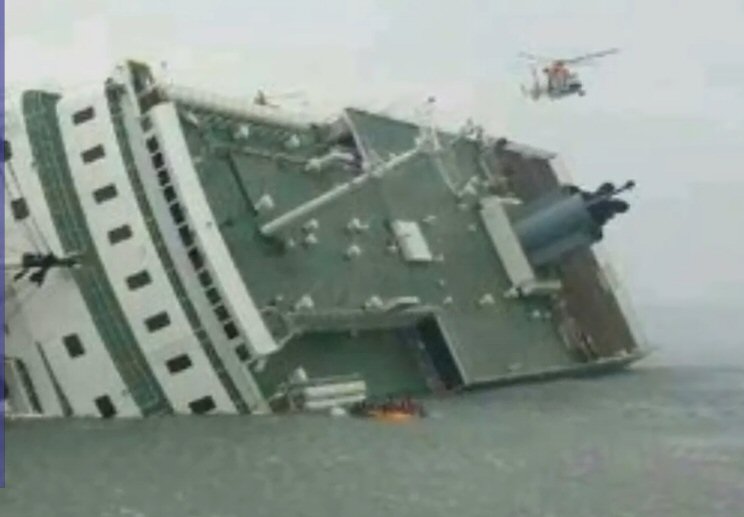
far view of above, but ship has rolled a little
more
Note just one resuce boat visible (near lifeboats)
and no passengers visible

At 80 degrees with top deck approaching the water
no rescue craft close by.
No not a single passenger or crew is visible in this
photo on the top or rear open deck, even on the open ends of the passenger
decks.
Were all outside people rescued by this point? Apparently
the nearly 300 who died are mostly still inside!
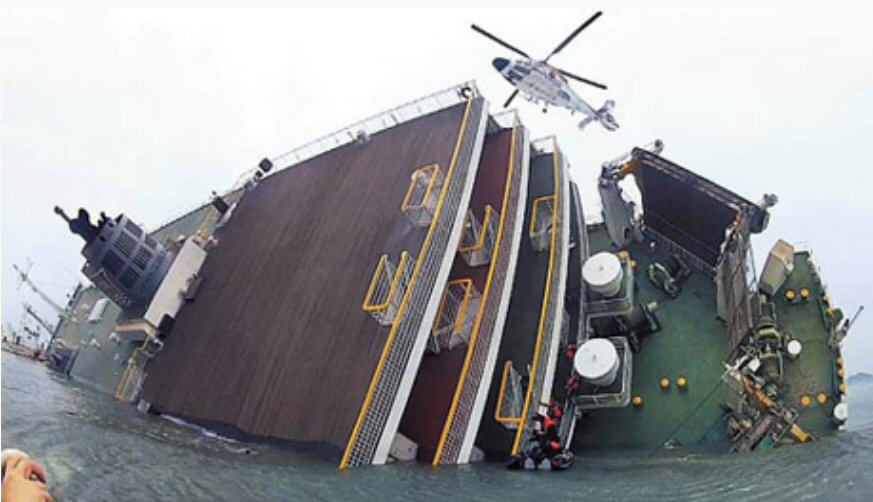
At 80 degrees virtually no one outside on decks (rear
view of ship)
Four passengers and one tiny boat visible lower right.
85 degrees
Ship is now
almost on its side.

half dozen passengers poking out on high side on deck
2
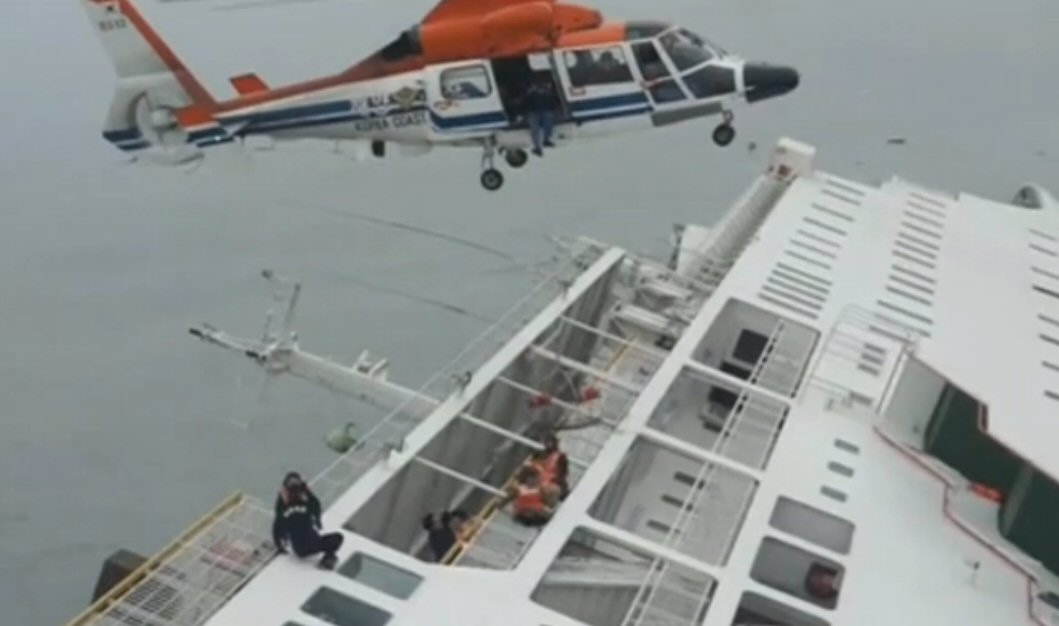
Tilt about 80 degrees,
just a few passengers on high side being rescued by
helicopter
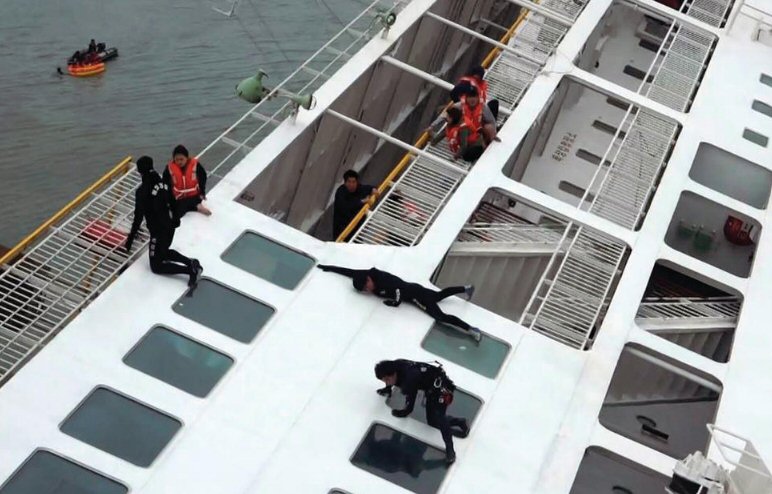
Only a handful of passengers high up when helicopters
are doing rescue
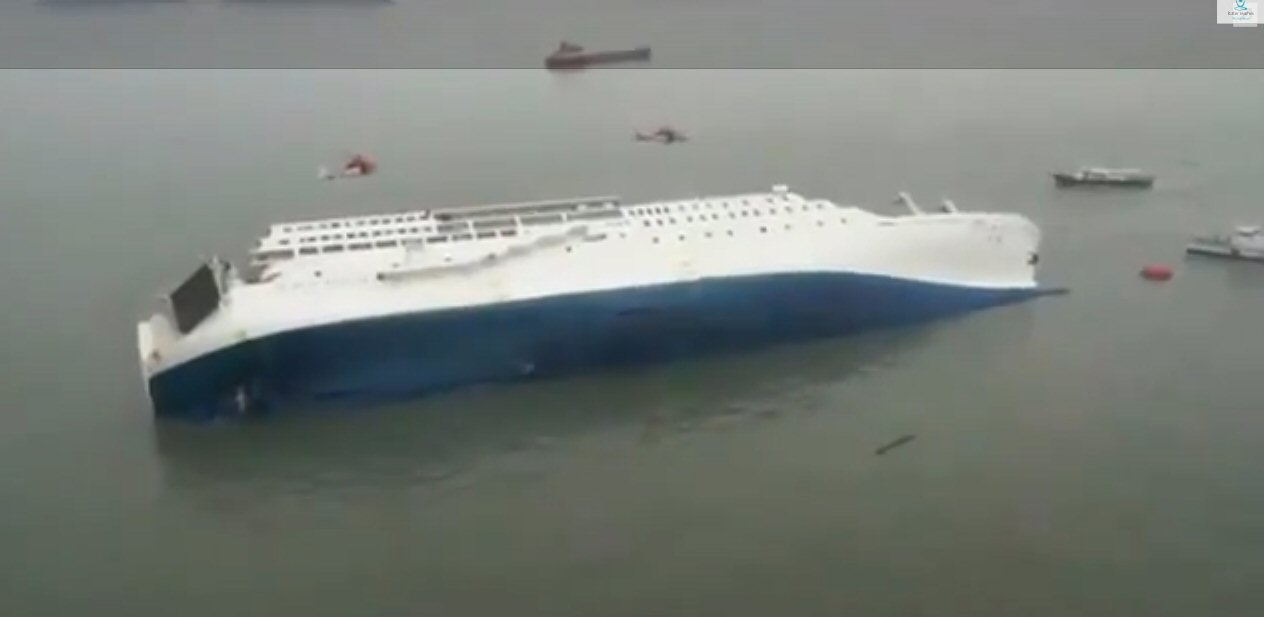
Very few rescue craft around at 80 degrees
135 degrees
Ship has now
rolled more than 90 degrees on its way to inverting. Pattern of the windows
and railing (below) shows the ship is partially inverted. In the
picture below the top deck is fully submerged, it is below the rescue boats.
Yet amazingly a bunch of people who made it to the high side of the ship
earlier are able to get out as the ship continues to roll and brings their
position down to the water's surface.
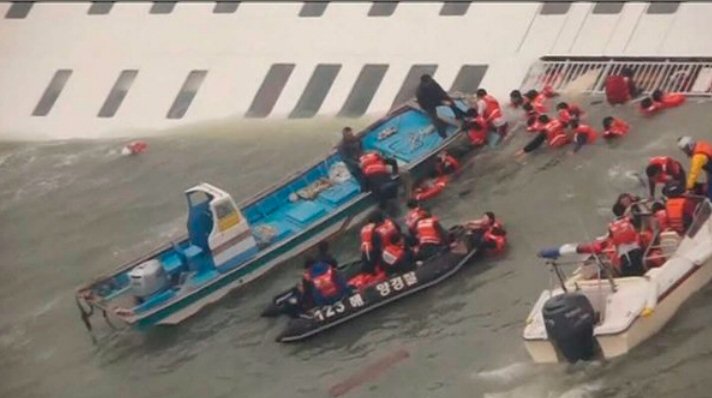
Many passengers still being picked up with ship tilt
at substantially more than 90 degrees!
Careful look shows the the top deck and 4th deck of
the ship already below water.
Roll angle here may be 135 degrees, five closely spaced
windows indicate this is deck 3 (of 4 decks)
Passengers here getting out just in time as the ship
is close to rolling over completely.
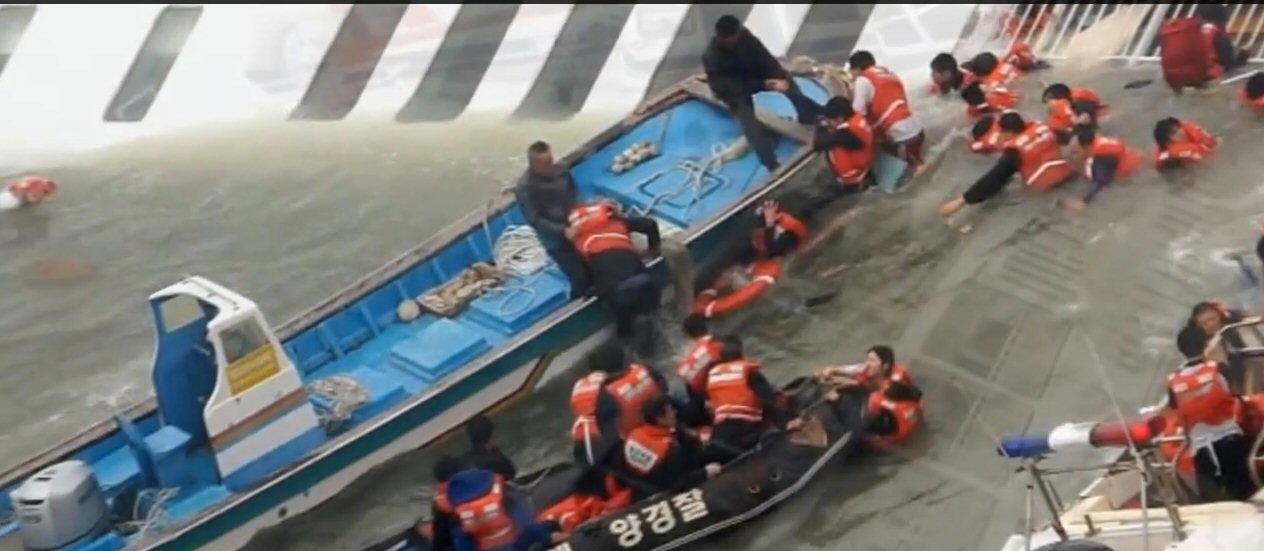

Picture shows a small group (15-20) rescued by three
small boats as the ship roll is about to take their deck underwater.
They were very likely on the high side and have ridden
the ship down as their deck apprached the sea at a roll angle of about
135 degrees.

Interesting picture (from view) because is shows some
cargo contains on the bow deck.
But there's only 15 or so visible of the 247 containers
on the manifest, and these must be lashed down.
I don't understand the manifest, or is it two different
manifests? (April 16 was the date of the accident)
Notice the orange rescue boat, near the wheelhouse,
the captain and mates are probably on board this boat.
Quite remarkable that no other rescue craft are anywhere
near the boat,
and remarkable that the front view (like the rear
view) of the ship shows NO passengers!
Is it possible the front deck was piled high, maybe even double stacked, with cargo container and most of them at this high roll have fallen off? No one has mentioned how containers were stacked. Would any contains float? Not a single container is visible floating in the water. Where are all the other contaners? From looking at the ship it seems to me they must be in the hole of the ship at the bow, or at least loaded at the bow. The bow must open up and the big boom in the center does the loading with excess piled on top. Notice if the hole really was packed, then how could they shift? It's more likely the cars and trucks in the midship might be able to tumble over to the side.
Reference pictures of the ship

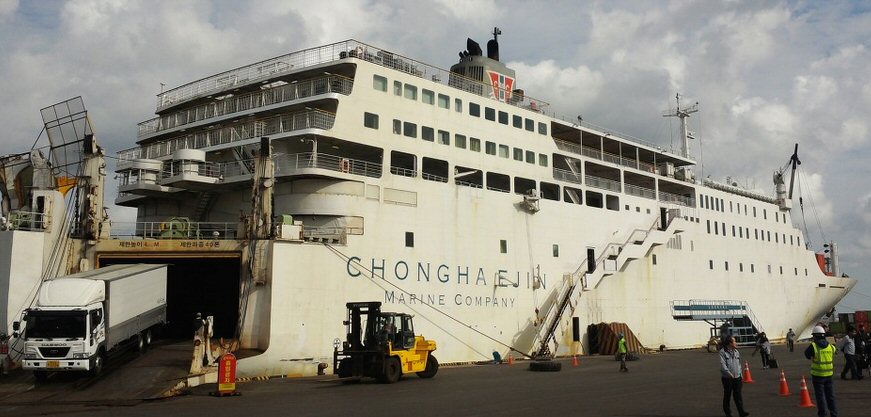
Notice how lower the opening for vehicles is than
the deck at the bow
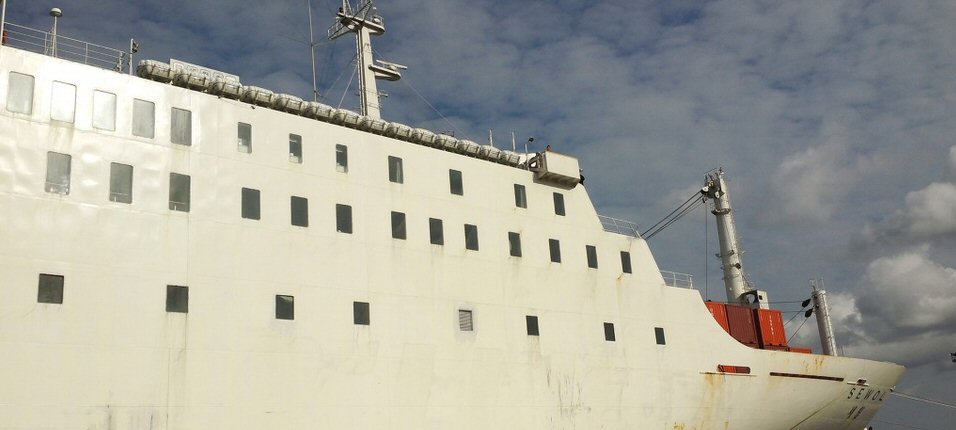
Rolled white things on top deck are probably life
rafts (14 x 2 = 28)
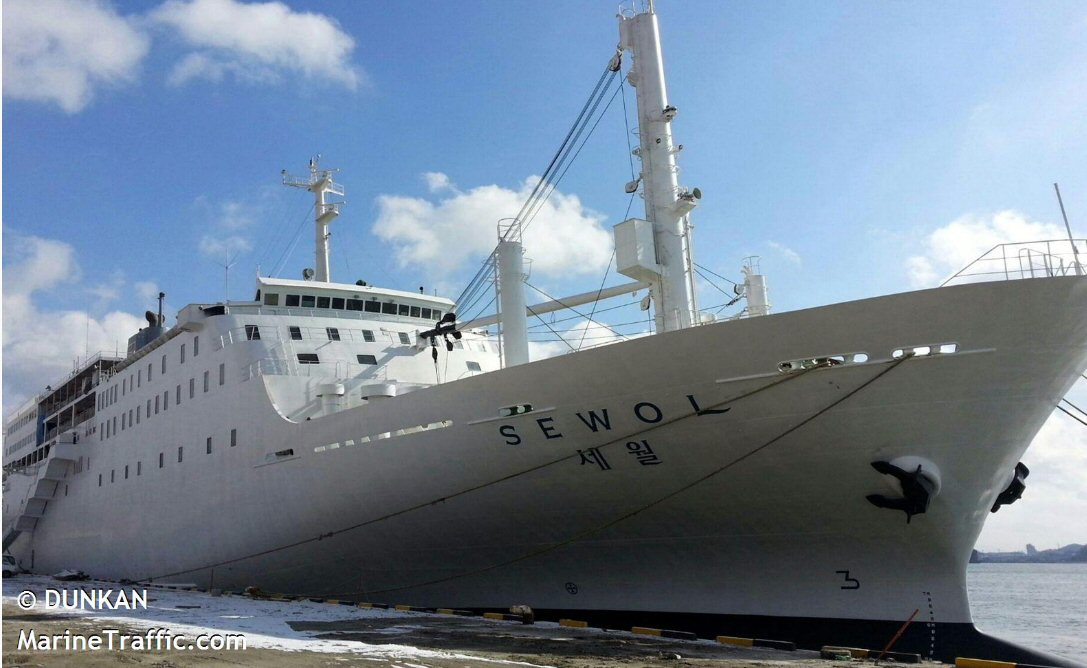
Big boom on the bow deck must be for loading cargo
containers
Staten Island ferry
For reference
here is one of the Staten Island ferries, which I am quite familar with.
This ferry is about 300 ft compared to the 450 ft of the Korean ferry.
Staten Island ferry is a harbor ferry, not ocean going. Some Staten Island
ferries do carry cars, but this one is passengers only and even though
2/3rd the length (about same width) of the Korean ferry it is rated to
carry 6,000 passengers (max) vs 900 (max).
Note the top of the Staten Island ferry is pretty open too with what look like 20 tiny (red) life rafts (for 6,000 passengers!). Passengers are not allowed on top, and in fact I have no idea how to get up there. There just the wheelhouse, so there is probably one tine stairway in there. The same was probably true, I am guessing, for the Korean ferry, which would explain why no one is resuced from top (by boat when it dips into sea) except maybe a couple of crewmen.

Note the flat wide top deck with what look like 20
tiny (red) life rafts
I have been on this ferry many times, but passengers
are not allowed on top.
What caused the accident? (4/24/14)
One very strange
thing about this accident is there is no clear cut cause (trigger). The
consensus is that the ship didn't hit anything. There is talk of a sudden
turn being made, but why? I find it very frustrating that no testimony
of the person steering the ship has leaked out. Also I have seen no tracking
data showing the ship' course. However, two things have come out that seem
suspicious and seem to fit with known facts.
1) Ship was rebuilt a couple of year ago, when it was sold and renamed. The rebuild added several passenger decks on top. In other words the design and its construction, possibly affecting both its stability and structural integrity, has been played with since it left the ship yard. The added upper decks raised the center of mass of the ship and increased its weight.The only thing that seems to make any sense here is that during a turn of the ship (was it turning? why? planned or obstacle?) cargo or vehicles shifted quickly and substantially Not only did everyone heard a loud bang, but there was also a shock through the boat that threw one of the mates sleeping out of his bed. He said he immediately in his bare feet and headed to the wheel house, but had trouble walking, which seems to indicate the ship just suddenly lurched over. Passengers seem to say the same thing, they immediately (or within a couple of minutes) thought they were sinking, so they must have felt the ship listing.-- Confirming: "Detained crew members told investigators that the ship was unstable and difficult to steer."
-- Confirming: "The third mate, who was at the helm of the ship when Lee left, said he (it was a girl) did not make a sharp turn.
Rather, he said, "the steering turned much more than usual."
-- Confirming: Former captain of the ship said that since the ship was rebuilt it has been unstable.2) This ship was a combined cargo and passenger ship, and the data shows it was hugely overloaded. It was rated to carry about 1,000 tons of cargo, but was loaded with 3,600 tons, more than triple it rated capacity. Have seen no analysis of what this would do to the stability of the ship, in particular it tendency to roll. Also I have seen no discussion of where the cargo containers go. If they are below the waterline, I would think it would act as ballast and stabilize the ship, but it if up with the vehicles, destabilize it.
-- Confirming: There's little doubt that the problem started with a bang and the ship almost instantly starting to roll. If it didn't hit anything, or structurally come apart (no one has suggested this, and apparently no one saw evidence of anything looking at the upturned hull before the ship sank.
It does remind me of the big cargo plane taking off from an airport in Afghanistan that was caught on video suddenly lurching upward causing it to stall and pancake to the ground killing everyone. The cause of that accident was thought to be a shifting of the cargo in the plane rearward, and in seconds this shift in the center of mass caused the plane to be unflyable and fall from the sky.All this talk of cargo shift as a cause of the accident just brings up a raft of questions, all of which are unanswered:
-- Was there a bunch of cargo containers stacked in some perilously manner, up high, double stacked, on a weak deck, etc, something that might have structurally failed causing all this weight to come crashing down causing the bang, shock, and lurch? Seen nothing on where or how the cargo was stacked.
-- Did all the excess cargo raise the center of the mass making it all the more likely to roll? There can be little doublt that all the cars and trucks were above the waterline, and most of the cargo contains were in the hole. But look in the photos how high the bow deck is above the water line. This is where cargo is loaded, much of the cargo must be below this deck, so if the hole was full, seems to me much of the cargo container would have been above the waterline too. Then there is the further matter of the weight of the contains, high or low? You can put anything in these containers, so there must be a big variation in their weight. I have seen no specifics on this, no breakdown of the weight of the containers vs the vehicles.
-- Ok let's assume the center of mass shifted causing the boat to lurch some angle to the side. Why does the roll continue? Does the first cargo induced roll drag something underwater? How and where does water get in?
Amazing I have seen no naval architects step up with an analysis here, or even a reasonable suggestion. In the first days when it was thought the ship hit something tearing open its buoyancy tanks this was not on table, but since the coast guard and Wiki says a consensus is that the ship didn't hit anything, then how and why does it start taking on water. Based on what happened with the ferry sinking in the Baltic 20 years ago, I would say the obvious weakness in the hull would be the large opening for vehicles to enter. How cargo is loaded no idea, again see nothing about this.
Or is it possible that the cargo crashing down (or over) did structural damage to the ship, affecting negatively its watertight hull?
-- This brings
up an interesting question. In the first 5 or 10 minutes after the big
thud and bang that everyone heard and felt didn't the crew run around,
on their own or ordered by the bridge, to see that the hell had happened?
If vehicles had tumbled to the side, which some newpaper in a graphic showed,
then this would be blindly obvious. In any ferry cars and trucks
are driven in and parked in a huge open area on the first level, the cars
can be seen driving into this ferry on one of the photos. Freight container
down in the hole might be a lot harder to check on. I have seen nothing
reported in the crew interviews about this. (Could be that this is because
99% of the reporting is in Korean and all we get in english is headline
summaries.)